The Glass Ceiling Effect: Perceptions of Corporate Employees
VerifiedAdded on 2019/10/01
|55
|13505
|40
Report
AI Summary
Researchers Tukonic and Harwood (2016) explored the glass ceiling effect on early years educators' sense of professionalism. Williams (2014) applied organizational learning as a framework for overcoming glass ceiling effects in higher education. Worthen and Baker (2016) examined the glass ceiling phenomenon in women's bodybuilding, highlighting its impact on female muscularity. The survey questionnaire and data provided insight into gender-based bias, career challenges, and support mechanisms for women in the corporate world.
Contribute Materials
Your contribution can guide someone’s learning journey. Share your
documents today.
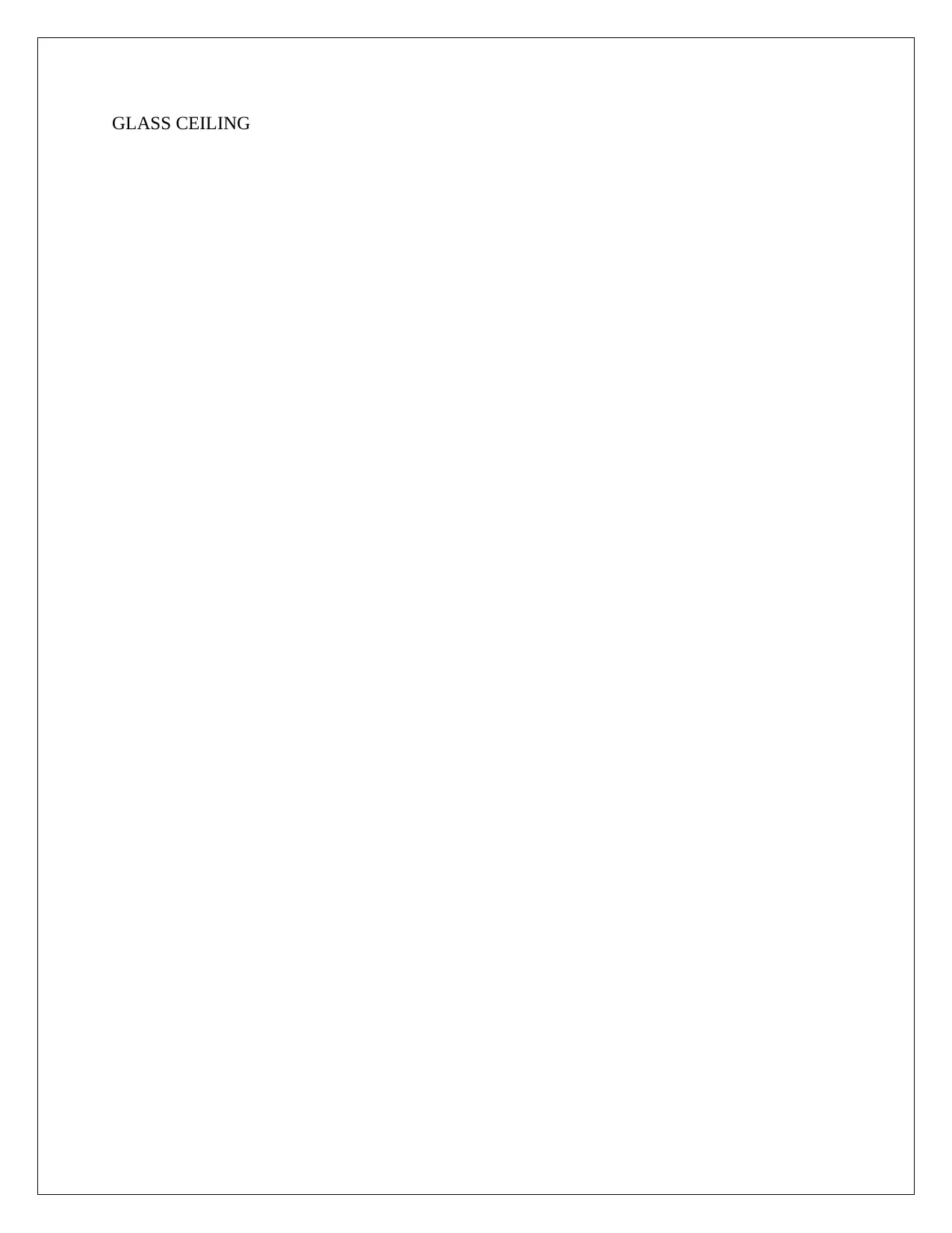
GLASS CEILING
Secure Best Marks with AI Grader
Need help grading? Try our AI Grader for instant feedback on your assignments.
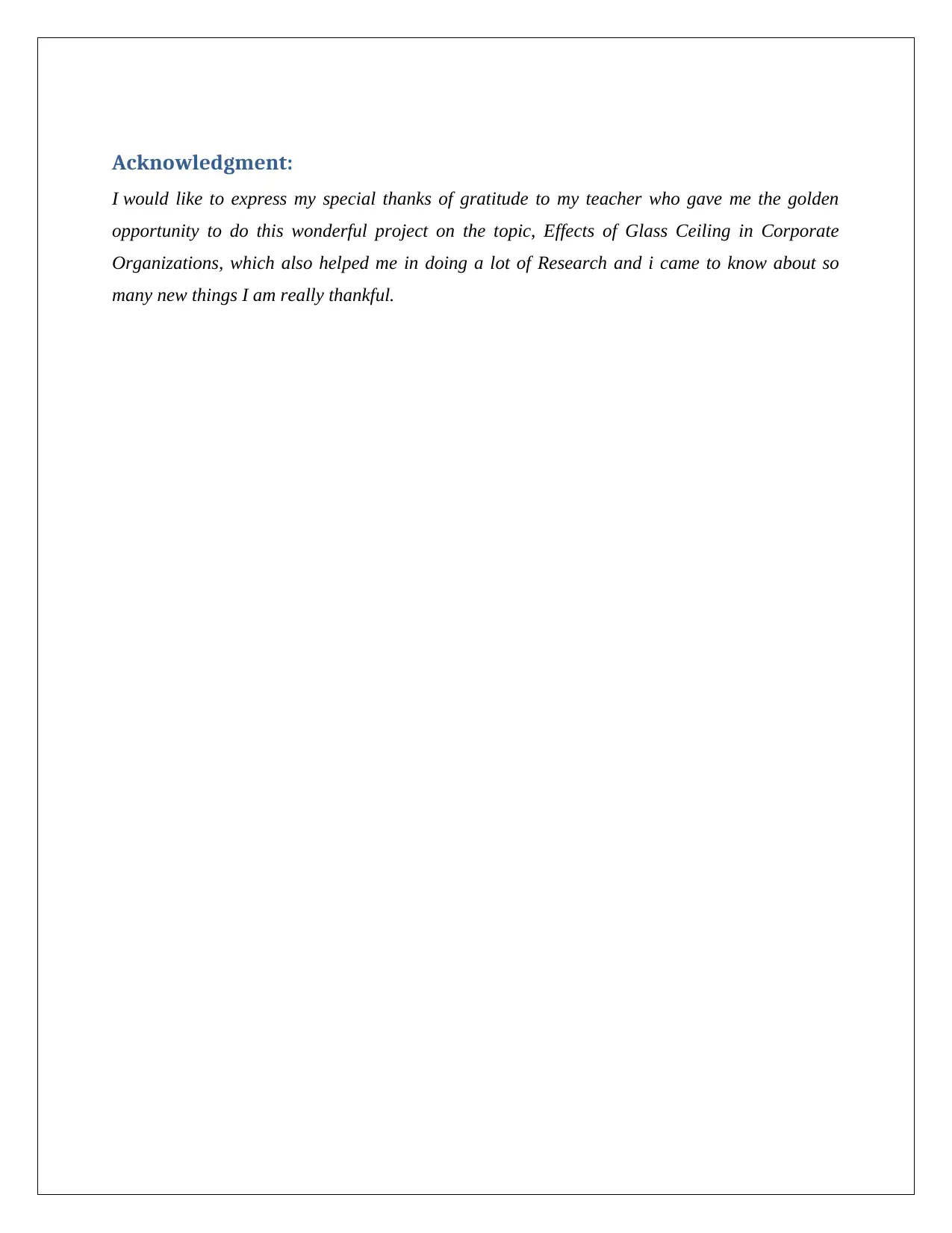
Acknowledgment:
I would like to express my special thanks of gratitude to my teacher who gave me the golden
opportunity to do this wonderful project on the topic, Effects of Glass Ceiling in Corporate
Organizations, which also helped me in doing a lot of Research and i came to know about so
many new things I am really thankful.
I would like to express my special thanks of gratitude to my teacher who gave me the golden
opportunity to do this wonderful project on the topic, Effects of Glass Ceiling in Corporate
Organizations, which also helped me in doing a lot of Research and i came to know about so
many new things I am really thankful.
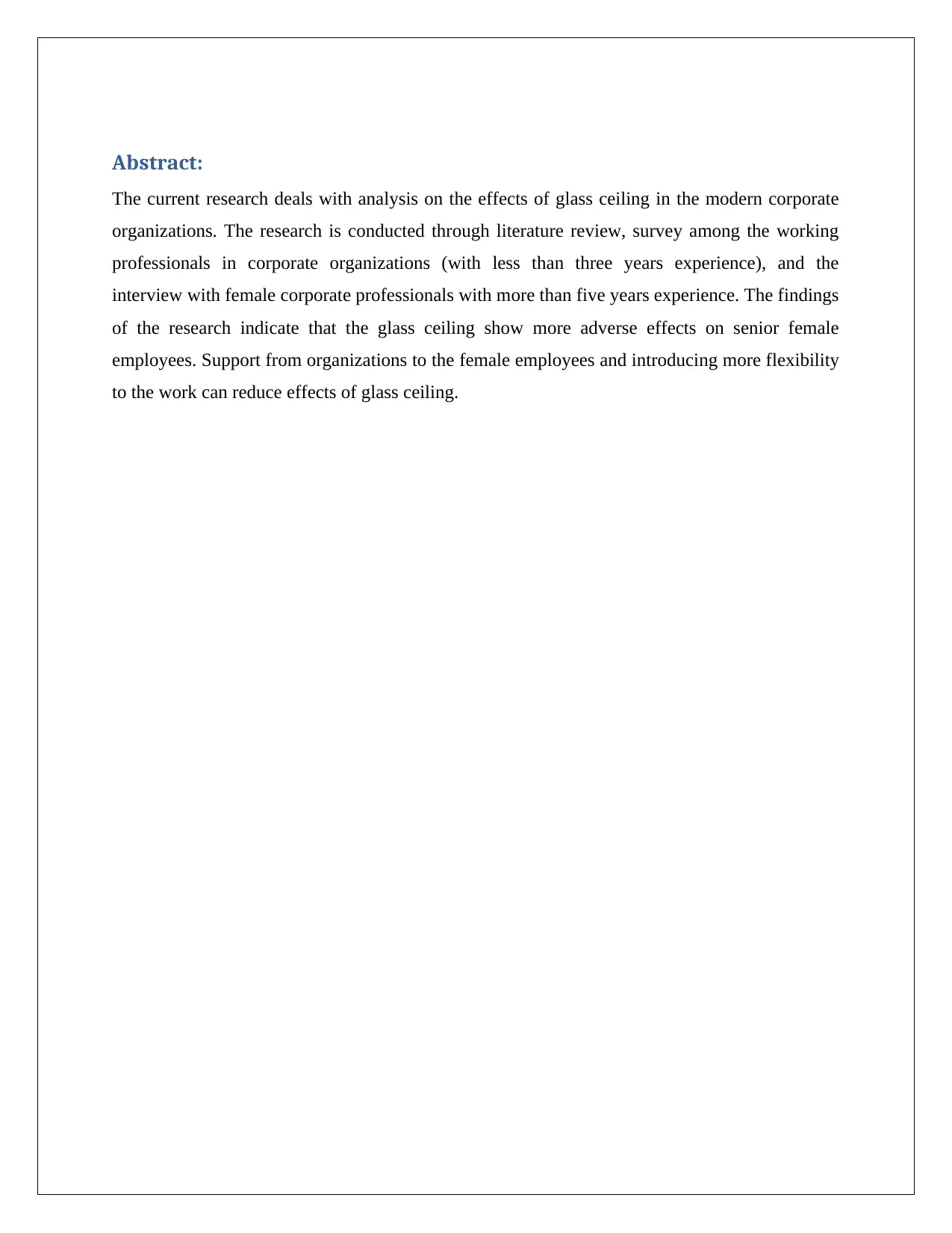
Abstract:
The current research deals with analysis on the effects of glass ceiling in the modern corporate
organizations. The research is conducted through literature review, survey among the working
professionals in corporate organizations (with less than three years experience), and the
interview with female corporate professionals with more than five years experience. The findings
of the research indicate that the glass ceiling show more adverse effects on senior female
employees. Support from organizations to the female employees and introducing more flexibility
to the work can reduce effects of glass ceiling.
The current research deals with analysis on the effects of glass ceiling in the modern corporate
organizations. The research is conducted through literature review, survey among the working
professionals in corporate organizations (with less than three years experience), and the
interview with female corporate professionals with more than five years experience. The findings
of the research indicate that the glass ceiling show more adverse effects on senior female
employees. Support from organizations to the female employees and introducing more flexibility
to the work can reduce effects of glass ceiling.

Table of Contents
Acknowledgment:............................................................................................................................2
Abstract:...........................................................................................................................................3
Chapter1...........................................................................................................................................9
1.Introduction:.................................................................................................................................9
1.1 Background of the research:......................................................................................................9
1.2 Research aim and objectives:...................................................................................................11
1.2.1 Aim of the research:..............................................................................................................11
1.2.2 Objectives of the research:....................................................................................................12
1.2.3 Research questions:..............................................................................................................12
1.3 Structure of the report:.............................................................................................................12
Chapter 1:...................................................................................................................................12
Chapter 2:...................................................................................................................................12
Chapter 3:...................................................................................................................................12
Chapter 4:...................................................................................................................................13
Chapter 5:...................................................................................................................................13
Chapter 2: Literature Review.........................................................................................................14
2.1 Introduction:............................................................................................................................14
2.2 Glass ceiling in the modern organizations:..............................................................................14
2.3 Recognition of glass ceiling in modern organizations:............................................................17
2.4 Barriers for the progress of women at workplace:...................................................................18
2.5 Impact of glass ceiling on employee performance and satisfaction:.......................................19
2.6 Changing role of women in the Economy and effects of glass ceiling on the Economy:.......22
2.7 Conclusion:..............................................................................................................................24
2.8 Recommendations for further study:.......................................................................................25
Acknowledgment:............................................................................................................................2
Abstract:...........................................................................................................................................3
Chapter1...........................................................................................................................................9
1.Introduction:.................................................................................................................................9
1.1 Background of the research:......................................................................................................9
1.2 Research aim and objectives:...................................................................................................11
1.2.1 Aim of the research:..............................................................................................................11
1.2.2 Objectives of the research:....................................................................................................12
1.2.3 Research questions:..............................................................................................................12
1.3 Structure of the report:.............................................................................................................12
Chapter 1:...................................................................................................................................12
Chapter 2:...................................................................................................................................12
Chapter 3:...................................................................................................................................12
Chapter 4:...................................................................................................................................13
Chapter 5:...................................................................................................................................13
Chapter 2: Literature Review.........................................................................................................14
2.1 Introduction:............................................................................................................................14
2.2 Glass ceiling in the modern organizations:..............................................................................14
2.3 Recognition of glass ceiling in modern organizations:............................................................17
2.4 Barriers for the progress of women at workplace:...................................................................18
2.5 Impact of glass ceiling on employee performance and satisfaction:.......................................19
2.6 Changing role of women in the Economy and effects of glass ceiling on the Economy:.......22
2.7 Conclusion:..............................................................................................................................24
2.8 Recommendations for further study:.......................................................................................25
Secure Best Marks with AI Grader
Need help grading? Try our AI Grader for instant feedback on your assignments.
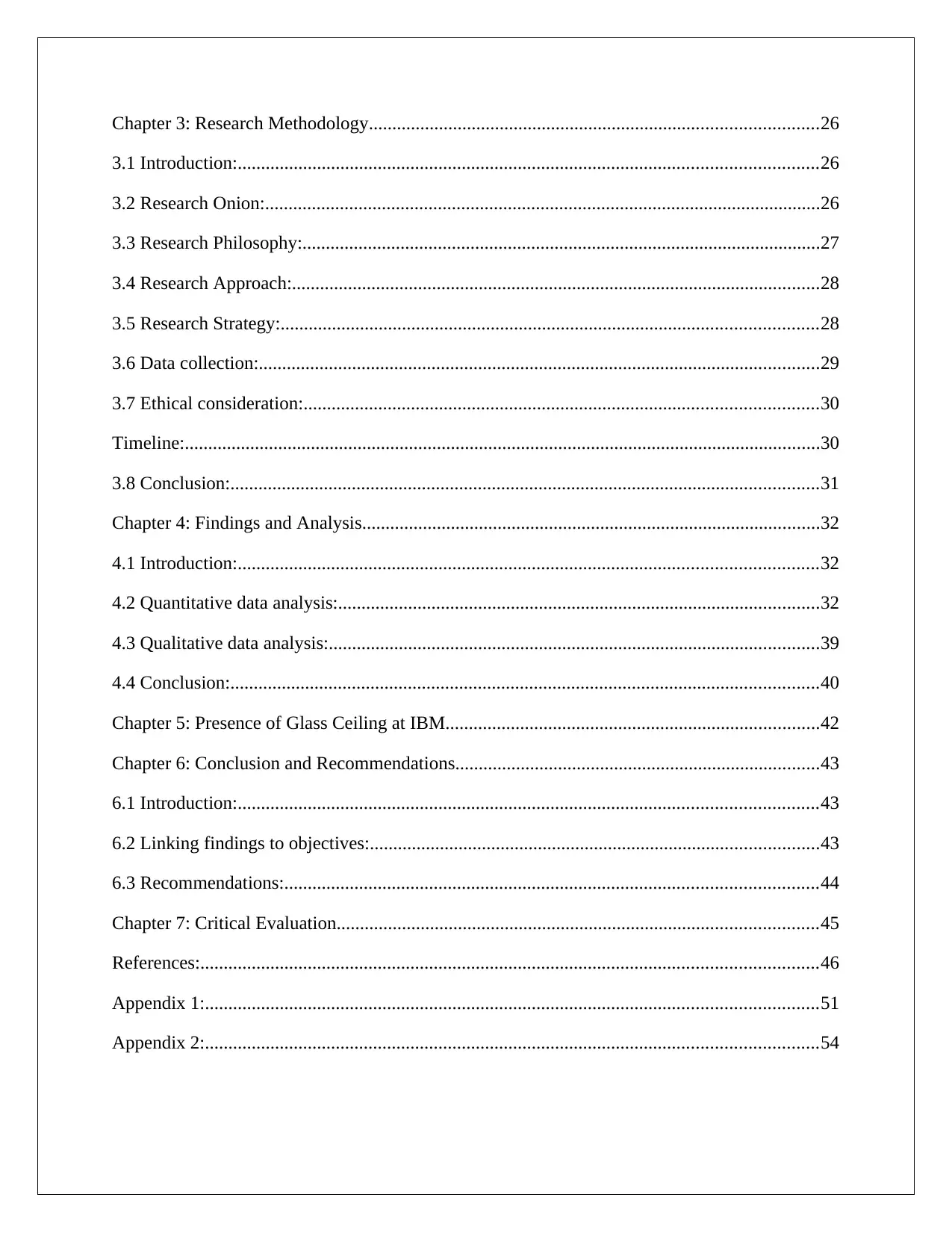
Chapter 3: Research Methodology................................................................................................26
3.1 Introduction:............................................................................................................................26
3.2 Research Onion:.......................................................................................................................26
3.3 Research Philosophy:...............................................................................................................27
3.4 Research Approach:.................................................................................................................28
3.5 Research Strategy:...................................................................................................................28
3.6 Data collection:........................................................................................................................29
3.7 Ethical consideration:..............................................................................................................30
Timeline:........................................................................................................................................30
3.8 Conclusion:..............................................................................................................................31
Chapter 4: Findings and Analysis..................................................................................................32
4.1 Introduction:............................................................................................................................32
4.2 Quantitative data analysis:.......................................................................................................32
4.3 Qualitative data analysis:.........................................................................................................39
4.4 Conclusion:..............................................................................................................................40
Chapter 5: Presence of Glass Ceiling at IBM................................................................................42
Chapter 6: Conclusion and Recommendations..............................................................................43
6.1 Introduction:............................................................................................................................43
6.2 Linking findings to objectives:................................................................................................43
6.3 Recommendations:..................................................................................................................44
Chapter 7: Critical Evaluation.......................................................................................................45
References:....................................................................................................................................46
Appendix 1:...................................................................................................................................51
Appendix 2:...................................................................................................................................54
3.1 Introduction:............................................................................................................................26
3.2 Research Onion:.......................................................................................................................26
3.3 Research Philosophy:...............................................................................................................27
3.4 Research Approach:.................................................................................................................28
3.5 Research Strategy:...................................................................................................................28
3.6 Data collection:........................................................................................................................29
3.7 Ethical consideration:..............................................................................................................30
Timeline:........................................................................................................................................30
3.8 Conclusion:..............................................................................................................................31
Chapter 4: Findings and Analysis..................................................................................................32
4.1 Introduction:............................................................................................................................32
4.2 Quantitative data analysis:.......................................................................................................32
4.3 Qualitative data analysis:.........................................................................................................39
4.4 Conclusion:..............................................................................................................................40
Chapter 5: Presence of Glass Ceiling at IBM................................................................................42
Chapter 6: Conclusion and Recommendations..............................................................................43
6.1 Introduction:............................................................................................................................43
6.2 Linking findings to objectives:................................................................................................43
6.3 Recommendations:..................................................................................................................44
Chapter 7: Critical Evaluation.......................................................................................................45
References:....................................................................................................................................46
Appendix 1:...................................................................................................................................51
Appendix 2:...................................................................................................................................54
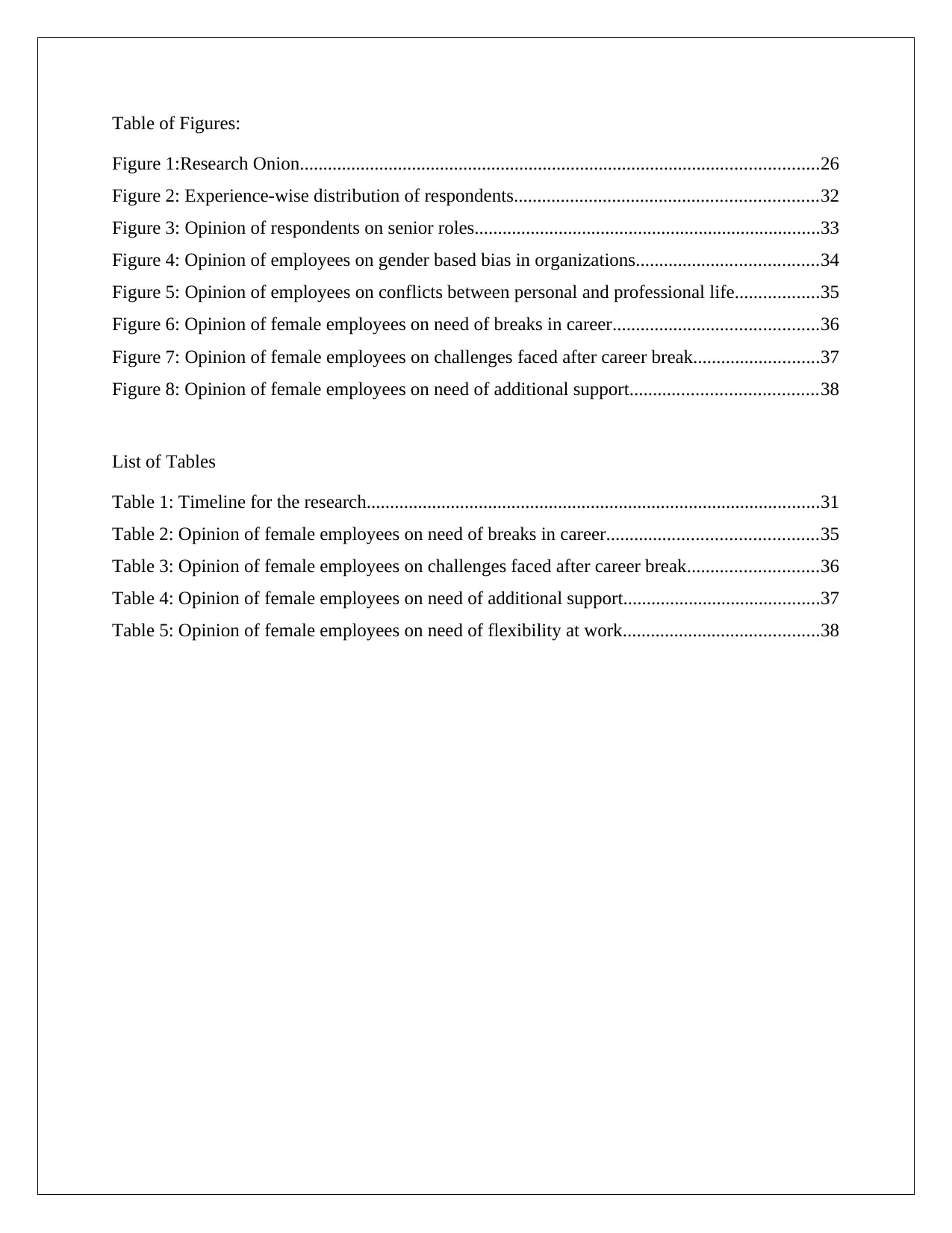
Table of Figures:
Figure 1:Research Onion...............................................................................................................26
Figure 2: Experience-wise distribution of respondents.................................................................32
Figure 3: Opinion of respondents on senior roles..........................................................................33
Figure 4: Opinion of employees on gender based bias in organizations.......................................34
Figure 5: Opinion of employees on conflicts between personal and professional life..................35
Figure 6: Opinion of female employees on need of breaks in career............................................36
Figure 7: Opinion of female employees on challenges faced after career break...........................37
Figure 8: Opinion of female employees on need of additional support........................................38
List of Tables
Table 1: Timeline for the research.................................................................................................31
Table 2: Opinion of female employees on need of breaks in career.............................................35
Table 3: Opinion of female employees on challenges faced after career break............................36
Table 4: Opinion of female employees on need of additional support..........................................37
Table 5: Opinion of female employees on need of flexibility at work..........................................38
Figure 1:Research Onion...............................................................................................................26
Figure 2: Experience-wise distribution of respondents.................................................................32
Figure 3: Opinion of respondents on senior roles..........................................................................33
Figure 4: Opinion of employees on gender based bias in organizations.......................................34
Figure 5: Opinion of employees on conflicts between personal and professional life..................35
Figure 6: Opinion of female employees on need of breaks in career............................................36
Figure 7: Opinion of female employees on challenges faced after career break...........................37
Figure 8: Opinion of female employees on need of additional support........................................38
List of Tables
Table 1: Timeline for the research.................................................................................................31
Table 2: Opinion of female employees on need of breaks in career.............................................35
Table 3: Opinion of female employees on challenges faced after career break............................36
Table 4: Opinion of female employees on need of additional support..........................................37
Table 5: Opinion of female employees on need of flexibility at work..........................................38
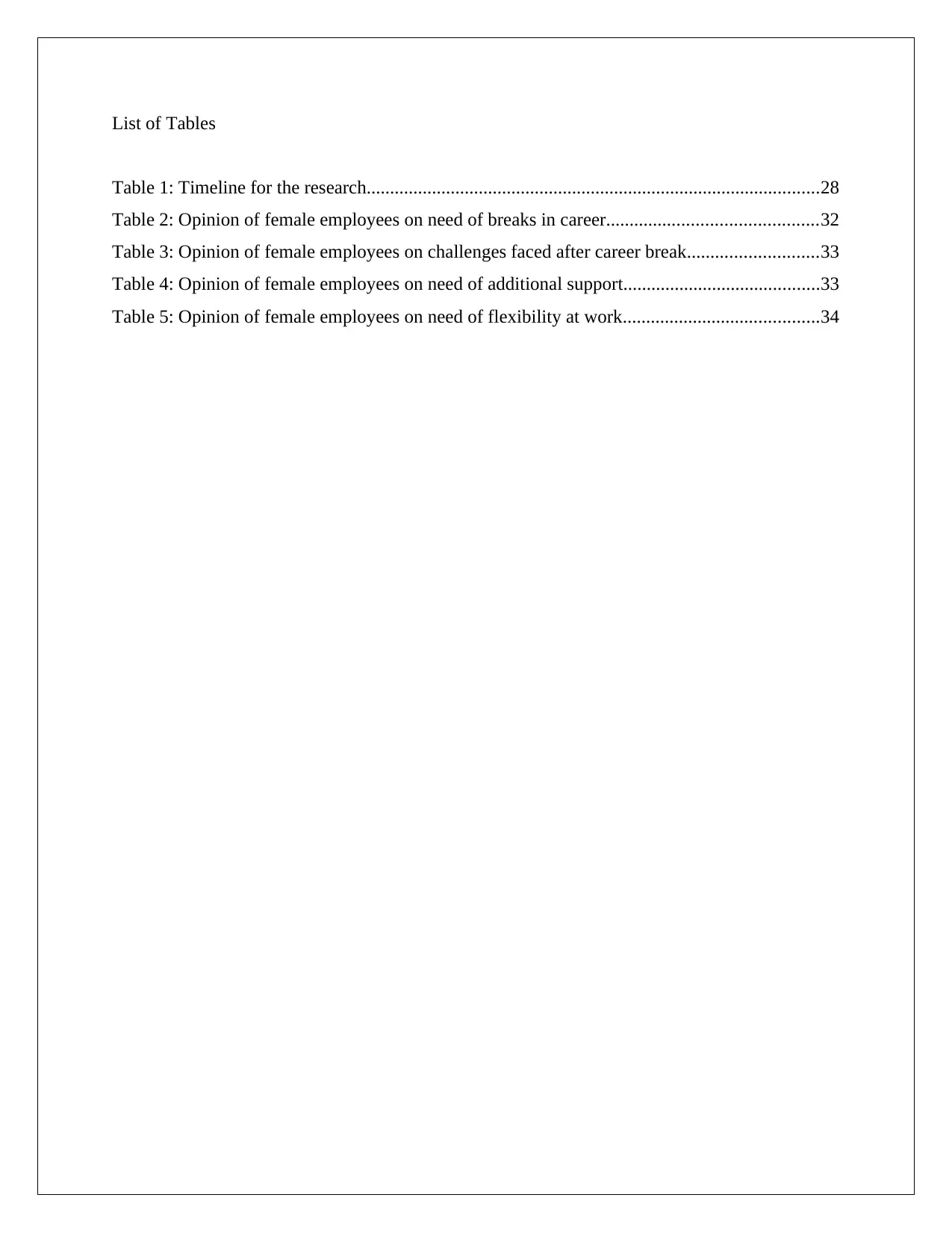
List of Tables
Table 1: Timeline for the research.................................................................................................28
Table 2: Opinion of female employees on need of breaks in career.............................................32
Table 3: Opinion of female employees on challenges faced after career break............................33
Table 4: Opinion of female employees on need of additional support..........................................33
Table 5: Opinion of female employees on need of flexibility at work..........................................34
Table 1: Timeline for the research.................................................................................................28
Table 2: Opinion of female employees on need of breaks in career.............................................32
Table 3: Opinion of female employees on challenges faced after career break............................33
Table 4: Opinion of female employees on need of additional support..........................................33
Table 5: Opinion of female employees on need of flexibility at work..........................................34
Paraphrase This Document
Need a fresh take? Get an instant paraphrase of this document with our AI Paraphraser
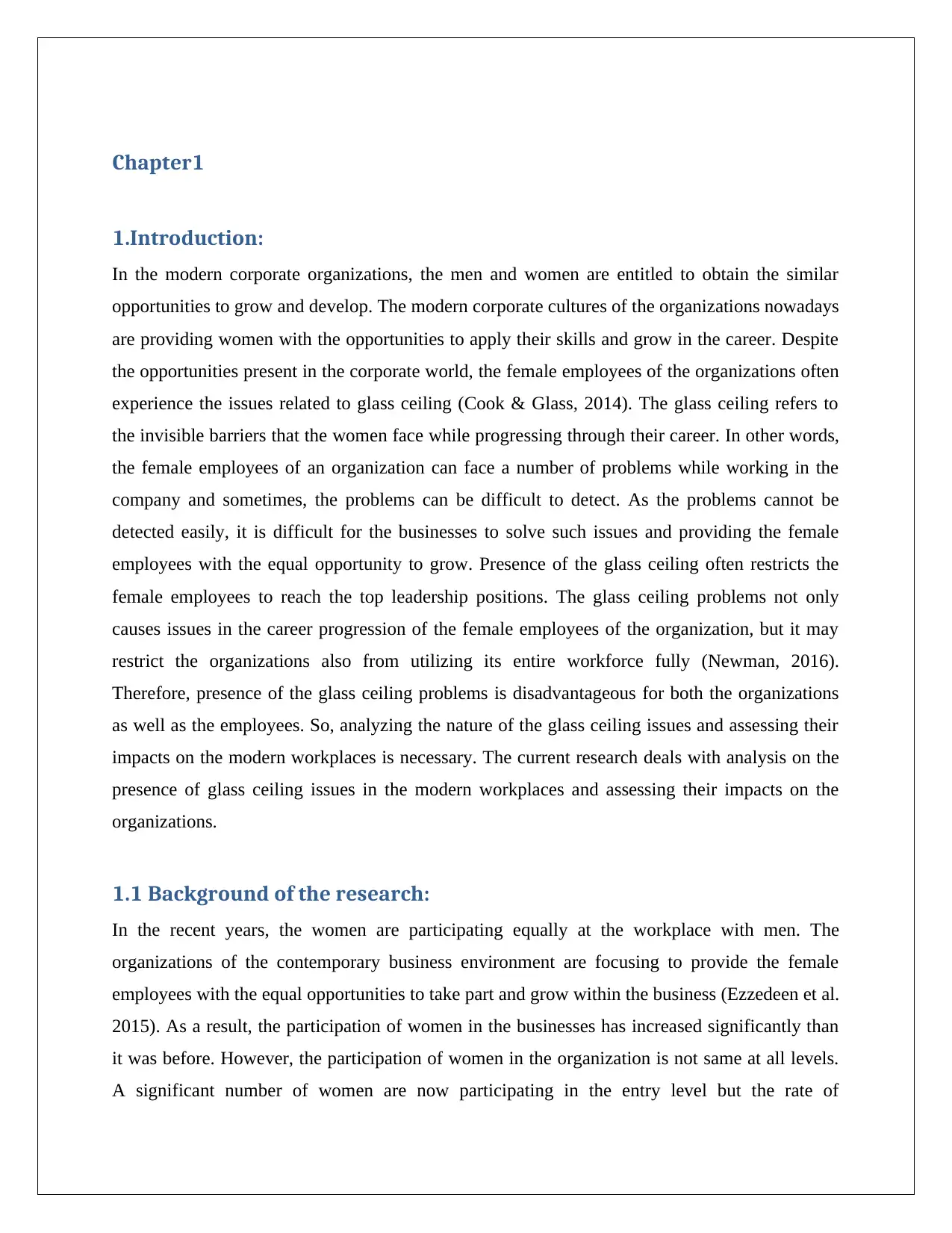
Chapter1
1.Introduction:
In the modern corporate organizations, the men and women are entitled to obtain the similar
opportunities to grow and develop. The modern corporate cultures of the organizations nowadays
are providing women with the opportunities to apply their skills and grow in the career. Despite
the opportunities present in the corporate world, the female employees of the organizations often
experience the issues related to glass ceiling (Cook & Glass, 2014). The glass ceiling refers to
the invisible barriers that the women face while progressing through their career. In other words,
the female employees of an organization can face a number of problems while working in the
company and sometimes, the problems can be difficult to detect. As the problems cannot be
detected easily, it is difficult for the businesses to solve such issues and providing the female
employees with the equal opportunity to grow. Presence of the glass ceiling often restricts the
female employees to reach the top leadership positions. The glass ceiling problems not only
causes issues in the career progression of the female employees of the organization, but it may
restrict the organizations also from utilizing its entire workforce fully (Newman, 2016).
Therefore, presence of the glass ceiling problems is disadvantageous for both the organizations
as well as the employees. So, analyzing the nature of the glass ceiling issues and assessing their
impacts on the modern workplaces is necessary. The current research deals with analysis on the
presence of glass ceiling issues in the modern workplaces and assessing their impacts on the
organizations.
1.1 Background of the research:
In the recent years, the women are participating equally at the workplace with men. The
organizations of the contemporary business environment are focusing to provide the female
employees with the equal opportunities to take part and grow within the business (Ezzedeen et al.
2015). As a result, the participation of women in the businesses has increased significantly than
it was before. However, the participation of women in the organization is not same at all levels.
A significant number of women are now participating in the entry level but the rate of
1.Introduction:
In the modern corporate organizations, the men and women are entitled to obtain the similar
opportunities to grow and develop. The modern corporate cultures of the organizations nowadays
are providing women with the opportunities to apply their skills and grow in the career. Despite
the opportunities present in the corporate world, the female employees of the organizations often
experience the issues related to glass ceiling (Cook & Glass, 2014). The glass ceiling refers to
the invisible barriers that the women face while progressing through their career. In other words,
the female employees of an organization can face a number of problems while working in the
company and sometimes, the problems can be difficult to detect. As the problems cannot be
detected easily, it is difficult for the businesses to solve such issues and providing the female
employees with the equal opportunity to grow. Presence of the glass ceiling often restricts the
female employees to reach the top leadership positions. The glass ceiling problems not only
causes issues in the career progression of the female employees of the organization, but it may
restrict the organizations also from utilizing its entire workforce fully (Newman, 2016).
Therefore, presence of the glass ceiling problems is disadvantageous for both the organizations
as well as the employees. So, analyzing the nature of the glass ceiling issues and assessing their
impacts on the modern workplaces is necessary. The current research deals with analysis on the
presence of glass ceiling issues in the modern workplaces and assessing their impacts on the
organizations.
1.1 Background of the research:
In the recent years, the women are participating equally at the workplace with men. The
organizations of the contemporary business environment are focusing to provide the female
employees with the equal opportunities to take part and grow within the business (Ezzedeen et al.
2015). As a result, the participation of women in the businesses has increased significantly than
it was before. However, the participation of women in the organization is not same at all levels.
A significant number of women are now participating in the entry level but the rate of
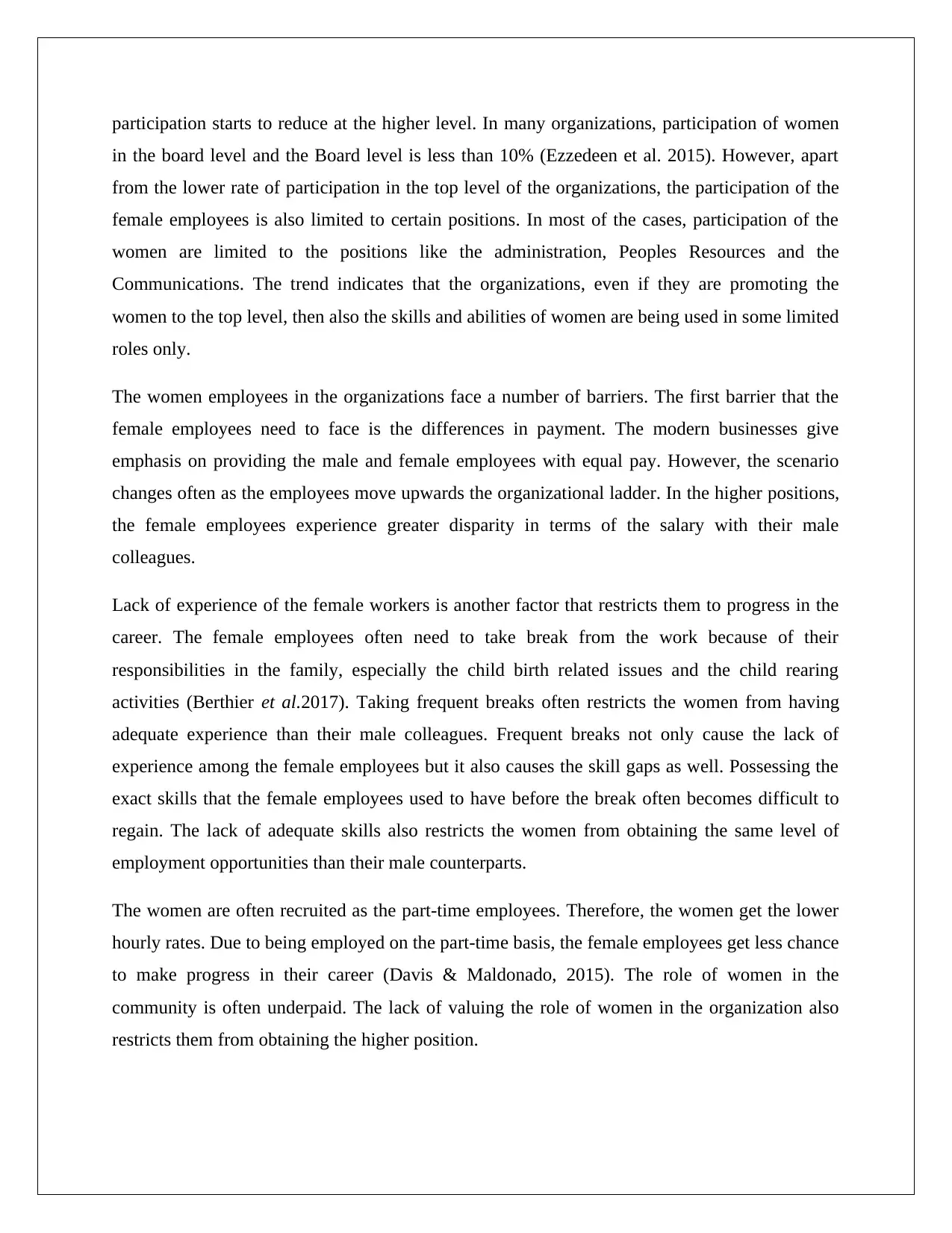
participation starts to reduce at the higher level. In many organizations, participation of women
in the board level and the Board level is less than 10% (Ezzedeen et al. 2015). However, apart
from the lower rate of participation in the top level of the organizations, the participation of the
female employees is also limited to certain positions. In most of the cases, participation of the
women are limited to the positions like the administration, Peoples Resources and the
Communications. The trend indicates that the organizations, even if they are promoting the
women to the top level, then also the skills and abilities of women are being used in some limited
roles only.
The women employees in the organizations face a number of barriers. The first barrier that the
female employees need to face is the differences in payment. The modern businesses give
emphasis on providing the male and female employees with equal pay. However, the scenario
changes often as the employees move upwards the organizational ladder. In the higher positions,
the female employees experience greater disparity in terms of the salary with their male
colleagues.
Lack of experience of the female workers is another factor that restricts them to progress in the
career. The female employees often need to take break from the work because of their
responsibilities in the family, especially the child birth related issues and the child rearing
activities (Berthier et al.2017). Taking frequent breaks often restricts the women from having
adequate experience than their male colleagues. Frequent breaks not only cause the lack of
experience among the female employees but it also causes the skill gaps as well. Possessing the
exact skills that the female employees used to have before the break often becomes difficult to
regain. The lack of adequate skills also restricts the women from obtaining the same level of
employment opportunities than their male counterparts.
The women are often recruited as the part-time employees. Therefore, the women get the lower
hourly rates. Due to being employed on the part-time basis, the female employees get less chance
to make progress in their career (Davis & Maldonado, 2015). The role of women in the
community is often underpaid. The lack of valuing the role of women in the organization also
restricts them from obtaining the higher position.
in the board level and the Board level is less than 10% (Ezzedeen et al. 2015). However, apart
from the lower rate of participation in the top level of the organizations, the participation of the
female employees is also limited to certain positions. In most of the cases, participation of the
women are limited to the positions like the administration, Peoples Resources and the
Communications. The trend indicates that the organizations, even if they are promoting the
women to the top level, then also the skills and abilities of women are being used in some limited
roles only.
The women employees in the organizations face a number of barriers. The first barrier that the
female employees need to face is the differences in payment. The modern businesses give
emphasis on providing the male and female employees with equal pay. However, the scenario
changes often as the employees move upwards the organizational ladder. In the higher positions,
the female employees experience greater disparity in terms of the salary with their male
colleagues.
Lack of experience of the female workers is another factor that restricts them to progress in the
career. The female employees often need to take break from the work because of their
responsibilities in the family, especially the child birth related issues and the child rearing
activities (Berthier et al.2017). Taking frequent breaks often restricts the women from having
adequate experience than their male colleagues. Frequent breaks not only cause the lack of
experience among the female employees but it also causes the skill gaps as well. Possessing the
exact skills that the female employees used to have before the break often becomes difficult to
regain. The lack of adequate skills also restricts the women from obtaining the same level of
employment opportunities than their male counterparts.
The women are often recruited as the part-time employees. Therefore, the women get the lower
hourly rates. Due to being employed on the part-time basis, the female employees get less chance
to make progress in their career (Davis & Maldonado, 2015). The role of women in the
community is often underpaid. The lack of valuing the role of women in the organization also
restricts them from obtaining the higher position.
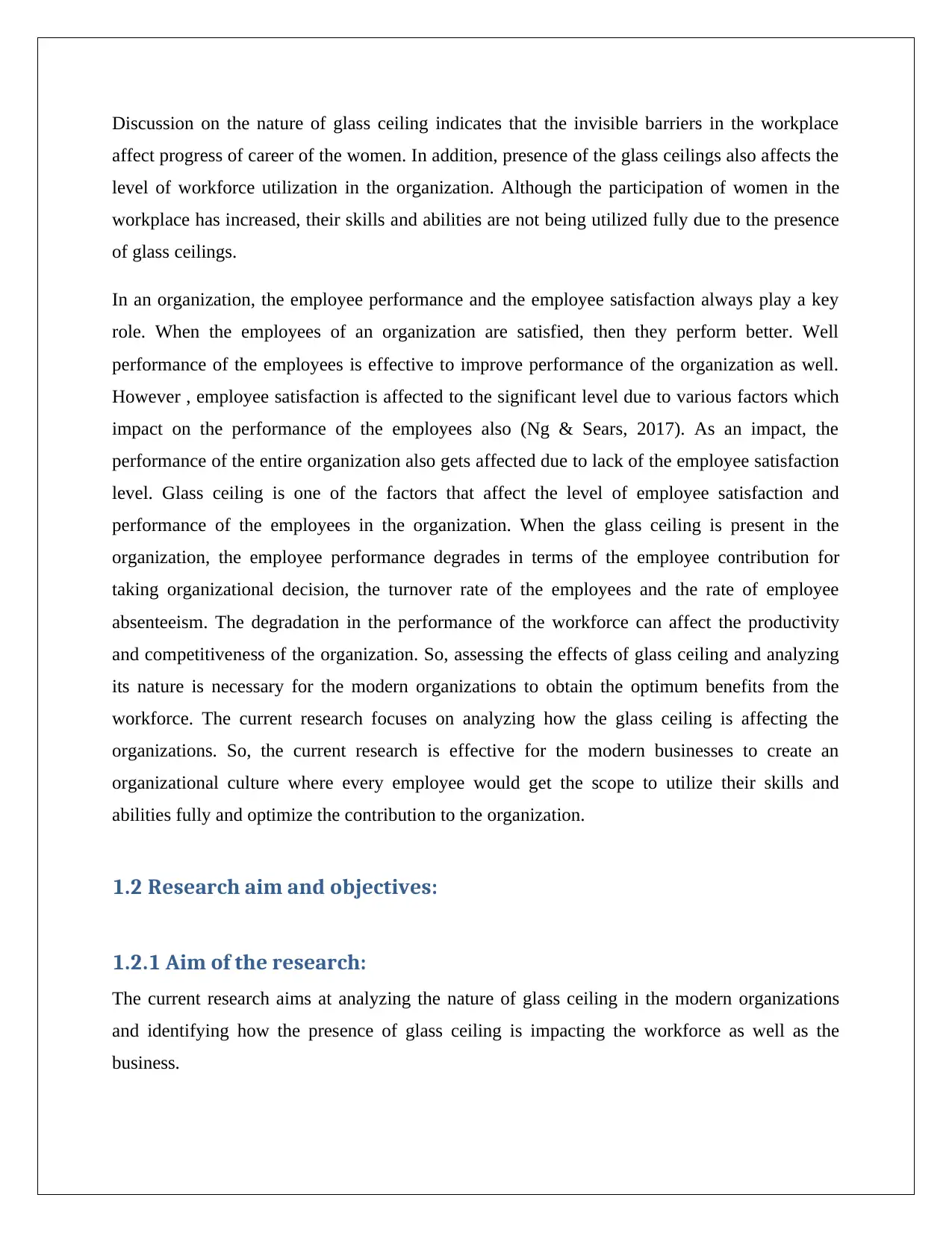
Discussion on the nature of glass ceiling indicates that the invisible barriers in the workplace
affect progress of career of the women. In addition, presence of the glass ceilings also affects the
level of workforce utilization in the organization. Although the participation of women in the
workplace has increased, their skills and abilities are not being utilized fully due to the presence
of glass ceilings.
In an organization, the employee performance and the employee satisfaction always play a key
role. When the employees of an organization are satisfied, then they perform better. Well
performance of the employees is effective to improve performance of the organization as well.
However , employee satisfaction is affected to the significant level due to various factors which
impact on the performance of the employees also (Ng & Sears, 2017). As an impact, the
performance of the entire organization also gets affected due to lack of the employee satisfaction
level. Glass ceiling is one of the factors that affect the level of employee satisfaction and
performance of the employees in the organization. When the glass ceiling is present in the
organization, the employee performance degrades in terms of the employee contribution for
taking organizational decision, the turnover rate of the employees and the rate of employee
absenteeism. The degradation in the performance of the workforce can affect the productivity
and competitiveness of the organization. So, assessing the effects of glass ceiling and analyzing
its nature is necessary for the modern organizations to obtain the optimum benefits from the
workforce. The current research focuses on analyzing how the glass ceiling is affecting the
organizations. So, the current research is effective for the modern businesses to create an
organizational culture where every employee would get the scope to utilize their skills and
abilities fully and optimize the contribution to the organization.
1.2 Research aim and objectives:
1.2.1 Aim of the research:
The current research aims at analyzing the nature of glass ceiling in the modern organizations
and identifying how the presence of glass ceiling is impacting the workforce as well as the
business.
affect progress of career of the women. In addition, presence of the glass ceilings also affects the
level of workforce utilization in the organization. Although the participation of women in the
workplace has increased, their skills and abilities are not being utilized fully due to the presence
of glass ceilings.
In an organization, the employee performance and the employee satisfaction always play a key
role. When the employees of an organization are satisfied, then they perform better. Well
performance of the employees is effective to improve performance of the organization as well.
However , employee satisfaction is affected to the significant level due to various factors which
impact on the performance of the employees also (Ng & Sears, 2017). As an impact, the
performance of the entire organization also gets affected due to lack of the employee satisfaction
level. Glass ceiling is one of the factors that affect the level of employee satisfaction and
performance of the employees in the organization. When the glass ceiling is present in the
organization, the employee performance degrades in terms of the employee contribution for
taking organizational decision, the turnover rate of the employees and the rate of employee
absenteeism. The degradation in the performance of the workforce can affect the productivity
and competitiveness of the organization. So, assessing the effects of glass ceiling and analyzing
its nature is necessary for the modern organizations to obtain the optimum benefits from the
workforce. The current research focuses on analyzing how the glass ceiling is affecting the
organizations. So, the current research is effective for the modern businesses to create an
organizational culture where every employee would get the scope to utilize their skills and
abilities fully and optimize the contribution to the organization.
1.2 Research aim and objectives:
1.2.1 Aim of the research:
The current research aims at analyzing the nature of glass ceiling in the modern organizations
and identifying how the presence of glass ceiling is impacting the workforce as well as the
business.
Secure Best Marks with AI Grader
Need help grading? Try our AI Grader for instant feedback on your assignments.
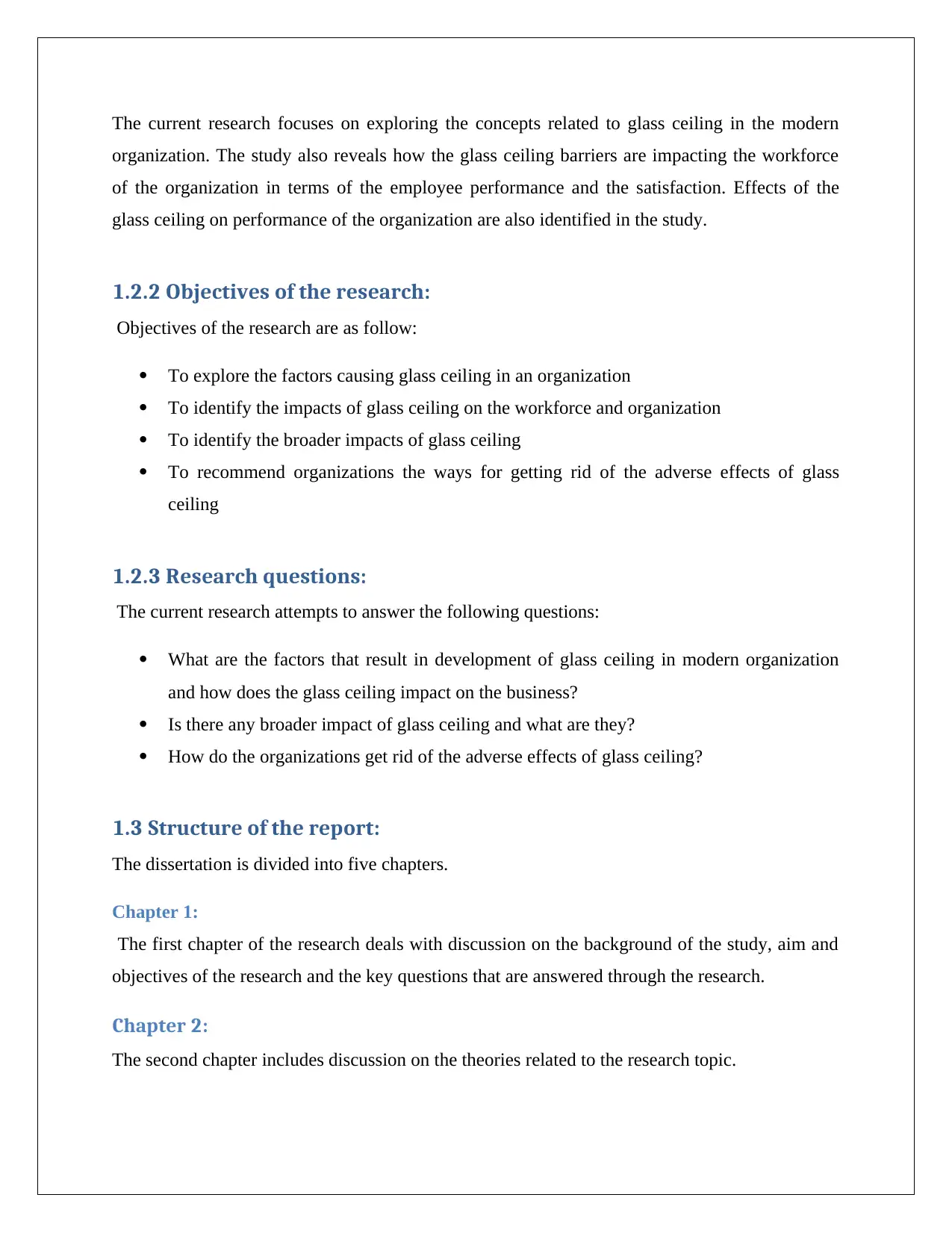
The current research focuses on exploring the concepts related to glass ceiling in the modern
organization. The study also reveals how the glass ceiling barriers are impacting the workforce
of the organization in terms of the employee performance and the satisfaction. Effects of the
glass ceiling on performance of the organization are also identified in the study.
1.2.2 Objectives of the research:
Objectives of the research are as follow:
To explore the factors causing glass ceiling in an organization
To identify the impacts of glass ceiling on the workforce and organization
To identify the broader impacts of glass ceiling
To recommend organizations the ways for getting rid of the adverse effects of glass
ceiling
1.2.3 Research questions:
The current research attempts to answer the following questions:
What are the factors that result in development of glass ceiling in modern organization
and how does the glass ceiling impact on the business?
Is there any broader impact of glass ceiling and what are they?
How do the organizations get rid of the adverse effects of glass ceiling?
1.3 Structure of the report:
The dissertation is divided into five chapters.
Chapter 1:
The first chapter of the research deals with discussion on the background of the study, aim and
objectives of the research and the key questions that are answered through the research.
Chapter 2:
The second chapter includes discussion on the theories related to the research topic.
organization. The study also reveals how the glass ceiling barriers are impacting the workforce
of the organization in terms of the employee performance and the satisfaction. Effects of the
glass ceiling on performance of the organization are also identified in the study.
1.2.2 Objectives of the research:
Objectives of the research are as follow:
To explore the factors causing glass ceiling in an organization
To identify the impacts of glass ceiling on the workforce and organization
To identify the broader impacts of glass ceiling
To recommend organizations the ways for getting rid of the adverse effects of glass
ceiling
1.2.3 Research questions:
The current research attempts to answer the following questions:
What are the factors that result in development of glass ceiling in modern organization
and how does the glass ceiling impact on the business?
Is there any broader impact of glass ceiling and what are they?
How do the organizations get rid of the adverse effects of glass ceiling?
1.3 Structure of the report:
The dissertation is divided into five chapters.
Chapter 1:
The first chapter of the research deals with discussion on the background of the study, aim and
objectives of the research and the key questions that are answered through the research.
Chapter 2:
The second chapter includes discussion on the theories related to the research topic.
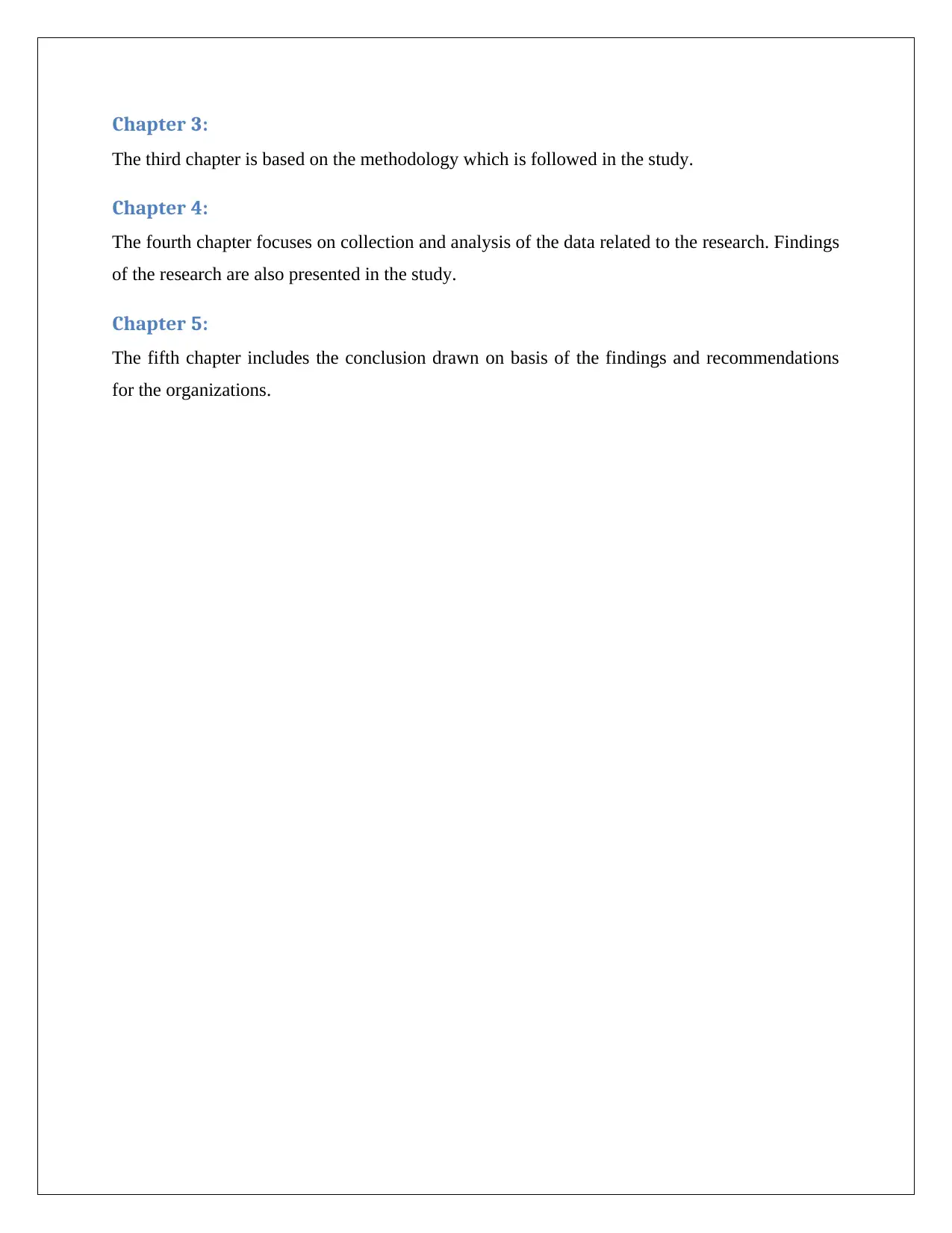
Chapter 3:
The third chapter is based on the methodology which is followed in the study.
Chapter 4:
The fourth chapter focuses on collection and analysis of the data related to the research. Findings
of the research are also presented in the study.
Chapter 5:
The fifth chapter includes the conclusion drawn on basis of the findings and recommendations
for the organizations.
The third chapter is based on the methodology which is followed in the study.
Chapter 4:
The fourth chapter focuses on collection and analysis of the data related to the research. Findings
of the research are also presented in the study.
Chapter 5:
The fifth chapter includes the conclusion drawn on basis of the findings and recommendations
for the organizations.
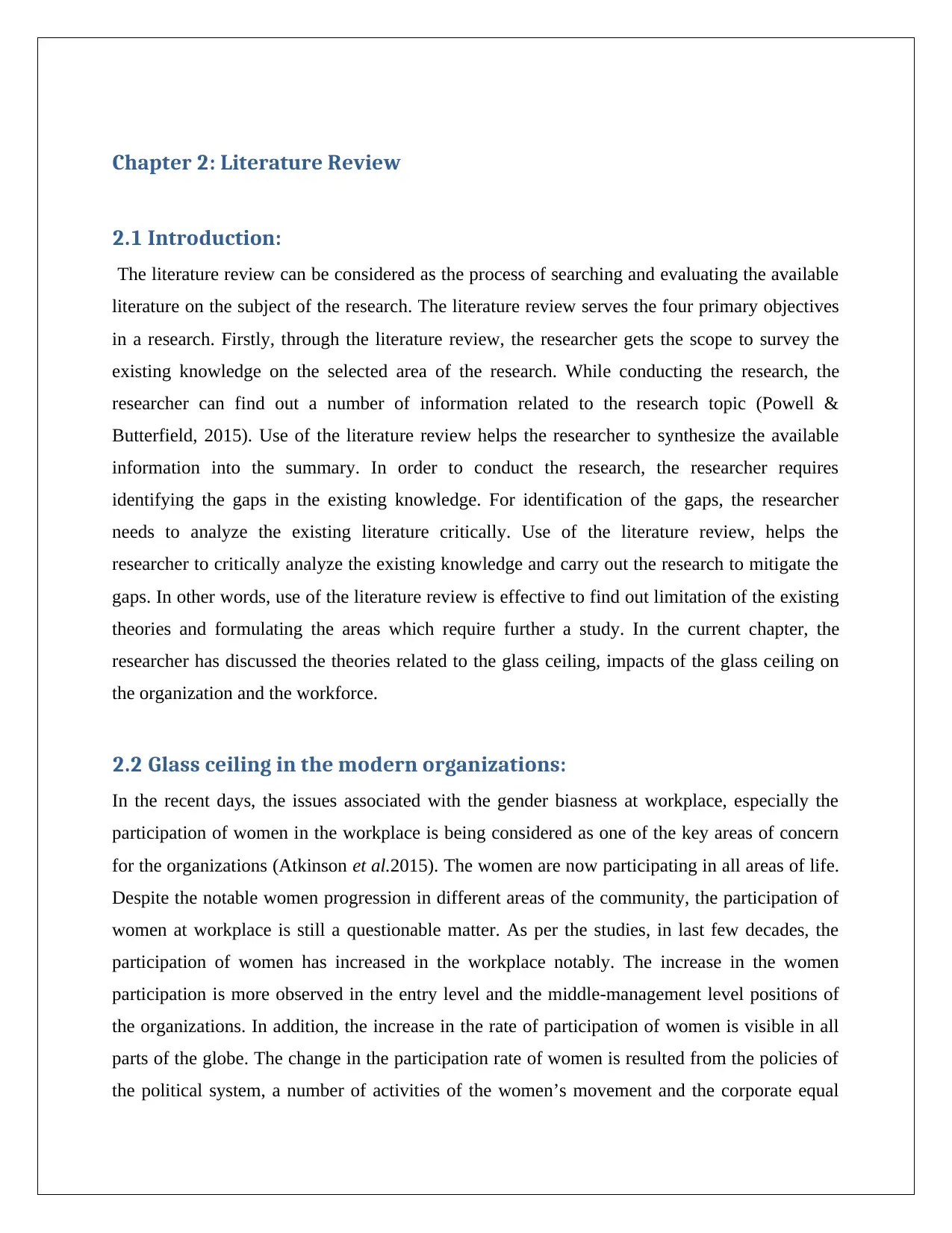
Chapter 2: Literature Review
2.1 Introduction:
The literature review can be considered as the process of searching and evaluating the available
literature on the subject of the research. The literature review serves the four primary objectives
in a research. Firstly, through the literature review, the researcher gets the scope to survey the
existing knowledge on the selected area of the research. While conducting the research, the
researcher can find out a number of information related to the research topic (Powell &
Butterfield, 2015). Use of the literature review helps the researcher to synthesize the available
information into the summary. In order to conduct the research, the researcher requires
identifying the gaps in the existing knowledge. For identification of the gaps, the researcher
needs to analyze the existing literature critically. Use of the literature review, helps the
researcher to critically analyze the existing knowledge and carry out the research to mitigate the
gaps. In other words, use of the literature review is effective to find out limitation of the existing
theories and formulating the areas which require further a study. In the current chapter, the
researcher has discussed the theories related to the glass ceiling, impacts of the glass ceiling on
the organization and the workforce.
2.2 Glass ceiling in the modern organizations:
In the recent days, the issues associated with the gender biasness at workplace, especially the
participation of women in the workplace is being considered as one of the key areas of concern
for the organizations (Atkinson et al.2015). The women are now participating in all areas of life.
Despite the notable women progression in different areas of the community, the participation of
women at workplace is still a questionable matter. As per the studies, in last few decades, the
participation of women has increased in the workplace notably. The increase in the women
participation is more observed in the entry level and the middle-management level positions of
the organizations. In addition, the increase in the rate of participation of women is visible in all
parts of the globe. The change in the participation rate of women is resulted from the policies of
the political system, a number of activities of the women’s movement and the corporate equal
2.1 Introduction:
The literature review can be considered as the process of searching and evaluating the available
literature on the subject of the research. The literature review serves the four primary objectives
in a research. Firstly, through the literature review, the researcher gets the scope to survey the
existing knowledge on the selected area of the research. While conducting the research, the
researcher can find out a number of information related to the research topic (Powell &
Butterfield, 2015). Use of the literature review helps the researcher to synthesize the available
information into the summary. In order to conduct the research, the researcher requires
identifying the gaps in the existing knowledge. For identification of the gaps, the researcher
needs to analyze the existing literature critically. Use of the literature review, helps the
researcher to critically analyze the existing knowledge and carry out the research to mitigate the
gaps. In other words, use of the literature review is effective to find out limitation of the existing
theories and formulating the areas which require further a study. In the current chapter, the
researcher has discussed the theories related to the glass ceiling, impacts of the glass ceiling on
the organization and the workforce.
2.2 Glass ceiling in the modern organizations:
In the recent days, the issues associated with the gender biasness at workplace, especially the
participation of women in the workplace is being considered as one of the key areas of concern
for the organizations (Atkinson et al.2015). The women are now participating in all areas of life.
Despite the notable women progression in different areas of the community, the participation of
women at workplace is still a questionable matter. As per the studies, in last few decades, the
participation of women has increased in the workplace notably. The increase in the women
participation is more observed in the entry level and the middle-management level positions of
the organizations. In addition, the increase in the rate of participation of women is visible in all
parts of the globe. The change in the participation rate of women is resulted from the policies of
the political system, a number of activities of the women’s movement and the corporate equal
Paraphrase This Document
Need a fresh take? Get an instant paraphrase of this document with our AI Paraphraser
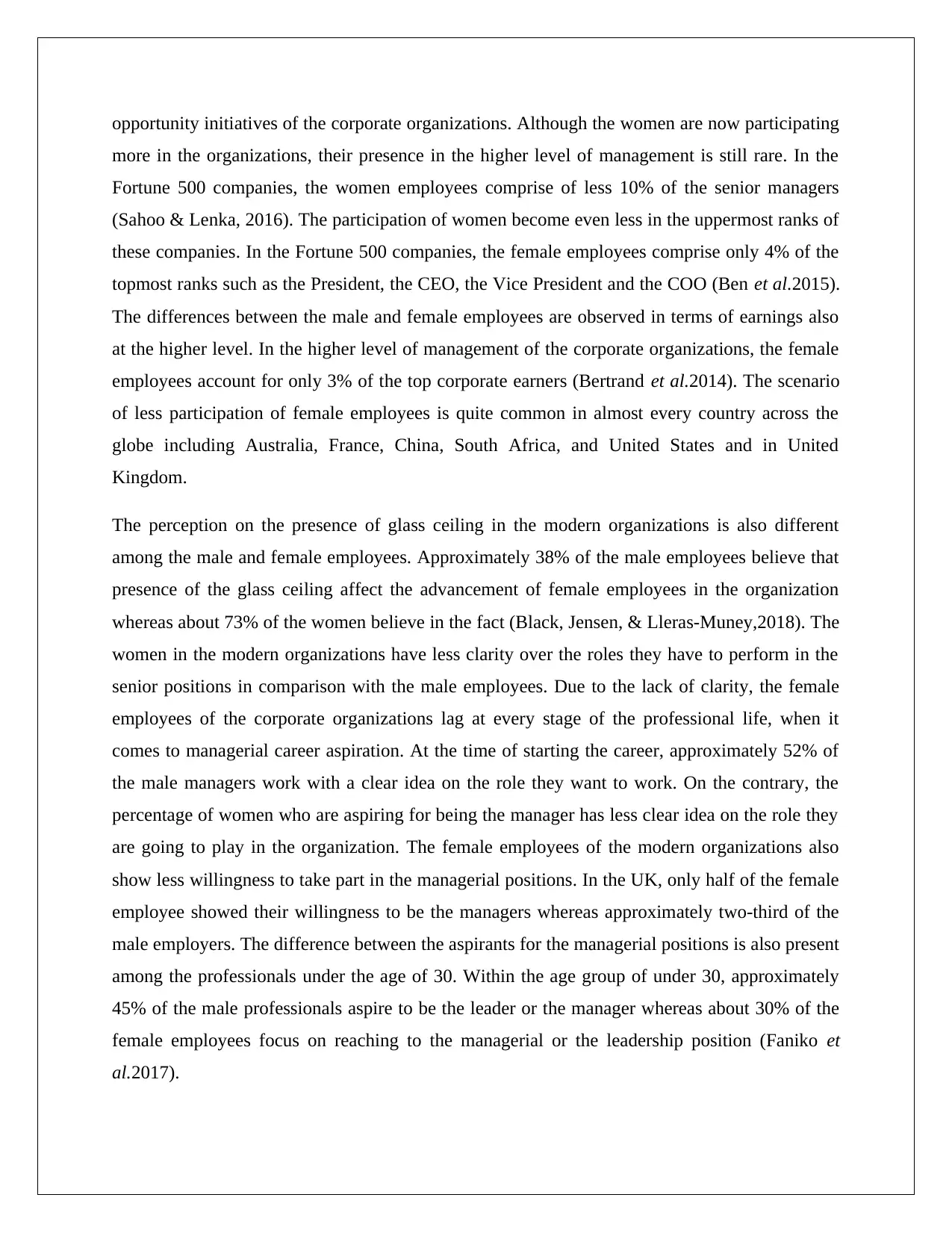
opportunity initiatives of the corporate organizations. Although the women are now participating
more in the organizations, their presence in the higher level of management is still rare. In the
Fortune 500 companies, the women employees comprise of less 10% of the senior managers
(Sahoo & Lenka, 2016). The participation of women become even less in the uppermost ranks of
these companies. In the Fortune 500 companies, the female employees comprise only 4% of the
topmost ranks such as the President, the CEO, the Vice President and the COO (Ben et al.2015).
The differences between the male and female employees are observed in terms of earnings also
at the higher level. In the higher level of management of the corporate organizations, the female
employees account for only 3% of the top corporate earners (Bertrand et al.2014). The scenario
of less participation of female employees is quite common in almost every country across the
globe including Australia, France, China, South Africa, and United States and in United
Kingdom.
The perception on the presence of glass ceiling in the modern organizations is also different
among the male and female employees. Approximately 38% of the male employees believe that
presence of the glass ceiling affect the advancement of female employees in the organization
whereas about 73% of the women believe in the fact (Black, Jensen, & Lleras-Muney,2018). The
women in the modern organizations have less clarity over the roles they have to perform in the
senior positions in comparison with the male employees. Due to the lack of clarity, the female
employees of the corporate organizations lag at every stage of the professional life, when it
comes to managerial career aspiration. At the time of starting the career, approximately 52% of
the male managers work with a clear idea on the role they want to work. On the contrary, the
percentage of women who are aspiring for being the manager has less clear idea on the role they
are going to play in the organization. The female employees of the modern organizations also
show less willingness to take part in the managerial positions. In the UK, only half of the female
employee showed their willingness to be the managers whereas approximately two-third of the
male employers. The difference between the aspirants for the managerial positions is also present
among the professionals under the age of 30. Within the age group of under 30, approximately
45% of the male professionals aspire to be the leader or the manager whereas about 30% of the
female employees focus on reaching to the managerial or the leadership position (Faniko et
al.2017).
more in the organizations, their presence in the higher level of management is still rare. In the
Fortune 500 companies, the women employees comprise of less 10% of the senior managers
(Sahoo & Lenka, 2016). The participation of women become even less in the uppermost ranks of
these companies. In the Fortune 500 companies, the female employees comprise only 4% of the
topmost ranks such as the President, the CEO, the Vice President and the COO (Ben et al.2015).
The differences between the male and female employees are observed in terms of earnings also
at the higher level. In the higher level of management of the corporate organizations, the female
employees account for only 3% of the top corporate earners (Bertrand et al.2014). The scenario
of less participation of female employees is quite common in almost every country across the
globe including Australia, France, China, South Africa, and United States and in United
Kingdom.
The perception on the presence of glass ceiling in the modern organizations is also different
among the male and female employees. Approximately 38% of the male employees believe that
presence of the glass ceiling affect the advancement of female employees in the organization
whereas about 73% of the women believe in the fact (Black, Jensen, & Lleras-Muney,2018). The
women in the modern organizations have less clarity over the roles they have to perform in the
senior positions in comparison with the male employees. Due to the lack of clarity, the female
employees of the corporate organizations lag at every stage of the professional life, when it
comes to managerial career aspiration. At the time of starting the career, approximately 52% of
the male managers work with a clear idea on the role they want to work. On the contrary, the
percentage of women who are aspiring for being the manager has less clear idea on the role they
are going to play in the organization. The female employees of the modern organizations also
show less willingness to take part in the managerial positions. In the UK, only half of the female
employee showed their willingness to be the managers whereas approximately two-third of the
male employers. The difference between the aspirants for the managerial positions is also present
among the professionals under the age of 30. Within the age group of under 30, approximately
45% of the male professionals aspire to be the leader or the manager whereas about 30% of the
female employees focus on reaching to the managerial or the leadership position (Faniko et
al.2017).
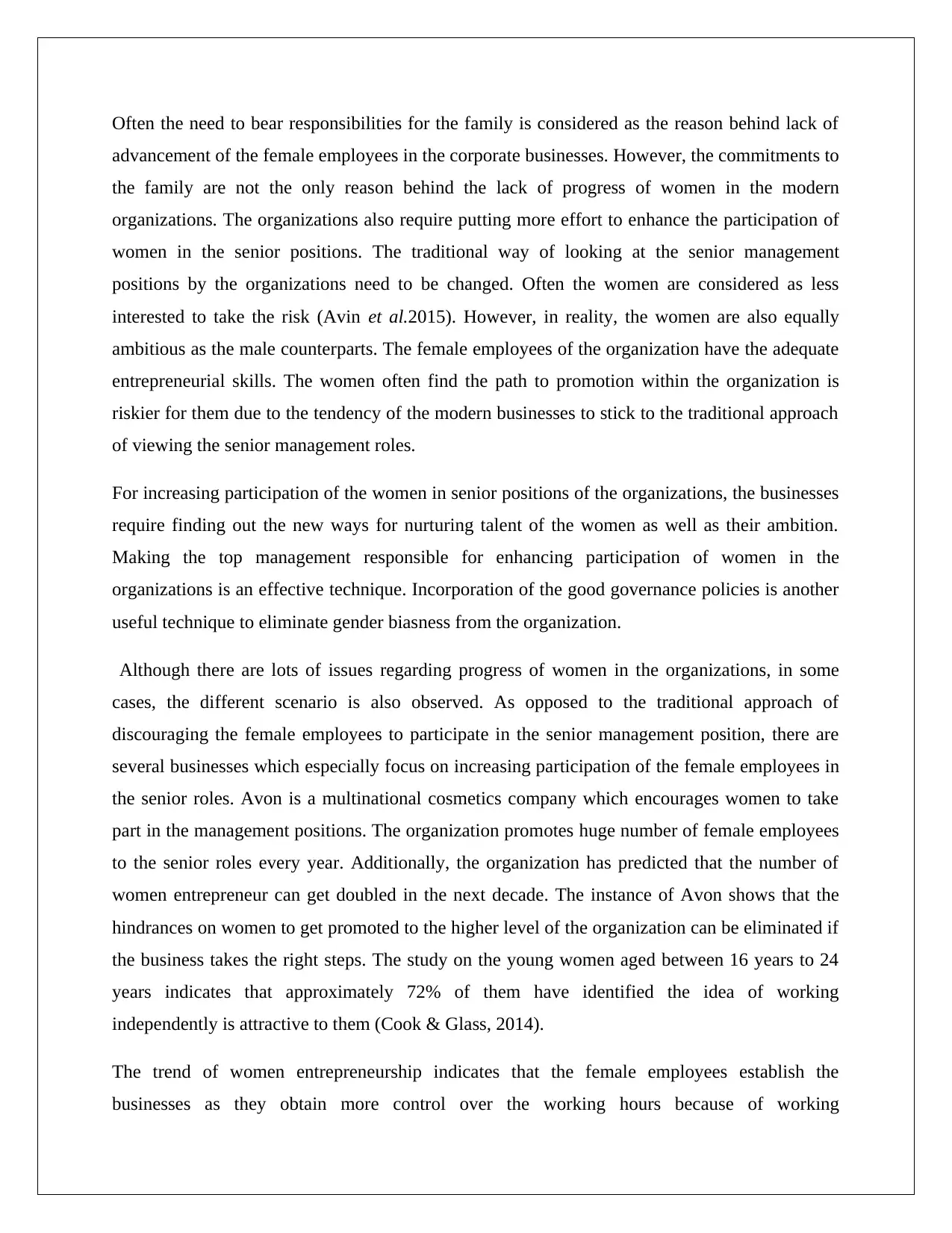
Often the need to bear responsibilities for the family is considered as the reason behind lack of
advancement of the female employees in the corporate businesses. However, the commitments to
the family are not the only reason behind the lack of progress of women in the modern
organizations. The organizations also require putting more effort to enhance the participation of
women in the senior positions. The traditional way of looking at the senior management
positions by the organizations need to be changed. Often the women are considered as less
interested to take the risk (Avin et al.2015). However, in reality, the women are also equally
ambitious as the male counterparts. The female employees of the organization have the adequate
entrepreneurial skills. The women often find the path to promotion within the organization is
riskier for them due to the tendency of the modern businesses to stick to the traditional approach
of viewing the senior management roles.
For increasing participation of the women in senior positions of the organizations, the businesses
require finding out the new ways for nurturing talent of the women as well as their ambition.
Making the top management responsible for enhancing participation of women in the
organizations is an effective technique. Incorporation of the good governance policies is another
useful technique to eliminate gender biasness from the organization.
Although there are lots of issues regarding progress of women in the organizations, in some
cases, the different scenario is also observed. As opposed to the traditional approach of
discouraging the female employees to participate in the senior management position, there are
several businesses which especially focus on increasing participation of the female employees in
the senior roles. Avon is a multinational cosmetics company which encourages women to take
part in the management positions. The organization promotes huge number of female employees
to the senior roles every year. Additionally, the organization has predicted that the number of
women entrepreneur can get doubled in the next decade. The instance of Avon shows that the
hindrances on women to get promoted to the higher level of the organization can be eliminated if
the business takes the right steps. The study on the young women aged between 16 years to 24
years indicates that approximately 72% of them have identified the idea of working
independently is attractive to them (Cook & Glass, 2014).
The trend of women entrepreneurship indicates that the female employees establish the
businesses as they obtain more control over the working hours because of working
advancement of the female employees in the corporate businesses. However, the commitments to
the family are not the only reason behind the lack of progress of women in the modern
organizations. The organizations also require putting more effort to enhance the participation of
women in the senior positions. The traditional way of looking at the senior management
positions by the organizations need to be changed. Often the women are considered as less
interested to take the risk (Avin et al.2015). However, in reality, the women are also equally
ambitious as the male counterparts. The female employees of the organization have the adequate
entrepreneurial skills. The women often find the path to promotion within the organization is
riskier for them due to the tendency of the modern businesses to stick to the traditional approach
of viewing the senior management roles.
For increasing participation of the women in senior positions of the organizations, the businesses
require finding out the new ways for nurturing talent of the women as well as their ambition.
Making the top management responsible for enhancing participation of women in the
organizations is an effective technique. Incorporation of the good governance policies is another
useful technique to eliminate gender biasness from the organization.
Although there are lots of issues regarding progress of women in the organizations, in some
cases, the different scenario is also observed. As opposed to the traditional approach of
discouraging the female employees to participate in the senior management position, there are
several businesses which especially focus on increasing participation of the female employees in
the senior roles. Avon is a multinational cosmetics company which encourages women to take
part in the management positions. The organization promotes huge number of female employees
to the senior roles every year. Additionally, the organization has predicted that the number of
women entrepreneur can get doubled in the next decade. The instance of Avon shows that the
hindrances on women to get promoted to the higher level of the organization can be eliminated if
the business takes the right steps. The study on the young women aged between 16 years to 24
years indicates that approximately 72% of them have identified the idea of working
independently is attractive to them (Cook & Glass, 2014).
The trend of women entrepreneurship indicates that the female employees establish the
businesses as they obtain more control over the working hours because of working
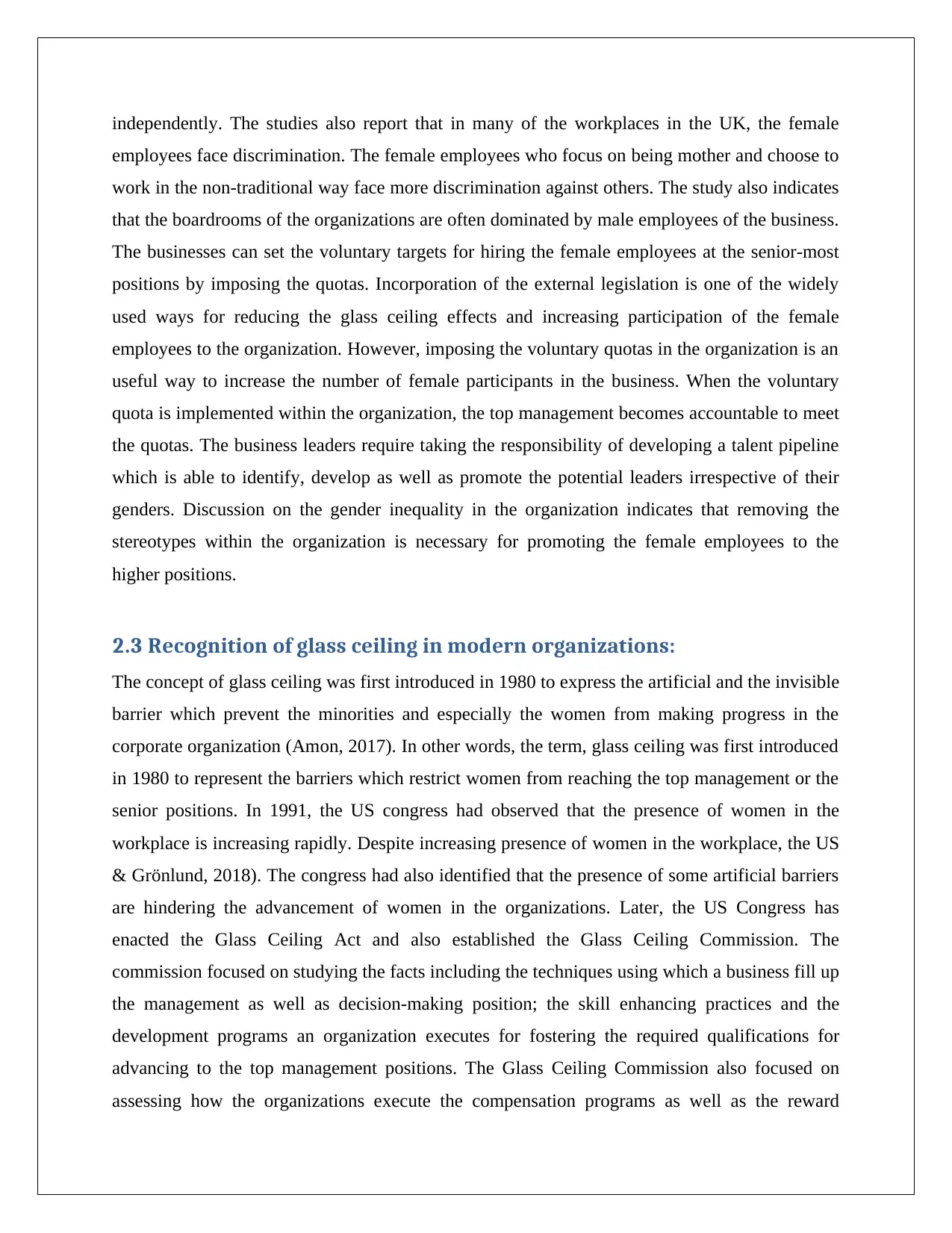
independently. The studies also report that in many of the workplaces in the UK, the female
employees face discrimination. The female employees who focus on being mother and choose to
work in the non-traditional way face more discrimination against others. The study also indicates
that the boardrooms of the organizations are often dominated by male employees of the business.
The businesses can set the voluntary targets for hiring the female employees at the senior-most
positions by imposing the quotas. Incorporation of the external legislation is one of the widely
used ways for reducing the glass ceiling effects and increasing participation of the female
employees to the organization. However, imposing the voluntary quotas in the organization is an
useful way to increase the number of female participants in the business. When the voluntary
quota is implemented within the organization, the top management becomes accountable to meet
the quotas. The business leaders require taking the responsibility of developing a talent pipeline
which is able to identify, develop as well as promote the potential leaders irrespective of their
genders. Discussion on the gender inequality in the organization indicates that removing the
stereotypes within the organization is necessary for promoting the female employees to the
higher positions.
2.3 Recognition of glass ceiling in modern organizations:
The concept of glass ceiling was first introduced in 1980 to express the artificial and the invisible
barrier which prevent the minorities and especially the women from making progress in the
corporate organization (Amon, 2017). In other words, the term, glass ceiling was first introduced
in 1980 to represent the barriers which restrict women from reaching the top management or the
senior positions. In 1991, the US congress had observed that the presence of women in the
workplace is increasing rapidly. Despite increasing presence of women in the workplace, the US
& Grönlund, 2018). The congress had also identified that the presence of some artificial barriers
are hindering the advancement of women in the organizations. Later, the US Congress has
enacted the Glass Ceiling Act and also established the Glass Ceiling Commission. The
commission focused on studying the facts including the techniques using which a business fill up
the management as well as decision-making position; the skill enhancing practices and the
development programs an organization executes for fostering the required qualifications for
advancing to the top management positions. The Glass Ceiling Commission also focused on
assessing how the organizations execute the compensation programs as well as the reward
employees face discrimination. The female employees who focus on being mother and choose to
work in the non-traditional way face more discrimination against others. The study also indicates
that the boardrooms of the organizations are often dominated by male employees of the business.
The businesses can set the voluntary targets for hiring the female employees at the senior-most
positions by imposing the quotas. Incorporation of the external legislation is one of the widely
used ways for reducing the glass ceiling effects and increasing participation of the female
employees to the organization. However, imposing the voluntary quotas in the organization is an
useful way to increase the number of female participants in the business. When the voluntary
quota is implemented within the organization, the top management becomes accountable to meet
the quotas. The business leaders require taking the responsibility of developing a talent pipeline
which is able to identify, develop as well as promote the potential leaders irrespective of their
genders. Discussion on the gender inequality in the organization indicates that removing the
stereotypes within the organization is necessary for promoting the female employees to the
higher positions.
2.3 Recognition of glass ceiling in modern organizations:
The concept of glass ceiling was first introduced in 1980 to express the artificial and the invisible
barrier which prevent the minorities and especially the women from making progress in the
corporate organization (Amon, 2017). In other words, the term, glass ceiling was first introduced
in 1980 to represent the barriers which restrict women from reaching the top management or the
senior positions. In 1991, the US congress had observed that the presence of women in the
workplace is increasing rapidly. Despite increasing presence of women in the workplace, the US
& Grönlund, 2018). The congress had also identified that the presence of some artificial barriers
are hindering the advancement of women in the organizations. Later, the US Congress has
enacted the Glass Ceiling Act and also established the Glass Ceiling Commission. The
commission focused on studying the facts including the techniques using which a business fill up
the management as well as decision-making position; the skill enhancing practices and the
development programs an organization executes for fostering the required qualifications for
advancing to the top management positions. The Glass Ceiling Commission also focused on
assessing how the organizations execute the compensation programs as well as the reward
Secure Best Marks with AI Grader
Need help grading? Try our AI Grader for instant feedback on your assignments.

structures which are being used by the organization currently along with the annual award
programs for promoting the diversely skilled workforce to the decision making level (Amon,
2017).
Presence of the invisible barrier at the corporate organizations was first recognized in1995, in the
report of the Glass Ceiling Commission. In 1995, the commission has identified that only 3 to 5
percent of the top management positions in the corporate organizations are women (Sharif,
2015). The commission has also observed that the women who are working in the senior
management positions are getting lower compensate when compared to the male counterparts.
Finally, the commission also observed that the women in the senior positions had worked mainly
in the research or human resource activities which are not usually considered as the career
pathway for the executive positions.
2.4 Barriers for the progress of women at workplace:
The Glass Ceiling Commission had reported a number of barriers that limit success of the
women while reaching the top positions of the organizations. As reported by the Commission,
the barriers include the societal, the internal businesses and the organizational structure related
issues. The societal barriers for the progress of women in the managerial positions are mainly the
lack of opportunity for the women, the presence of biasness and prejudice towards the women.
The color and gender based differences also affect the position of women in the organizations
(Kandil, 2015). The commission, in order to eliminate these barriers from the organization has
suggested that the management requires implementing the merit based practice within the
business for development of compensation, reward and the promotion related policies. As per the
commission, implementation of the merit based practices is effective enough to reduce the
adverse effects of stereotyping.
The Glass Ceiling Commission had identified a number of governmental barriers which restrict
the upward mobility of women. The lack of government effort for collecting and analyzing the
employee related data is one of the key reasons behind the lower participation rate of women in
the management positions (Downes et al. 2014). The commission has suggested implementation
of a consistent and the vigorous monitoring framework with focus on taking positive actions can
be effective to enhance the rate of participation of women in the senior management positions. In
programs for promoting the diversely skilled workforce to the decision making level (Amon,
2017).
Presence of the invisible barrier at the corporate organizations was first recognized in1995, in the
report of the Glass Ceiling Commission. In 1995, the commission has identified that only 3 to 5
percent of the top management positions in the corporate organizations are women (Sharif,
2015). The commission has also observed that the women who are working in the senior
management positions are getting lower compensate when compared to the male counterparts.
Finally, the commission also observed that the women in the senior positions had worked mainly
in the research or human resource activities which are not usually considered as the career
pathway for the executive positions.
2.4 Barriers for the progress of women at workplace:
The Glass Ceiling Commission had reported a number of barriers that limit success of the
women while reaching the top positions of the organizations. As reported by the Commission,
the barriers include the societal, the internal businesses and the organizational structure related
issues. The societal barriers for the progress of women in the managerial positions are mainly the
lack of opportunity for the women, the presence of biasness and prejudice towards the women.
The color and gender based differences also affect the position of women in the organizations
(Kandil, 2015). The commission, in order to eliminate these barriers from the organization has
suggested that the management requires implementing the merit based practice within the
business for development of compensation, reward and the promotion related policies. As per the
commission, implementation of the merit based practices is effective enough to reduce the
adverse effects of stereotyping.
The Glass Ceiling Commission had identified a number of governmental barriers which restrict
the upward mobility of women. The lack of government effort for collecting and analyzing the
employee related data is one of the key reasons behind the lower participation rate of women in
the management positions (Downes et al. 2014). The commission has suggested implementation
of a consistent and the vigorous monitoring framework with focus on taking positive actions can
be effective to enhance the rate of participation of women in the senior management positions. In
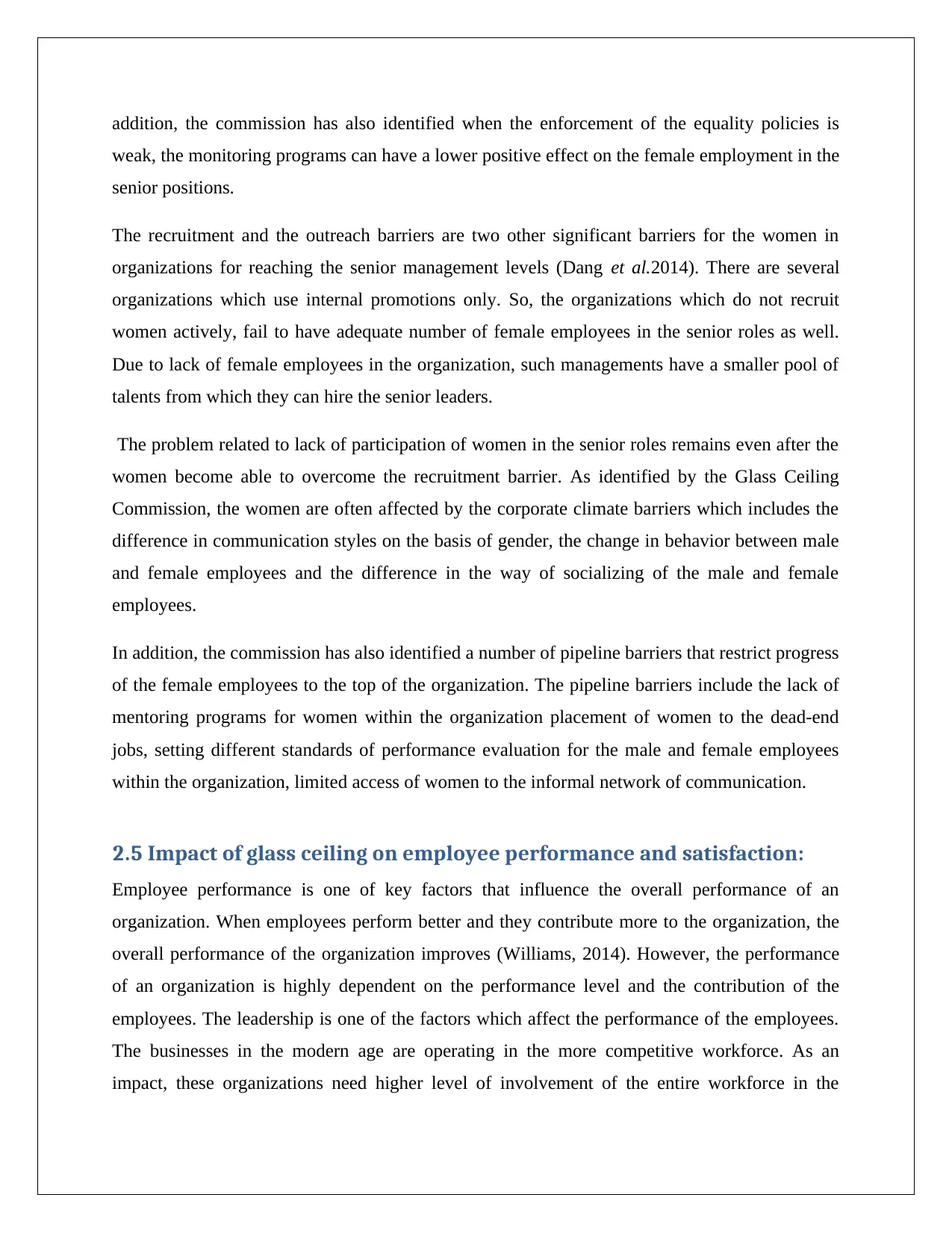
addition, the commission has also identified when the enforcement of the equality policies is
weak, the monitoring programs can have a lower positive effect on the female employment in the
senior positions.
The recruitment and the outreach barriers are two other significant barriers for the women in
organizations for reaching the senior management levels (Dang et al.2014). There are several
organizations which use internal promotions only. So, the organizations which do not recruit
women actively, fail to have adequate number of female employees in the senior roles as well.
Due to lack of female employees in the organization, such managements have a smaller pool of
talents from which they can hire the senior leaders.
The problem related to lack of participation of women in the senior roles remains even after the
women become able to overcome the recruitment barrier. As identified by the Glass Ceiling
Commission, the women are often affected by the corporate climate barriers which includes the
difference in communication styles on the basis of gender, the change in behavior between male
and female employees and the difference in the way of socializing of the male and female
employees.
In addition, the commission has also identified a number of pipeline barriers that restrict progress
of the female employees to the top of the organization. The pipeline barriers include the lack of
mentoring programs for women within the organization placement of women to the dead-end
jobs, setting different standards of performance evaluation for the male and female employees
within the organization, limited access of women to the informal network of communication.
2.5 Impact of glass ceiling on employee performance and satisfaction:
Employee performance is one of key factors that influence the overall performance of an
organization. When employees perform better and they contribute more to the organization, the
overall performance of the organization improves (Williams, 2014). However, the performance
of an organization is highly dependent on the performance level and the contribution of the
employees. The leadership is one of the factors which affect the performance of the employees.
The businesses in the modern age are operating in the more competitive workforce. As an
impact, these organizations need higher level of involvement of the entire workforce in the
weak, the monitoring programs can have a lower positive effect on the female employment in the
senior positions.
The recruitment and the outreach barriers are two other significant barriers for the women in
organizations for reaching the senior management levels (Dang et al.2014). There are several
organizations which use internal promotions only. So, the organizations which do not recruit
women actively, fail to have adequate number of female employees in the senior roles as well.
Due to lack of female employees in the organization, such managements have a smaller pool of
talents from which they can hire the senior leaders.
The problem related to lack of participation of women in the senior roles remains even after the
women become able to overcome the recruitment barrier. As identified by the Glass Ceiling
Commission, the women are often affected by the corporate climate barriers which includes the
difference in communication styles on the basis of gender, the change in behavior between male
and female employees and the difference in the way of socializing of the male and female
employees.
In addition, the commission has also identified a number of pipeline barriers that restrict progress
of the female employees to the top of the organization. The pipeline barriers include the lack of
mentoring programs for women within the organization placement of women to the dead-end
jobs, setting different standards of performance evaluation for the male and female employees
within the organization, limited access of women to the informal network of communication.
2.5 Impact of glass ceiling on employee performance and satisfaction:
Employee performance is one of key factors that influence the overall performance of an
organization. When employees perform better and they contribute more to the organization, the
overall performance of the organization improves (Williams, 2014). However, the performance
of an organization is highly dependent on the performance level and the contribution of the
employees. The leadership is one of the factors which affect the performance of the employees.
The businesses in the modern age are operating in the more competitive workforce. As an
impact, these organizations need higher level of involvement of the entire workforce in the
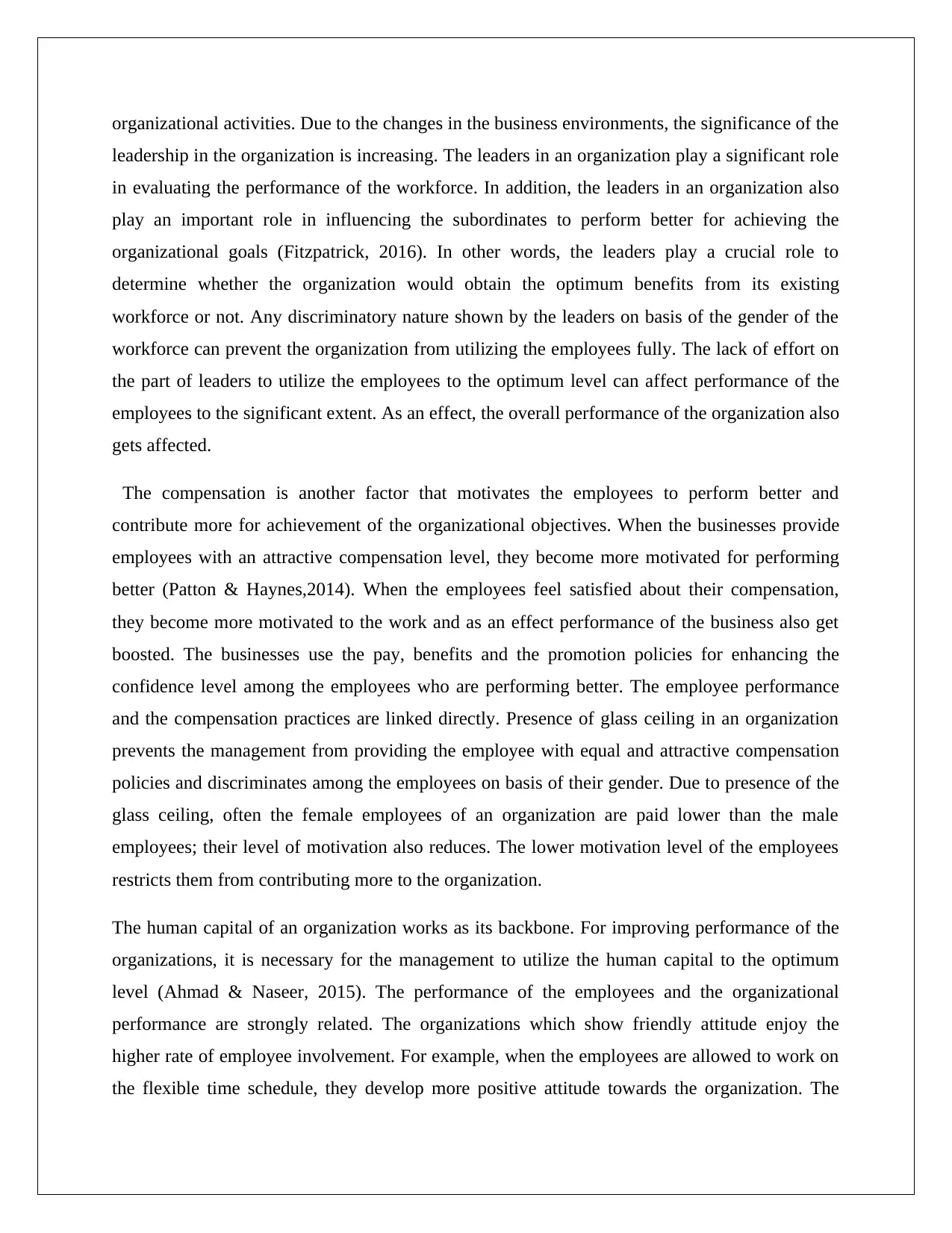
organizational activities. Due to the changes in the business environments, the significance of the
leadership in the organization is increasing. The leaders in an organization play a significant role
in evaluating the performance of the workforce. In addition, the leaders in an organization also
play an important role in influencing the subordinates to perform better for achieving the
organizational goals (Fitzpatrick, 2016). In other words, the leaders play a crucial role to
determine whether the organization would obtain the optimum benefits from its existing
workforce or not. Any discriminatory nature shown by the leaders on basis of the gender of the
workforce can prevent the organization from utilizing the employees fully. The lack of effort on
the part of leaders to utilize the employees to the optimum level can affect performance of the
employees to the significant extent. As an effect, the overall performance of the organization also
gets affected.
The compensation is another factor that motivates the employees to perform better and
contribute more for achievement of the organizational objectives. When the businesses provide
employees with an attractive compensation level, they become more motivated for performing
better (Patton & Haynes,2014). When the employees feel satisfied about their compensation,
they become more motivated to the work and as an effect performance of the business also get
boosted. The businesses use the pay, benefits and the promotion policies for enhancing the
confidence level among the employees who are performing better. The employee performance
and the compensation practices are linked directly. Presence of glass ceiling in an organization
prevents the management from providing the employee with equal and attractive compensation
policies and discriminates among the employees on basis of their gender. Due to presence of the
glass ceiling, often the female employees of an organization are paid lower than the male
employees; their level of motivation also reduces. The lower motivation level of the employees
restricts them from contributing more to the organization.
The human capital of an organization works as its backbone. For improving performance of the
organizations, it is necessary for the management to utilize the human capital to the optimum
level (Ahmad & Naseer, 2015). The performance of the employees and the organizational
performance are strongly related. The organizations which show friendly attitude enjoy the
higher rate of employee involvement. For example, when the employees are allowed to work on
the flexible time schedule, they develop more positive attitude towards the organization. The
leadership in the organization is increasing. The leaders in an organization play a significant role
in evaluating the performance of the workforce. In addition, the leaders in an organization also
play an important role in influencing the subordinates to perform better for achieving the
organizational goals (Fitzpatrick, 2016). In other words, the leaders play a crucial role to
determine whether the organization would obtain the optimum benefits from its existing
workforce or not. Any discriminatory nature shown by the leaders on basis of the gender of the
workforce can prevent the organization from utilizing the employees fully. The lack of effort on
the part of leaders to utilize the employees to the optimum level can affect performance of the
employees to the significant extent. As an effect, the overall performance of the organization also
gets affected.
The compensation is another factor that motivates the employees to perform better and
contribute more for achievement of the organizational objectives. When the businesses provide
employees with an attractive compensation level, they become more motivated for performing
better (Patton & Haynes,2014). When the employees feel satisfied about their compensation,
they become more motivated to the work and as an effect performance of the business also get
boosted. The businesses use the pay, benefits and the promotion policies for enhancing the
confidence level among the employees who are performing better. The employee performance
and the compensation practices are linked directly. Presence of glass ceiling in an organization
prevents the management from providing the employee with equal and attractive compensation
policies and discriminates among the employees on basis of their gender. Due to presence of the
glass ceiling, often the female employees of an organization are paid lower than the male
employees; their level of motivation also reduces. The lower motivation level of the employees
restricts them from contributing more to the organization.
The human capital of an organization works as its backbone. For improving performance of the
organizations, it is necessary for the management to utilize the human capital to the optimum
level (Ahmad & Naseer, 2015). The performance of the employees and the organizational
performance are strongly related. The organizations which show friendly attitude enjoy the
higher rate of employee involvement. For example, when the employees are allowed to work on
the flexible time schedule, they develop more positive attitude towards the organization. The
Paraphrase This Document
Need a fresh take? Get an instant paraphrase of this document with our AI Paraphraser
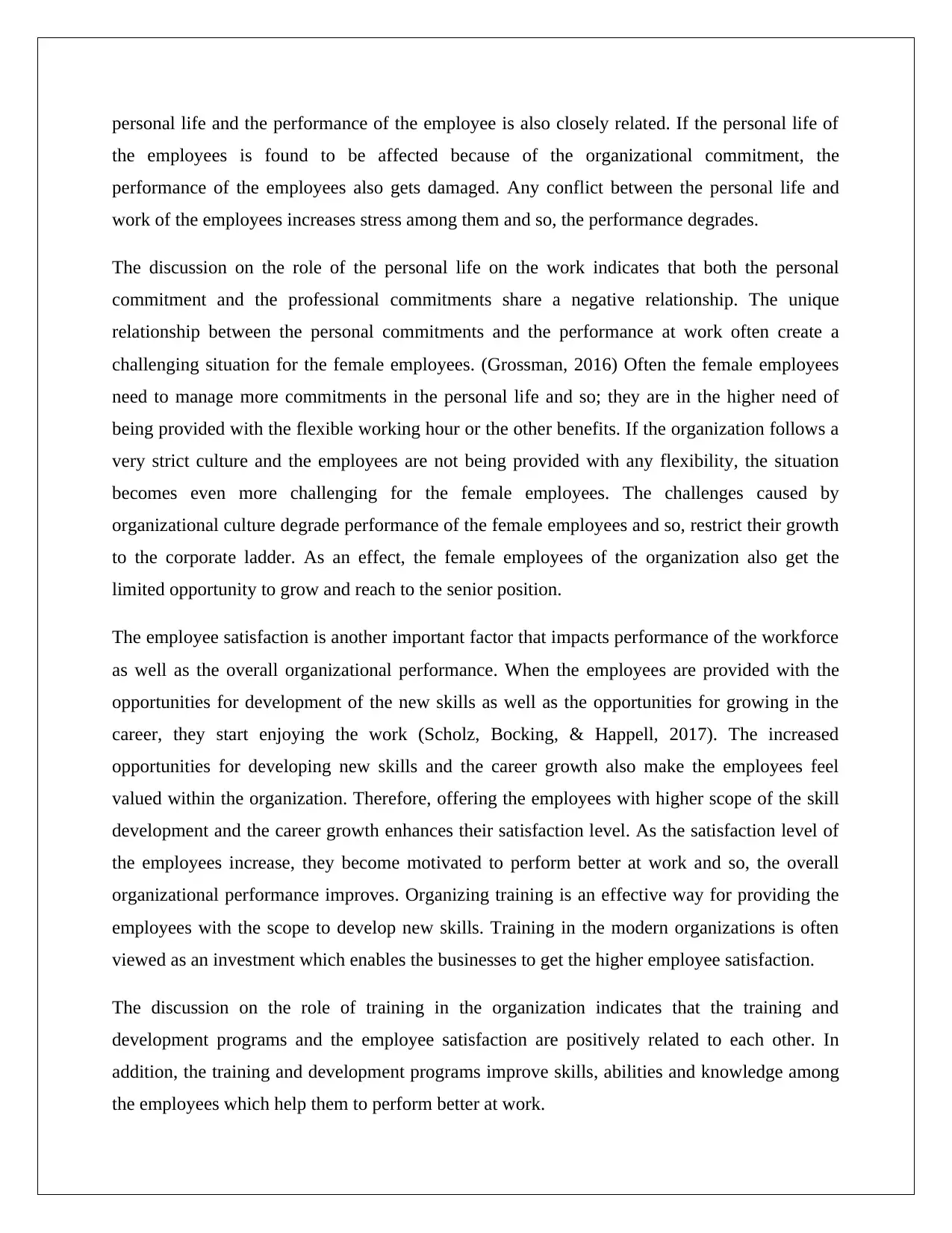
personal life and the performance of the employee is also closely related. If the personal life of
the employees is found to be affected because of the organizational commitment, the
performance of the employees also gets damaged. Any conflict between the personal life and
work of the employees increases stress among them and so, the performance degrades.
The discussion on the role of the personal life on the work indicates that both the personal
commitment and the professional commitments share a negative relationship. The unique
relationship between the personal commitments and the performance at work often create a
challenging situation for the female employees. (Grossman, 2016) Often the female employees
need to manage more commitments in the personal life and so; they are in the higher need of
being provided with the flexible working hour or the other benefits. If the organization follows a
very strict culture and the employees are not being provided with any flexibility, the situation
becomes even more challenging for the female employees. The challenges caused by
organizational culture degrade performance of the female employees and so, restrict their growth
to the corporate ladder. As an effect, the female employees of the organization also get the
limited opportunity to grow and reach to the senior position.
The employee satisfaction is another important factor that impacts performance of the workforce
as well as the overall organizational performance. When the employees are provided with the
opportunities for development of the new skills as well as the opportunities for growing in the
career, they start enjoying the work (Scholz, Bocking, & Happell, 2017). The increased
opportunities for developing new skills and the career growth also make the employees feel
valued within the organization. Therefore, offering the employees with higher scope of the skill
development and the career growth enhances their satisfaction level. As the satisfaction level of
the employees increase, they become motivated to perform better at work and so, the overall
organizational performance improves. Organizing training is an effective way for providing the
employees with the scope to develop new skills. Training in the modern organizations is often
viewed as an investment which enables the businesses to get the higher employee satisfaction.
The discussion on the role of training in the organization indicates that the training and
development programs and the employee satisfaction are positively related to each other. In
addition, the training and development programs improve skills, abilities and knowledge among
the employees which help them to perform better at work.
the employees is found to be affected because of the organizational commitment, the
performance of the employees also gets damaged. Any conflict between the personal life and
work of the employees increases stress among them and so, the performance degrades.
The discussion on the role of the personal life on the work indicates that both the personal
commitment and the professional commitments share a negative relationship. The unique
relationship between the personal commitments and the performance at work often create a
challenging situation for the female employees. (Grossman, 2016) Often the female employees
need to manage more commitments in the personal life and so; they are in the higher need of
being provided with the flexible working hour or the other benefits. If the organization follows a
very strict culture and the employees are not being provided with any flexibility, the situation
becomes even more challenging for the female employees. The challenges caused by
organizational culture degrade performance of the female employees and so, restrict their growth
to the corporate ladder. As an effect, the female employees of the organization also get the
limited opportunity to grow and reach to the senior position.
The employee satisfaction is another important factor that impacts performance of the workforce
as well as the overall organizational performance. When the employees are provided with the
opportunities for development of the new skills as well as the opportunities for growing in the
career, they start enjoying the work (Scholz, Bocking, & Happell, 2017). The increased
opportunities for developing new skills and the career growth also make the employees feel
valued within the organization. Therefore, offering the employees with higher scope of the skill
development and the career growth enhances their satisfaction level. As the satisfaction level of
the employees increase, they become motivated to perform better at work and so, the overall
organizational performance improves. Organizing training is an effective way for providing the
employees with the scope to develop new skills. Training in the modern organizations is often
viewed as an investment which enables the businesses to get the higher employee satisfaction.
The discussion on the role of training in the organization indicates that the training and
development programs and the employee satisfaction are positively related to each other. In
addition, the training and development programs improve skills, abilities and knowledge among
the employees which help them to perform better at work.
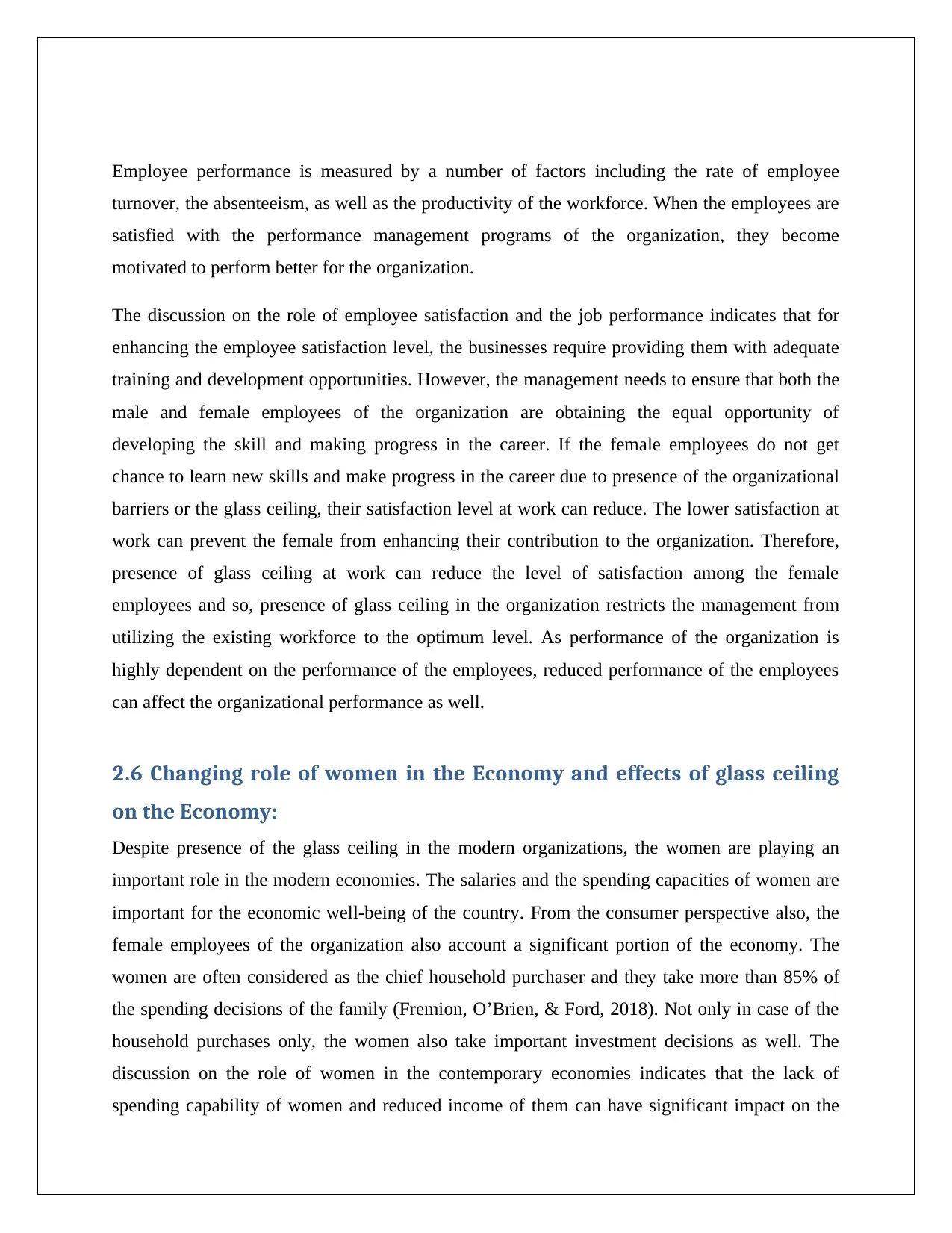
Employee performance is measured by a number of factors including the rate of employee
turnover, the absenteeism, as well as the productivity of the workforce. When the employees are
satisfied with the performance management programs of the organization, they become
motivated to perform better for the organization.
The discussion on the role of employee satisfaction and the job performance indicates that for
enhancing the employee satisfaction level, the businesses require providing them with adequate
training and development opportunities. However, the management needs to ensure that both the
male and female employees of the organization are obtaining the equal opportunity of
developing the skill and making progress in the career. If the female employees do not get
chance to learn new skills and make progress in the career due to presence of the organizational
barriers or the glass ceiling, their satisfaction level at work can reduce. The lower satisfaction at
work can prevent the female from enhancing their contribution to the organization. Therefore,
presence of glass ceiling at work can reduce the level of satisfaction among the female
employees and so, presence of glass ceiling in the organization restricts the management from
utilizing the existing workforce to the optimum level. As performance of the organization is
highly dependent on the performance of the employees, reduced performance of the employees
can affect the organizational performance as well.
2.6 Changing role of women in the Economy and effects of glass ceiling
on the Economy:
Despite presence of the glass ceiling in the modern organizations, the women are playing an
important role in the modern economies. The salaries and the spending capacities of women are
important for the economic well-being of the country. From the consumer perspective also, the
female employees of the organization also account a significant portion of the economy. The
women are often considered as the chief household purchaser and they take more than 85% of
the spending decisions of the family (Fremion, O’Brien, & Ford, 2018). Not only in case of the
household purchases only, the women also take important investment decisions as well. The
discussion on the role of women in the contemporary economies indicates that the lack of
spending capability of women and reduced income of them can have significant impact on the
turnover, the absenteeism, as well as the productivity of the workforce. When the employees are
satisfied with the performance management programs of the organization, they become
motivated to perform better for the organization.
The discussion on the role of employee satisfaction and the job performance indicates that for
enhancing the employee satisfaction level, the businesses require providing them with adequate
training and development opportunities. However, the management needs to ensure that both the
male and female employees of the organization are obtaining the equal opportunity of
developing the skill and making progress in the career. If the female employees do not get
chance to learn new skills and make progress in the career due to presence of the organizational
barriers or the glass ceiling, their satisfaction level at work can reduce. The lower satisfaction at
work can prevent the female from enhancing their contribution to the organization. Therefore,
presence of glass ceiling at work can reduce the level of satisfaction among the female
employees and so, presence of glass ceiling in the organization restricts the management from
utilizing the existing workforce to the optimum level. As performance of the organization is
highly dependent on the performance of the employees, reduced performance of the employees
can affect the organizational performance as well.
2.6 Changing role of women in the Economy and effects of glass ceiling
on the Economy:
Despite presence of the glass ceiling in the modern organizations, the women are playing an
important role in the modern economies. The salaries and the spending capacities of women are
important for the economic well-being of the country. From the consumer perspective also, the
female employees of the organization also account a significant portion of the economy. The
women are often considered as the chief household purchaser and they take more than 85% of
the spending decisions of the family (Fremion, O’Brien, & Ford, 2018). Not only in case of the
household purchases only, the women also take important investment decisions as well. The
discussion on the role of women in the contemporary economies indicates that the lack of
spending capability of women and reduced income of them can have significant impact on the
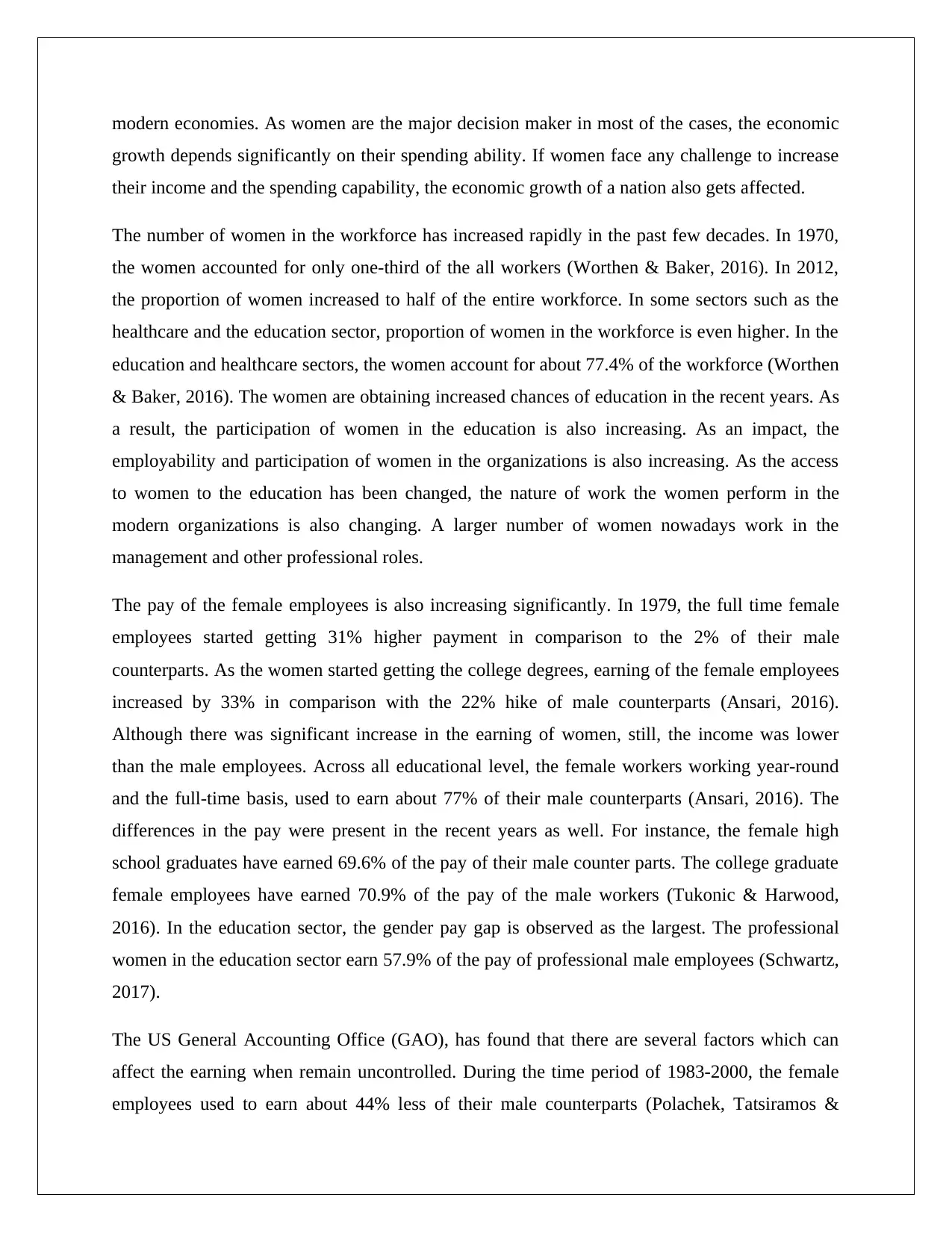
modern economies. As women are the major decision maker in most of the cases, the economic
growth depends significantly on their spending ability. If women face any challenge to increase
their income and the spending capability, the economic growth of a nation also gets affected.
The number of women in the workforce has increased rapidly in the past few decades. In 1970,
the women accounted for only one-third of the all workers (Worthen & Baker, 2016). In 2012,
the proportion of women increased to half of the entire workforce. In some sectors such as the
healthcare and the education sector, proportion of women in the workforce is even higher. In the
education and healthcare sectors, the women account for about 77.4% of the workforce (Worthen
& Baker, 2016). The women are obtaining increased chances of education in the recent years. As
a result, the participation of women in the education is also increasing. As an impact, the
employability and participation of women in the organizations is also increasing. As the access
to women to the education has been changed, the nature of work the women perform in the
modern organizations is also changing. A larger number of women nowadays work in the
management and other professional roles.
The pay of the female employees is also increasing significantly. In 1979, the full time female
employees started getting 31% higher payment in comparison to the 2% of their male
counterparts. As the women started getting the college degrees, earning of the female employees
increased by 33% in comparison with the 22% hike of male counterparts (Ansari, 2016).
Although there was significant increase in the earning of women, still, the income was lower
than the male employees. Across all educational level, the female workers working year-round
and the full-time basis, used to earn about 77% of their male counterparts (Ansari, 2016). The
differences in the pay were present in the recent years as well. For instance, the female high
school graduates have earned 69.6% of the pay of their male counter parts. The college graduate
female employees have earned 70.9% of the pay of the male workers (Tukonic & Harwood,
2016). In the education sector, the gender pay gap is observed as the largest. The professional
women in the education sector earn 57.9% of the pay of professional male employees (Schwartz,
2017).
The US General Accounting Office (GAO), has found that there are several factors which can
affect the earning when remain uncontrolled. During the time period of 1983-2000, the female
employees used to earn about 44% less of their male counterparts (Polachek, Tatsiramos &
growth depends significantly on their spending ability. If women face any challenge to increase
their income and the spending capability, the economic growth of a nation also gets affected.
The number of women in the workforce has increased rapidly in the past few decades. In 1970,
the women accounted for only one-third of the all workers (Worthen & Baker, 2016). In 2012,
the proportion of women increased to half of the entire workforce. In some sectors such as the
healthcare and the education sector, proportion of women in the workforce is even higher. In the
education and healthcare sectors, the women account for about 77.4% of the workforce (Worthen
& Baker, 2016). The women are obtaining increased chances of education in the recent years. As
a result, the participation of women in the education is also increasing. As an impact, the
employability and participation of women in the organizations is also increasing. As the access
to women to the education has been changed, the nature of work the women perform in the
modern organizations is also changing. A larger number of women nowadays work in the
management and other professional roles.
The pay of the female employees is also increasing significantly. In 1979, the full time female
employees started getting 31% higher payment in comparison to the 2% of their male
counterparts. As the women started getting the college degrees, earning of the female employees
increased by 33% in comparison with the 22% hike of male counterparts (Ansari, 2016).
Although there was significant increase in the earning of women, still, the income was lower
than the male employees. Across all educational level, the female workers working year-round
and the full-time basis, used to earn about 77% of their male counterparts (Ansari, 2016). The
differences in the pay were present in the recent years as well. For instance, the female high
school graduates have earned 69.6% of the pay of their male counter parts. The college graduate
female employees have earned 70.9% of the pay of the male workers (Tukonic & Harwood,
2016). In the education sector, the gender pay gap is observed as the largest. The professional
women in the education sector earn 57.9% of the pay of professional male employees (Schwartz,
2017).
The US General Accounting Office (GAO), has found that there are several factors which can
affect the earning when remain uncontrolled. During the time period of 1983-2000, the female
employees used to earn about 44% less of their male counterparts (Polachek, Tatsiramos &
Secure Best Marks with AI Grader
Need help grading? Try our AI Grader for instant feedback on your assignments.
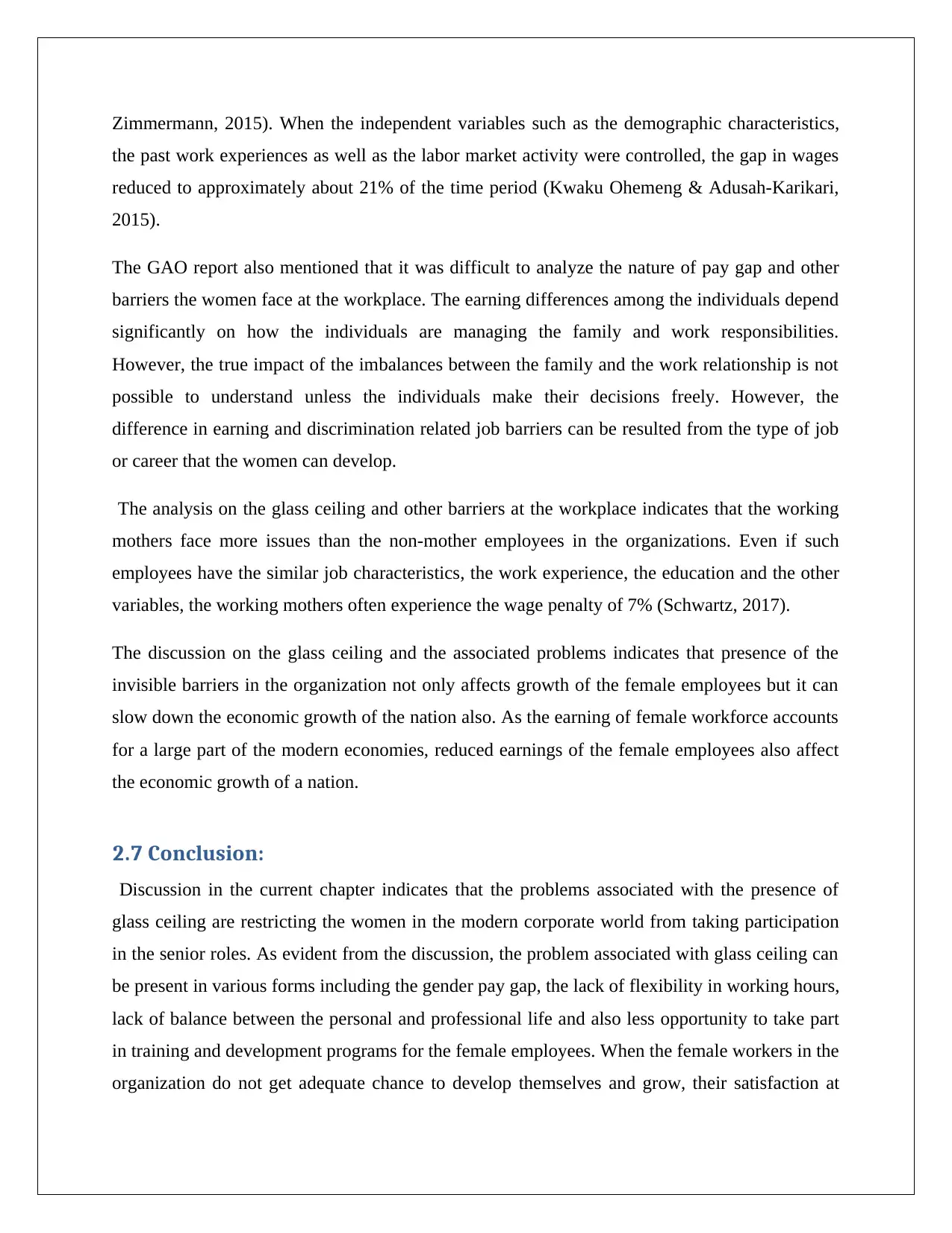
Zimmermann, 2015). When the independent variables such as the demographic characteristics,
the past work experiences as well as the labor market activity were controlled, the gap in wages
reduced to approximately about 21% of the time period (Kwaku Ohemeng & Adusah-Karikari,
2015).
The GAO report also mentioned that it was difficult to analyze the nature of pay gap and other
barriers the women face at the workplace. The earning differences among the individuals depend
significantly on how the individuals are managing the family and work responsibilities.
However, the true impact of the imbalances between the family and the work relationship is not
possible to understand unless the individuals make their decisions freely. However, the
difference in earning and discrimination related job barriers can be resulted from the type of job
or career that the women can develop.
The analysis on the glass ceiling and other barriers at the workplace indicates that the working
mothers face more issues than the non-mother employees in the organizations. Even if such
employees have the similar job characteristics, the work experience, the education and the other
variables, the working mothers often experience the wage penalty of 7% (Schwartz, 2017).
The discussion on the glass ceiling and the associated problems indicates that presence of the
invisible barriers in the organization not only affects growth of the female employees but it can
slow down the economic growth of the nation also. As the earning of female workforce accounts
for a large part of the modern economies, reduced earnings of the female employees also affect
the economic growth of a nation.
2.7 Conclusion:
Discussion in the current chapter indicates that the problems associated with the presence of
glass ceiling are restricting the women in the modern corporate world from taking participation
in the senior roles. As evident from the discussion, the problem associated with glass ceiling can
be present in various forms including the gender pay gap, the lack of flexibility in working hours,
lack of balance between the personal and professional life and also less opportunity to take part
in training and development programs for the female employees. When the female workers in the
organization do not get adequate chance to develop themselves and grow, their satisfaction at
the past work experiences as well as the labor market activity were controlled, the gap in wages
reduced to approximately about 21% of the time period (Kwaku Ohemeng & Adusah-Karikari,
2015).
The GAO report also mentioned that it was difficult to analyze the nature of pay gap and other
barriers the women face at the workplace. The earning differences among the individuals depend
significantly on how the individuals are managing the family and work responsibilities.
However, the true impact of the imbalances between the family and the work relationship is not
possible to understand unless the individuals make their decisions freely. However, the
difference in earning and discrimination related job barriers can be resulted from the type of job
or career that the women can develop.
The analysis on the glass ceiling and other barriers at the workplace indicates that the working
mothers face more issues than the non-mother employees in the organizations. Even if such
employees have the similar job characteristics, the work experience, the education and the other
variables, the working mothers often experience the wage penalty of 7% (Schwartz, 2017).
The discussion on the glass ceiling and the associated problems indicates that presence of the
invisible barriers in the organization not only affects growth of the female employees but it can
slow down the economic growth of the nation also. As the earning of female workforce accounts
for a large part of the modern economies, reduced earnings of the female employees also affect
the economic growth of a nation.
2.7 Conclusion:
Discussion in the current chapter indicates that the problems associated with the presence of
glass ceiling are restricting the women in the modern corporate world from taking participation
in the senior roles. As evident from the discussion, the problem associated with glass ceiling can
be present in various forms including the gender pay gap, the lack of flexibility in working hours,
lack of balance between the personal and professional life and also less opportunity to take part
in training and development programs for the female employees. When the female workers in the
organization do not get adequate chance to develop themselves and grow, their satisfaction at
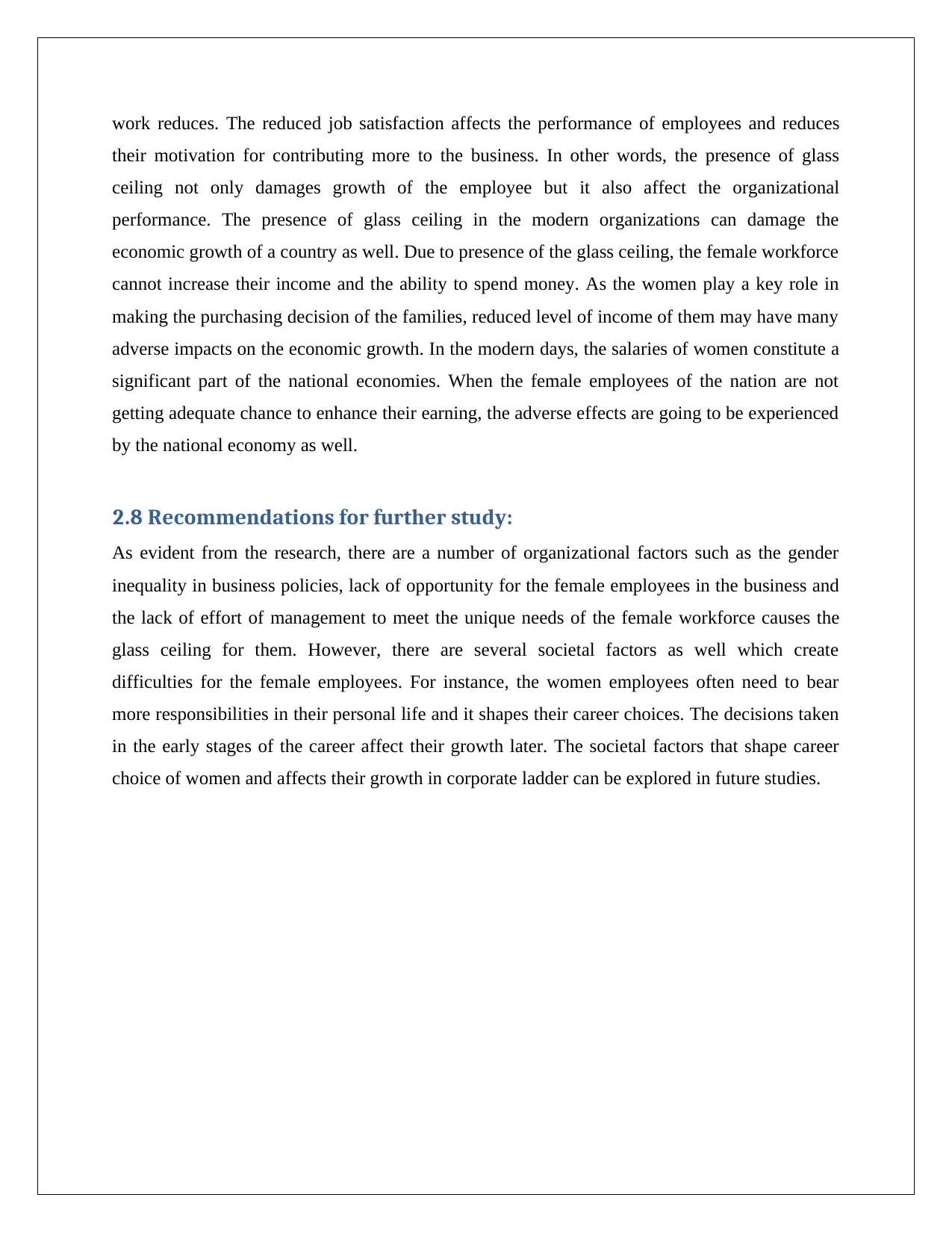
work reduces. The reduced job satisfaction affects the performance of employees and reduces
their motivation for contributing more to the business. In other words, the presence of glass
ceiling not only damages growth of the employee but it also affect the organizational
performance. The presence of glass ceiling in the modern organizations can damage the
economic growth of a country as well. Due to presence of the glass ceiling, the female workforce
cannot increase their income and the ability to spend money. As the women play a key role in
making the purchasing decision of the families, reduced level of income of them may have many
adverse impacts on the economic growth. In the modern days, the salaries of women constitute a
significant part of the national economies. When the female employees of the nation are not
getting adequate chance to enhance their earning, the adverse effects are going to be experienced
by the national economy as well.
2.8 Recommendations for further study:
As evident from the research, there are a number of organizational factors such as the gender
inequality in business policies, lack of opportunity for the female employees in the business and
the lack of effort of management to meet the unique needs of the female workforce causes the
glass ceiling for them. However, there are several societal factors as well which create
difficulties for the female employees. For instance, the women employees often need to bear
more responsibilities in their personal life and it shapes their career choices. The decisions taken
in the early stages of the career affect their growth later. The societal factors that shape career
choice of women and affects their growth in corporate ladder can be explored in future studies.
their motivation for contributing more to the business. In other words, the presence of glass
ceiling not only damages growth of the employee but it also affect the organizational
performance. The presence of glass ceiling in the modern organizations can damage the
economic growth of a country as well. Due to presence of the glass ceiling, the female workforce
cannot increase their income and the ability to spend money. As the women play a key role in
making the purchasing decision of the families, reduced level of income of them may have many
adverse impacts on the economic growth. In the modern days, the salaries of women constitute a
significant part of the national economies. When the female employees of the nation are not
getting adequate chance to enhance their earning, the adverse effects are going to be experienced
by the national economy as well.
2.8 Recommendations for further study:
As evident from the research, there are a number of organizational factors such as the gender
inequality in business policies, lack of opportunity for the female employees in the business and
the lack of effort of management to meet the unique needs of the female workforce causes the
glass ceiling for them. However, there are several societal factors as well which create
difficulties for the female employees. For instance, the women employees often need to bear
more responsibilities in their personal life and it shapes their career choices. The decisions taken
in the early stages of the career affect their growth later. The societal factors that shape career
choice of women and affects their growth in corporate ladder can be explored in future studies.
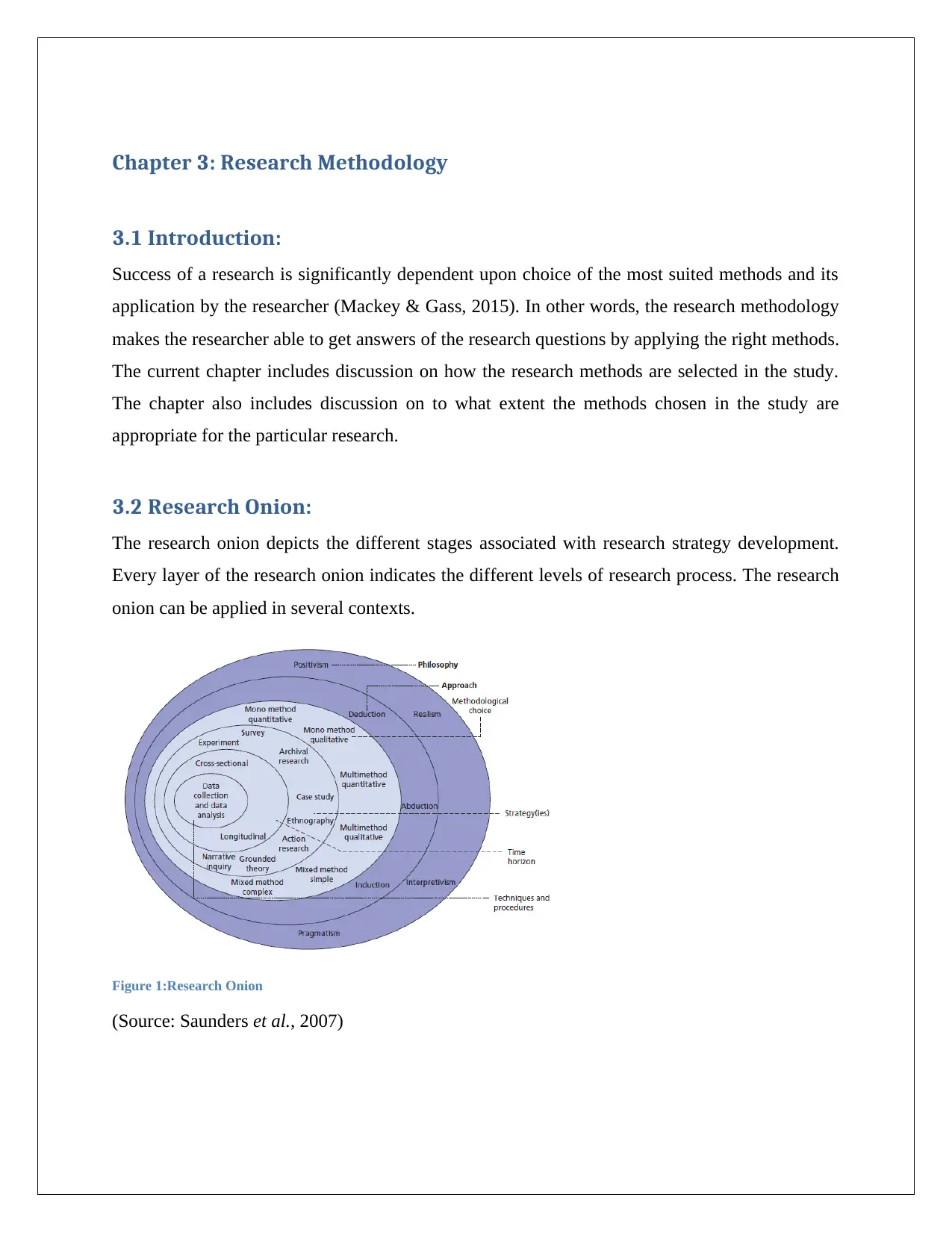
Chapter 3: Research Methodology
3.1 Introduction:
Success of a research is significantly dependent upon choice of the most suited methods and its
application by the researcher (Mackey & Gass, 2015). In other words, the research methodology
makes the researcher able to get answers of the research questions by applying the right methods.
The current chapter includes discussion on how the research methods are selected in the study.
The chapter also includes discussion on to what extent the methods chosen in the study are
appropriate for the particular research.
3.2 Research Onion:
The research onion depicts the different stages associated with research strategy development.
Every layer of the research onion indicates the different levels of research process. The research
onion can be applied in several contexts.
Figure 1:Research Onion
(Source: Saunders et al., 2007)
3.1 Introduction:
Success of a research is significantly dependent upon choice of the most suited methods and its
application by the researcher (Mackey & Gass, 2015). In other words, the research methodology
makes the researcher able to get answers of the research questions by applying the right methods.
The current chapter includes discussion on how the research methods are selected in the study.
The chapter also includes discussion on to what extent the methods chosen in the study are
appropriate for the particular research.
3.2 Research Onion:
The research onion depicts the different stages associated with research strategy development.
Every layer of the research onion indicates the different levels of research process. The research
onion can be applied in several contexts.
Figure 1:Research Onion
(Source: Saunders et al., 2007)
Paraphrase This Document
Need a fresh take? Get an instant paraphrase of this document with our AI Paraphraser

3.3 Research Philosophy:
Choice of the research methodology is an important aspect of research methodology. The
research philosophy indicates the primary belief hold by the researcher while conducting the
study (Lewis, 2015). On basis of the chosen research philosophy, the researcher executes rest
part of the research.
A research philosophy can be viewed from two different perspectives-- the ontological
perspectives and the epistemological perspectives. The ontological view focuses on analyzing the
nature of reality. In other words, the ontology gives importance on how an individual interprets a
fact (Lewis, 2015). On the contrary, the epistemology gives importance on analyzing the sources
of knowledge. In other words, the epistemology gives importance on conducting the research n
basis of the factors which are known to be true (Panneerselvam, 2014). The current study is
conducted from the epistemological view.
The realism philosophy helps the researcher to create the knowledge in a scientific manner. The
realism philosophy is further categorized into the direct realism as well as critical realism. The
direct realism enables the researcher to information collected through the observation. On the
other hand, the critical realism facilitates the researcher to use own senses to interpret the
collected information.
The positivism philosophy relies highly on the interpretation skill of the researcher. The
positivism philosophy gives importance on using the factual knowledge that the researcher
collects either through observation, applications of senses or through the measurement (Flick,
2015). Use of the positivism research also facilitates the researcher to express findings of the
study quantitatively.
The interpretivist philosophy facilitates the researcher to interpret reality through own senses,
shared meaning, knowledge and observation (Flick, 2015). In addition, use of the interpretivist
philosophy also enables the researcher to analyze the issue under study from multiple aspects.
The current research focuses on analyzing the effects of glass ceiling in the organization. The
research also gives importance on identifying the ways to reduce the adverse effects of glass
ceiling on the business. Here, the researcher requires using the information obtained from the
reality as well as the own logic senses and interpretation skill. The positivism philosophy, in this
Choice of the research methodology is an important aspect of research methodology. The
research philosophy indicates the primary belief hold by the researcher while conducting the
study (Lewis, 2015). On basis of the chosen research philosophy, the researcher executes rest
part of the research.
A research philosophy can be viewed from two different perspectives-- the ontological
perspectives and the epistemological perspectives. The ontological view focuses on analyzing the
nature of reality. In other words, the ontology gives importance on how an individual interprets a
fact (Lewis, 2015). On the contrary, the epistemology gives importance on analyzing the sources
of knowledge. In other words, the epistemology gives importance on conducting the research n
basis of the factors which are known to be true (Panneerselvam, 2014). The current study is
conducted from the epistemological view.
The realism philosophy helps the researcher to create the knowledge in a scientific manner. The
realism philosophy is further categorized into the direct realism as well as critical realism. The
direct realism enables the researcher to information collected through the observation. On the
other hand, the critical realism facilitates the researcher to use own senses to interpret the
collected information.
The positivism philosophy relies highly on the interpretation skill of the researcher. The
positivism philosophy gives importance on using the factual knowledge that the researcher
collects either through observation, applications of senses or through the measurement (Flick,
2015). Use of the positivism research also facilitates the researcher to express findings of the
study quantitatively.
The interpretivist philosophy facilitates the researcher to interpret reality through own senses,
shared meaning, knowledge and observation (Flick, 2015). In addition, use of the interpretivist
philosophy also enables the researcher to analyze the issue under study from multiple aspects.
The current research focuses on analyzing the effects of glass ceiling in the organization. The
research also gives importance on identifying the ways to reduce the adverse effects of glass
ceiling on the business. Here, the researcher requires using the information obtained from the
reality as well as the own logic senses and interpretation skill. The positivism philosophy, in this
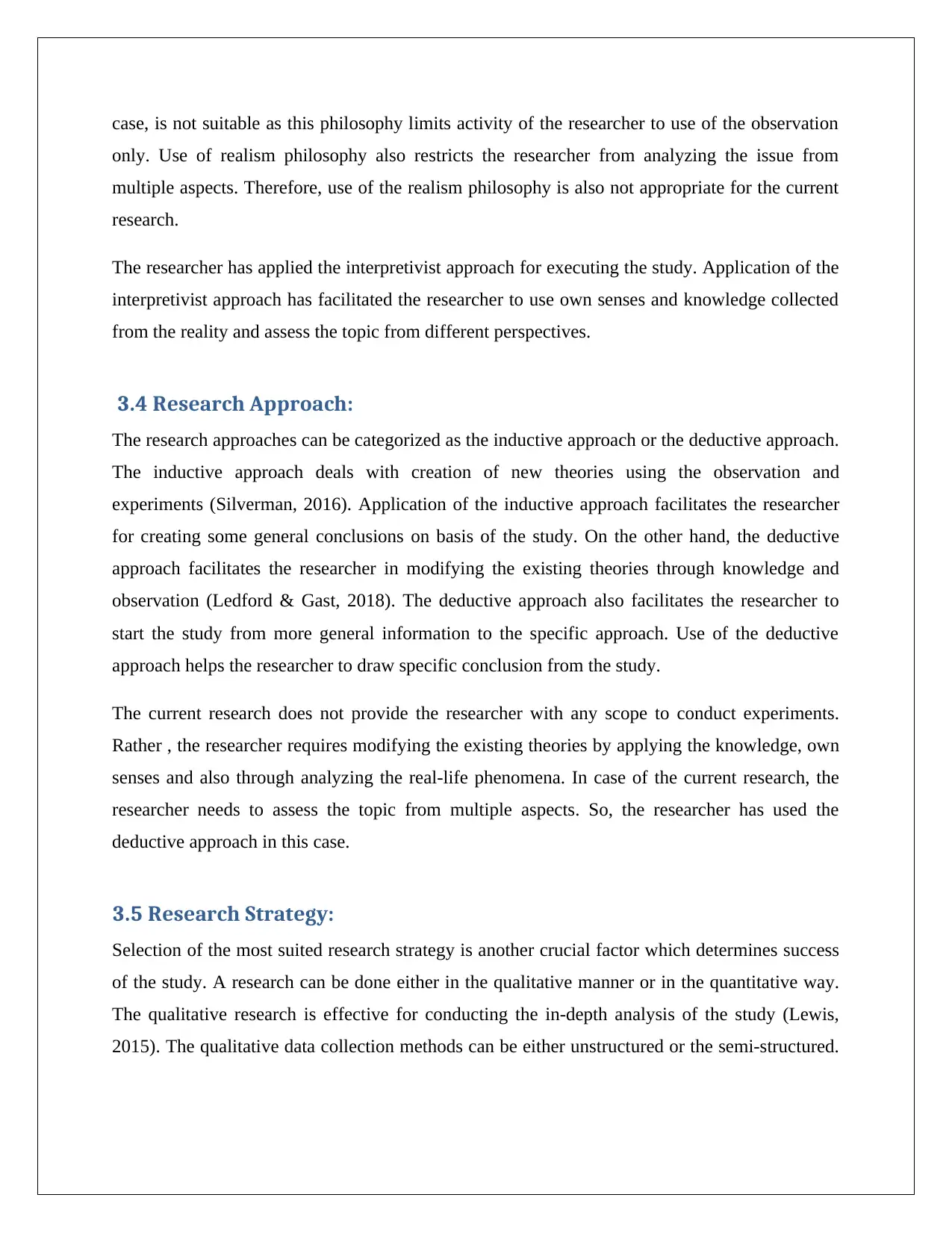
case, is not suitable as this philosophy limits activity of the researcher to use of the observation
only. Use of realism philosophy also restricts the researcher from analyzing the issue from
multiple aspects. Therefore, use of the realism philosophy is also not appropriate for the current
research.
The researcher has applied the interpretivist approach for executing the study. Application of the
interpretivist approach has facilitated the researcher to use own senses and knowledge collected
from the reality and assess the topic from different perspectives.
3.4 Research Approach:
The research approaches can be categorized as the inductive approach or the deductive approach.
The inductive approach deals with creation of new theories using the observation and
experiments (Silverman, 2016). Application of the inductive approach facilitates the researcher
for creating some general conclusions on basis of the study. On the other hand, the deductive
approach facilitates the researcher in modifying the existing theories through knowledge and
observation (Ledford & Gast, 2018). The deductive approach also facilitates the researcher to
start the study from more general information to the specific approach. Use of the deductive
approach helps the researcher to draw specific conclusion from the study.
The current research does not provide the researcher with any scope to conduct experiments.
Rather , the researcher requires modifying the existing theories by applying the knowledge, own
senses and also through analyzing the real-life phenomena. In case of the current research, the
researcher needs to assess the topic from multiple aspects. So, the researcher has used the
deductive approach in this case.
3.5 Research Strategy:
Selection of the most suited research strategy is another crucial factor which determines success
of the study. A research can be done either in the qualitative manner or in the quantitative way.
The qualitative research is effective for conducting the in-depth analysis of the study (Lewis,
2015). The qualitative data collection methods can be either unstructured or the semi-structured.
only. Use of realism philosophy also restricts the researcher from analyzing the issue from
multiple aspects. Therefore, use of the realism philosophy is also not appropriate for the current
research.
The researcher has applied the interpretivist approach for executing the study. Application of the
interpretivist approach has facilitated the researcher to use own senses and knowledge collected
from the reality and assess the topic from different perspectives.
3.4 Research Approach:
The research approaches can be categorized as the inductive approach or the deductive approach.
The inductive approach deals with creation of new theories using the observation and
experiments (Silverman, 2016). Application of the inductive approach facilitates the researcher
for creating some general conclusions on basis of the study. On the other hand, the deductive
approach facilitates the researcher in modifying the existing theories through knowledge and
observation (Ledford & Gast, 2018). The deductive approach also facilitates the researcher to
start the study from more general information to the specific approach. Use of the deductive
approach helps the researcher to draw specific conclusion from the study.
The current research does not provide the researcher with any scope to conduct experiments.
Rather , the researcher requires modifying the existing theories by applying the knowledge, own
senses and also through analyzing the real-life phenomena. In case of the current research, the
researcher needs to assess the topic from multiple aspects. So, the researcher has used the
deductive approach in this case.
3.5 Research Strategy:
Selection of the most suited research strategy is another crucial factor which determines success
of the study. A research can be done either in the qualitative manner or in the quantitative way.
The qualitative research is effective for conducting the in-depth analysis of the study (Lewis,
2015). The qualitative data collection methods can be either unstructured or the semi-structured.
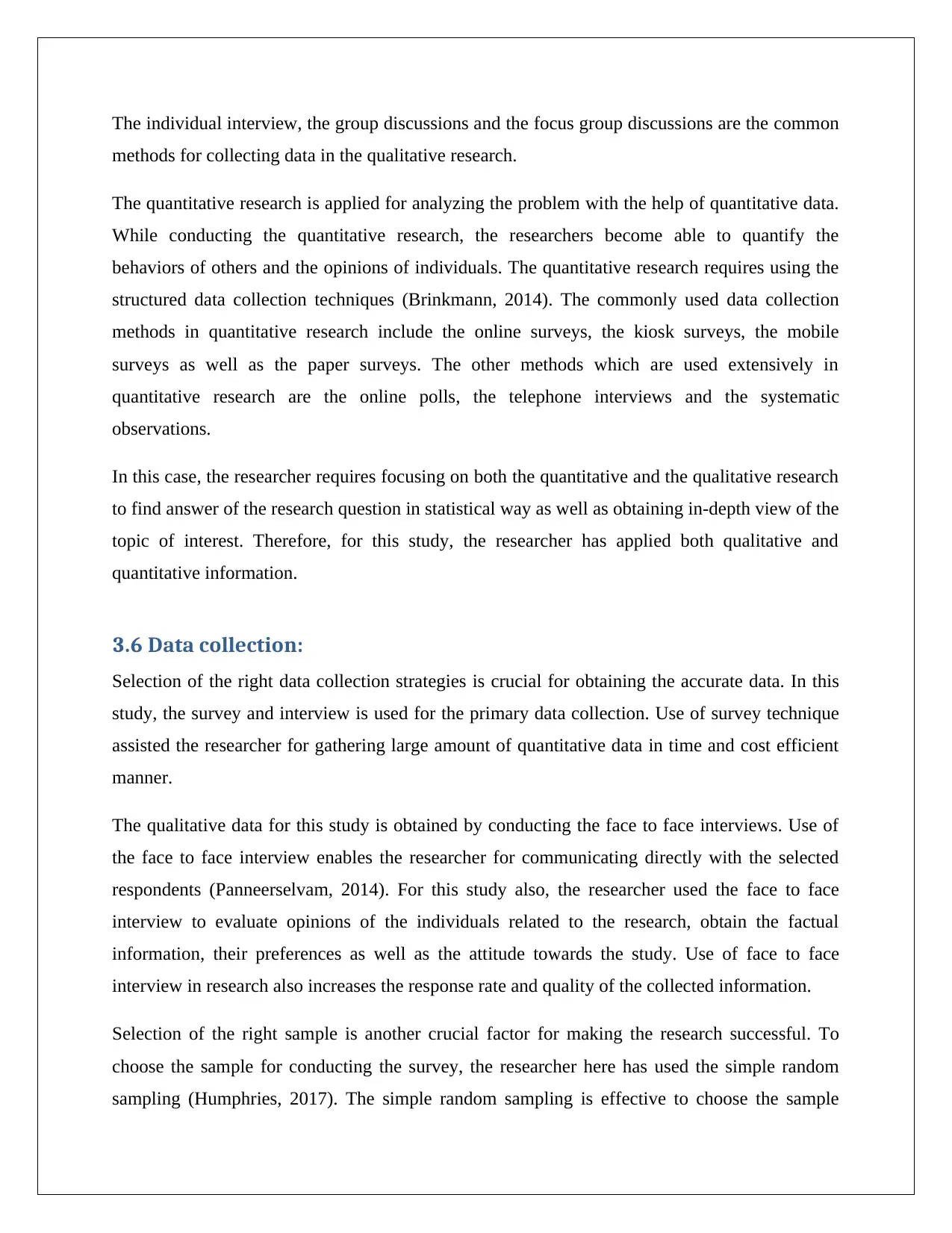
The individual interview, the group discussions and the focus group discussions are the common
methods for collecting data in the qualitative research.
The quantitative research is applied for analyzing the problem with the help of quantitative data.
While conducting the quantitative research, the researchers become able to quantify the
behaviors of others and the opinions of individuals. The quantitative research requires using the
structured data collection techniques (Brinkmann, 2014). The commonly used data collection
methods in quantitative research include the online surveys, the kiosk surveys, the mobile
surveys as well as the paper surveys. The other methods which are used extensively in
quantitative research are the online polls, the telephone interviews and the systematic
observations.
In this case, the researcher requires focusing on both the quantitative and the qualitative research
to find answer of the research question in statistical way as well as obtaining in-depth view of the
topic of interest. Therefore, for this study, the researcher has applied both qualitative and
quantitative information.
3.6 Data collection:
Selection of the right data collection strategies is crucial for obtaining the accurate data. In this
study, the survey and interview is used for the primary data collection. Use of survey technique
assisted the researcher for gathering large amount of quantitative data in time and cost efficient
manner.
The qualitative data for this study is obtained by conducting the face to face interviews. Use of
the face to face interview enables the researcher for communicating directly with the selected
respondents (Panneerselvam, 2014). For this study also, the researcher used the face to face
interview to evaluate opinions of the individuals related to the research, obtain the factual
information, their preferences as well as the attitude towards the study. Use of face to face
interview in research also increases the response rate and quality of the collected information.
Selection of the right sample is another crucial factor for making the research successful. To
choose the sample for conducting the survey, the researcher here has used the simple random
sampling (Humphries, 2017). The simple random sampling is effective to choose the sample
methods for collecting data in the qualitative research.
The quantitative research is applied for analyzing the problem with the help of quantitative data.
While conducting the quantitative research, the researchers become able to quantify the
behaviors of others and the opinions of individuals. The quantitative research requires using the
structured data collection techniques (Brinkmann, 2014). The commonly used data collection
methods in quantitative research include the online surveys, the kiosk surveys, the mobile
surveys as well as the paper surveys. The other methods which are used extensively in
quantitative research are the online polls, the telephone interviews and the systematic
observations.
In this case, the researcher requires focusing on both the quantitative and the qualitative research
to find answer of the research question in statistical way as well as obtaining in-depth view of the
topic of interest. Therefore, for this study, the researcher has applied both qualitative and
quantitative information.
3.6 Data collection:
Selection of the right data collection strategies is crucial for obtaining the accurate data. In this
study, the survey and interview is used for the primary data collection. Use of survey technique
assisted the researcher for gathering large amount of quantitative data in time and cost efficient
manner.
The qualitative data for this study is obtained by conducting the face to face interviews. Use of
the face to face interview enables the researcher for communicating directly with the selected
respondents (Panneerselvam, 2014). For this study also, the researcher used the face to face
interview to evaluate opinions of the individuals related to the research, obtain the factual
information, their preferences as well as the attitude towards the study. Use of face to face
interview in research also increases the response rate and quality of the collected information.
Selection of the right sample is another crucial factor for making the research successful. To
choose the sample for conducting the survey, the researcher here has used the simple random
sampling (Humphries, 2017). The simple random sampling is effective to choose the sample
Secure Best Marks with AI Grader
Need help grading? Try our AI Grader for instant feedback on your assignments.
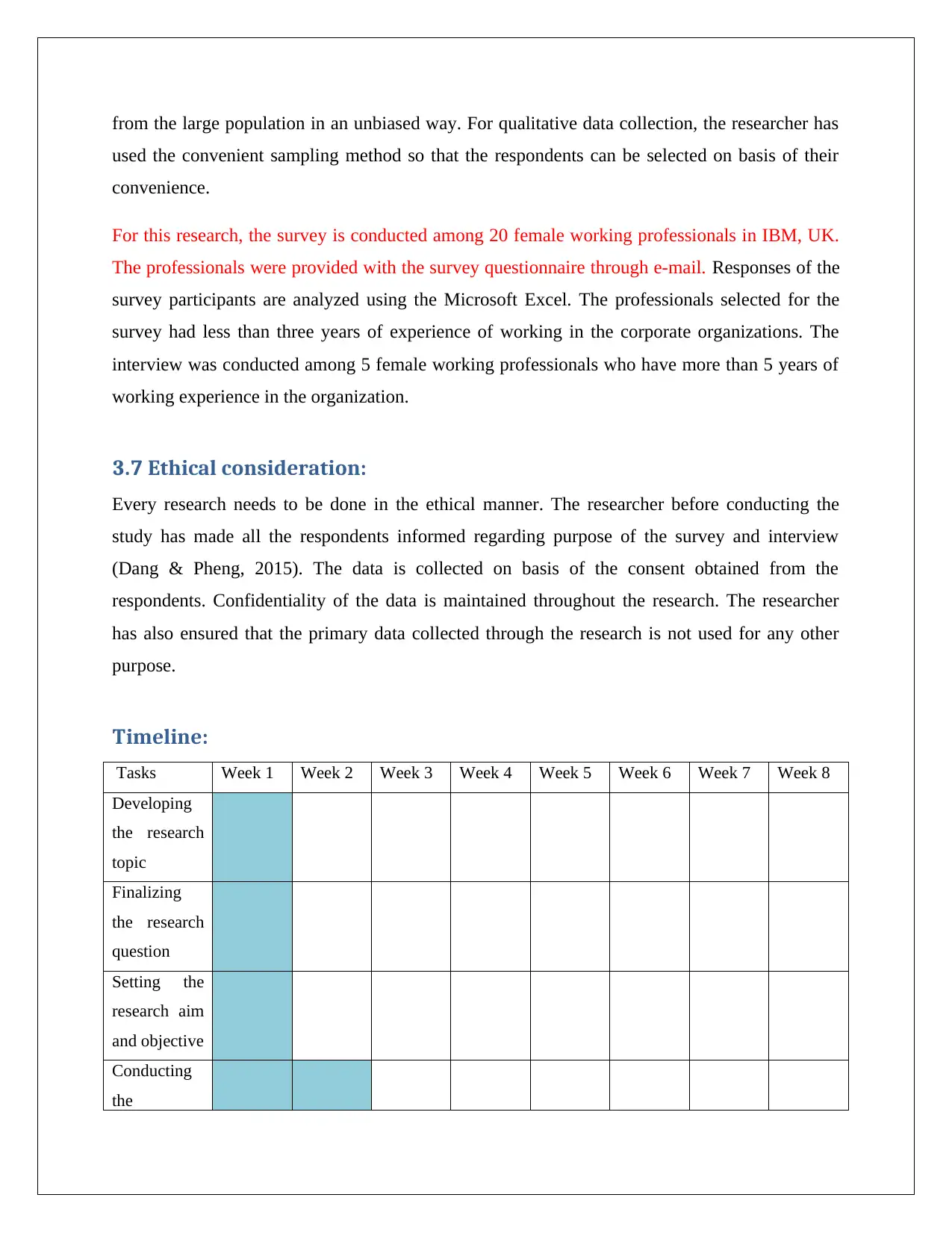
from the large population in an unbiased way. For qualitative data collection, the researcher has
used the convenient sampling method so that the respondents can be selected on basis of their
convenience.
For this research, the survey is conducted among 20 female working professionals in IBM, UK.
The professionals were provided with the survey questionnaire through e-mail. Responses of the
survey participants are analyzed using the Microsoft Excel. The professionals selected for the
survey had less than three years of experience of working in the corporate organizations. The
interview was conducted among 5 female working professionals who have more than 5 years of
working experience in the organization.
3.7 Ethical consideration:
Every research needs to be done in the ethical manner. The researcher before conducting the
study has made all the respondents informed regarding purpose of the survey and interview
(Dang & Pheng, 2015). The data is collected on basis of the consent obtained from the
respondents. Confidentiality of the data is maintained throughout the research. The researcher
has also ensured that the primary data collected through the research is not used for any other
purpose.
Timeline:
Tasks Week 1 Week 2 Week 3 Week 4 Week 5 Week 6 Week 7 Week 8
Developing
the research
topic
Finalizing
the research
question
Setting the
research aim
and objective
Conducting
the
used the convenient sampling method so that the respondents can be selected on basis of their
convenience.
For this research, the survey is conducted among 20 female working professionals in IBM, UK.
The professionals were provided with the survey questionnaire through e-mail. Responses of the
survey participants are analyzed using the Microsoft Excel. The professionals selected for the
survey had less than three years of experience of working in the corporate organizations. The
interview was conducted among 5 female working professionals who have more than 5 years of
working experience in the organization.
3.7 Ethical consideration:
Every research needs to be done in the ethical manner. The researcher before conducting the
study has made all the respondents informed regarding purpose of the survey and interview
(Dang & Pheng, 2015). The data is collected on basis of the consent obtained from the
respondents. Confidentiality of the data is maintained throughout the research. The researcher
has also ensured that the primary data collected through the research is not used for any other
purpose.
Timeline:
Tasks Week 1 Week 2 Week 3 Week 4 Week 5 Week 6 Week 7 Week 8
Developing
the research
topic
Finalizing
the research
question
Setting the
research aim
and objective
Conducting
the
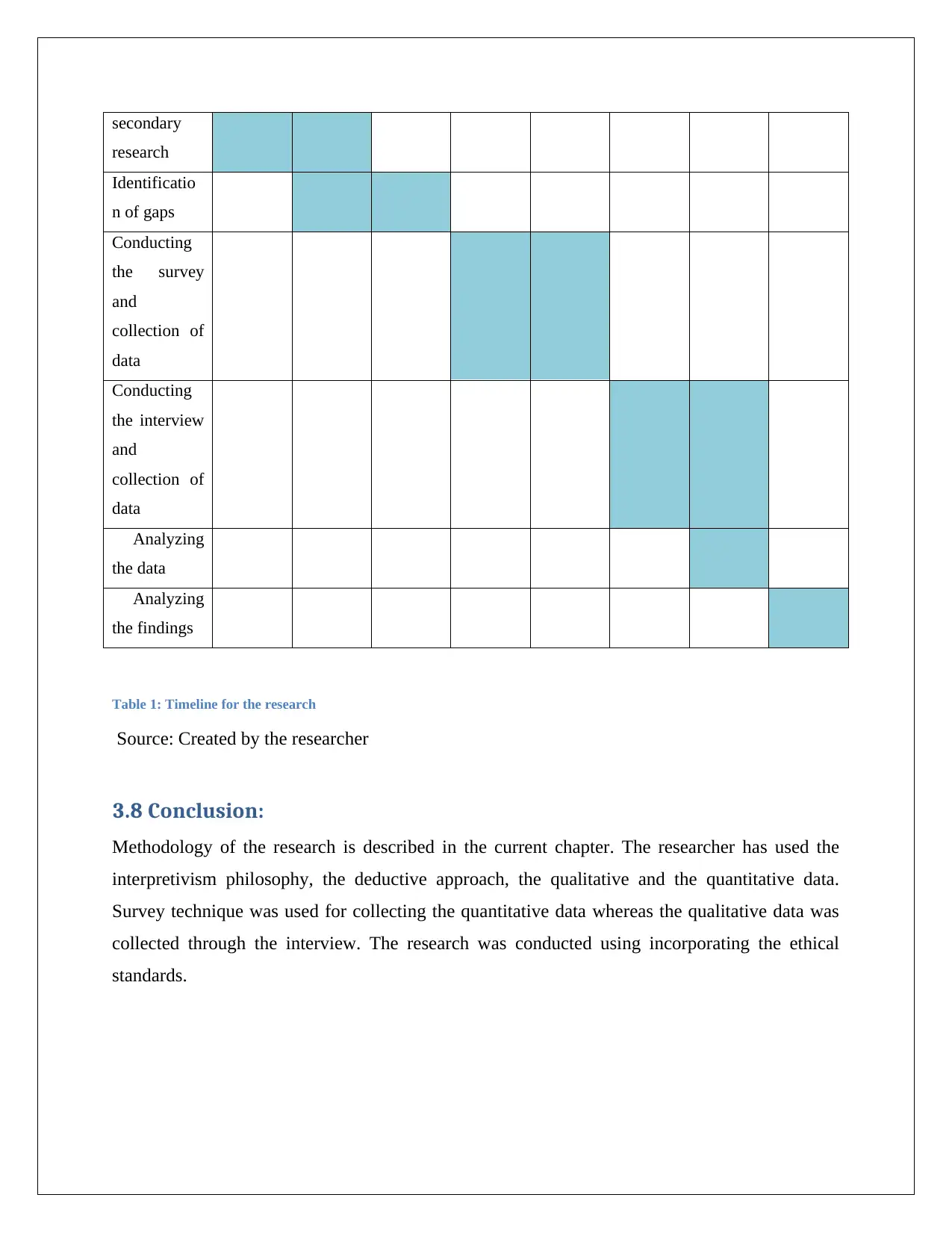
secondary
research
Identificatio
n of gaps
Conducting
the survey
and
collection of
data
Conducting
the interview
and
collection of
data
Analyzing
the data
Analyzing
the findings
Table 1: Timeline for the research
Source: Created by the researcher
3.8 Conclusion:
Methodology of the research is described in the current chapter. The researcher has used the
interpretivism philosophy, the deductive approach, the qualitative and the quantitative data.
Survey technique was used for collecting the quantitative data whereas the qualitative data was
collected through the interview. The research was conducted using incorporating the ethical
standards.
research
Identificatio
n of gaps
Conducting
the survey
and
collection of
data
Conducting
the interview
and
collection of
data
Analyzing
the data
Analyzing
the findings
Table 1: Timeline for the research
Source: Created by the researcher
3.8 Conclusion:
Methodology of the research is described in the current chapter. The researcher has used the
interpretivism philosophy, the deductive approach, the qualitative and the quantitative data.
Survey technique was used for collecting the quantitative data whereas the qualitative data was
collected through the interview. The research was conducted using incorporating the ethical
standards.
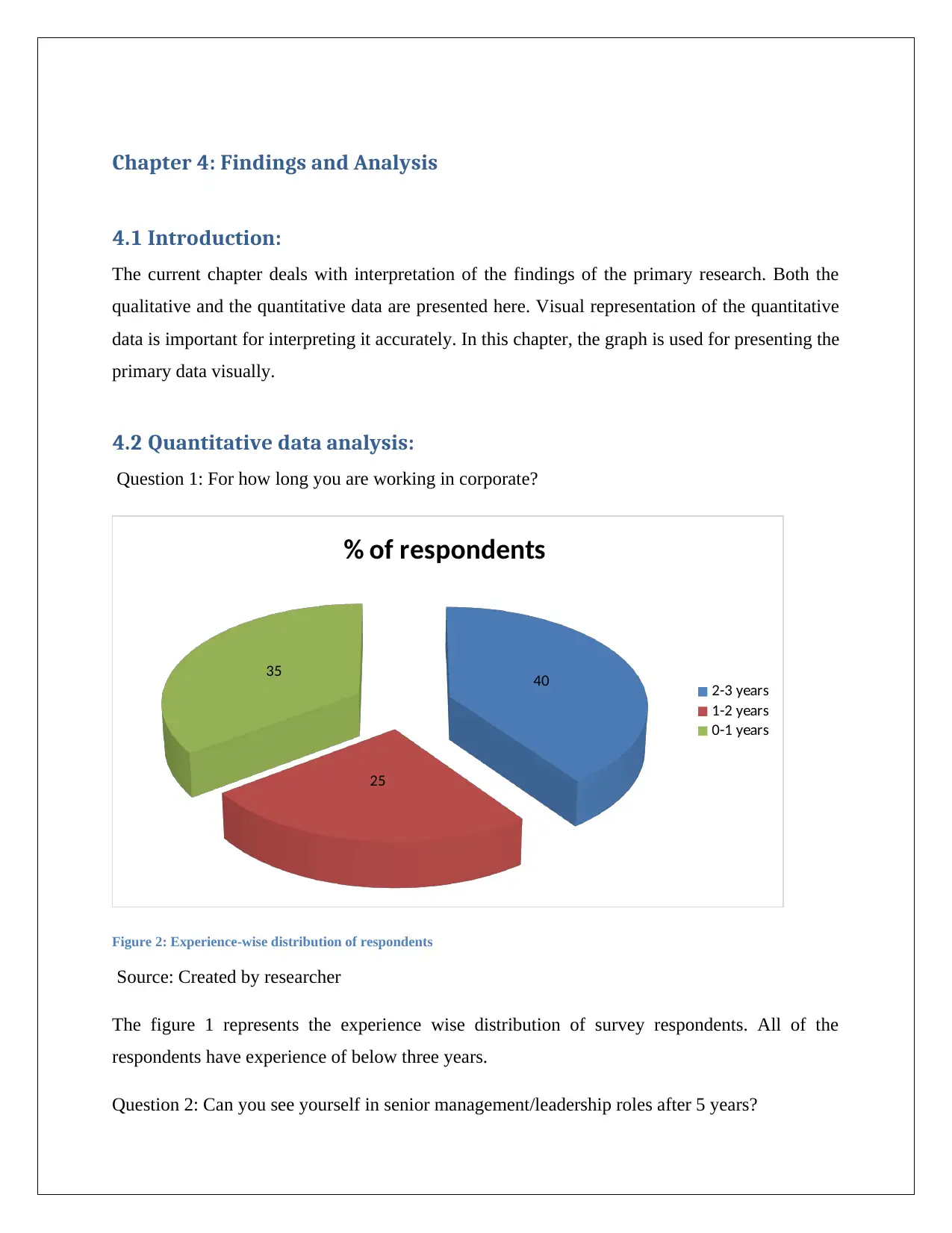
Chapter 4: Findings and Analysis
4.1 Introduction:
The current chapter deals with interpretation of the findings of the primary research. Both the
qualitative and the quantitative data are presented here. Visual representation of the quantitative
data is important for interpreting it accurately. In this chapter, the graph is used for presenting the
primary data visually.
4.2 Quantitative data analysis:
Question 1: For how long you are working in corporate?
40
25
35
% of respondents
2-3 years
1-2 years
0-1 years
Figure 2: Experience-wise distribution of respondents
Source: Created by researcher
The figure 1 represents the experience wise distribution of survey respondents. All of the
respondents have experience of below three years.
Question 2: Can you see yourself in senior management/leadership roles after 5 years?
4.1 Introduction:
The current chapter deals with interpretation of the findings of the primary research. Both the
qualitative and the quantitative data are presented here. Visual representation of the quantitative
data is important for interpreting it accurately. In this chapter, the graph is used for presenting the
primary data visually.
4.2 Quantitative data analysis:
Question 1: For how long you are working in corporate?
40
25
35
% of respondents
2-3 years
1-2 years
0-1 years
Figure 2: Experience-wise distribution of respondents
Source: Created by researcher
The figure 1 represents the experience wise distribution of survey respondents. All of the
respondents have experience of below three years.
Question 2: Can you see yourself in senior management/leadership roles after 5 years?
Paraphrase This Document
Need a fresh take? Get an instant paraphrase of this document with our AI Paraphraser

15
25
20
30
10
Opinion of respondents on senior roles
Definitely yes
Yes
Not sure
No
Definitely No
Figure 3: Opinion of respondents on senior roles
Source: Created by Researcher
The figure 2 indicates that a larger portion of the female employees in the corporate
organizations are not confident regarding their promotion to senior roles after several years. The
literature review (Refer to the discussion on Glass ceiling in the modern organizations) also
indicates that the female employees in the corporate organizations often do not have clear idea
on their roles in the senior positions.
Question 3: Is there any gender based bias in your organization?
25
20
30
10
Opinion of respondents on senior roles
Definitely yes
Yes
Not sure
No
Definitely No
Figure 3: Opinion of respondents on senior roles
Source: Created by Researcher
The figure 2 indicates that a larger portion of the female employees in the corporate
organizations are not confident regarding their promotion to senior roles after several years. The
literature review (Refer to the discussion on Glass ceiling in the modern organizations) also
indicates that the female employees in the corporate organizations often do not have clear idea
on their roles in the senior positions.
Question 3: Is there any gender based bias in your organization?
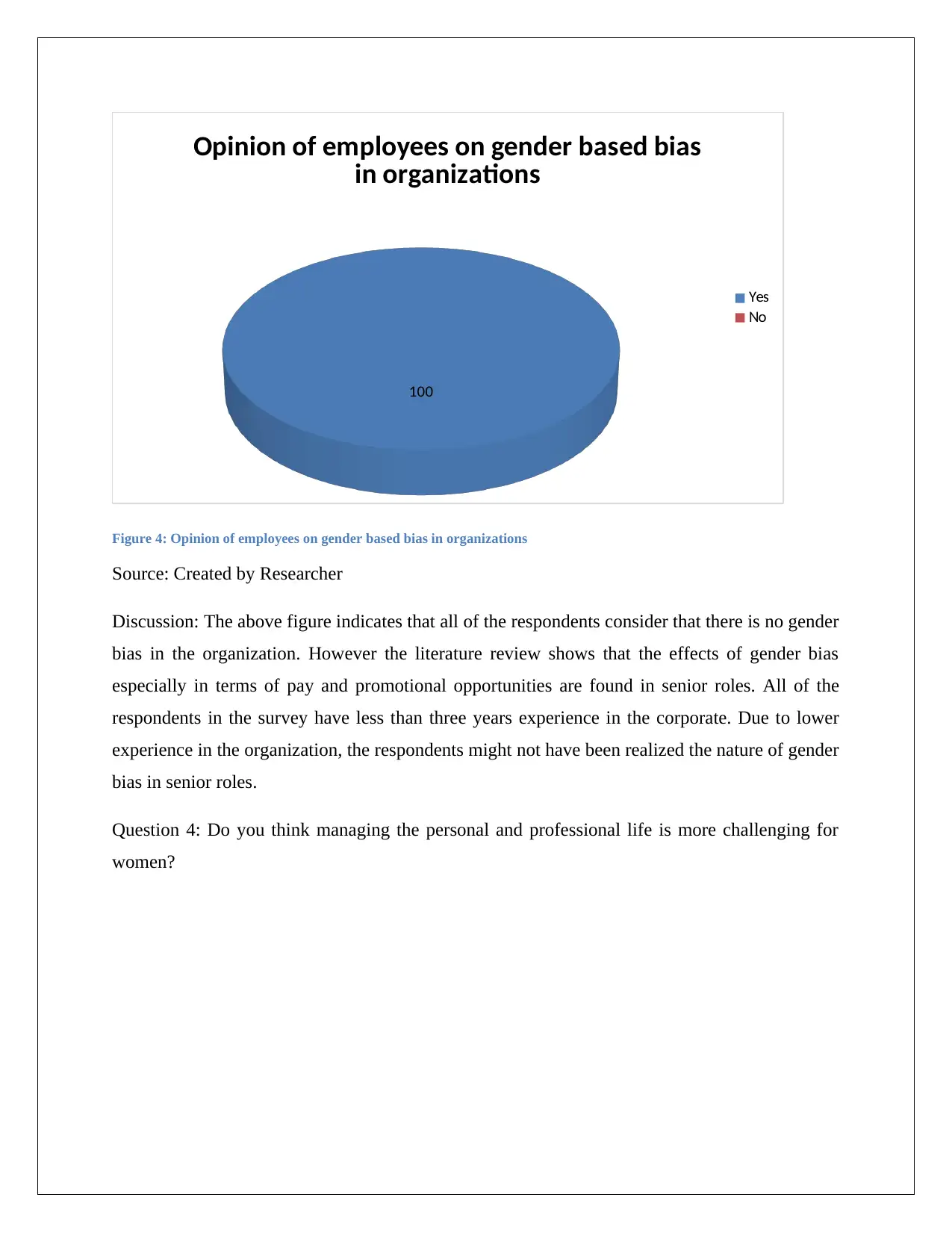
100
Opinion of employees on gender based bias
in organizations
Yes
No
Figure 4: Opinion of employees on gender based bias in organizations
Source: Created by Researcher
Discussion: The above figure indicates that all of the respondents consider that there is no gender
bias in the organization. However the literature review shows that the effects of gender bias
especially in terms of pay and promotional opportunities are found in senior roles. All of the
respondents in the survey have less than three years experience in the corporate. Due to lower
experience in the organization, the respondents might not have been realized the nature of gender
bias in senior roles.
Question 4: Do you think managing the personal and professional life is more challenging for
women?
Opinion of employees on gender based bias
in organizations
Yes
No
Figure 4: Opinion of employees on gender based bias in organizations
Source: Created by Researcher
Discussion: The above figure indicates that all of the respondents consider that there is no gender
bias in the organization. However the literature review shows that the effects of gender bias
especially in terms of pay and promotional opportunities are found in senior roles. All of the
respondents in the survey have less than three years experience in the corporate. Due to lower
experience in the organization, the respondents might not have been realized the nature of gender
bias in senior roles.
Question 4: Do you think managing the personal and professional life is more challenging for
women?
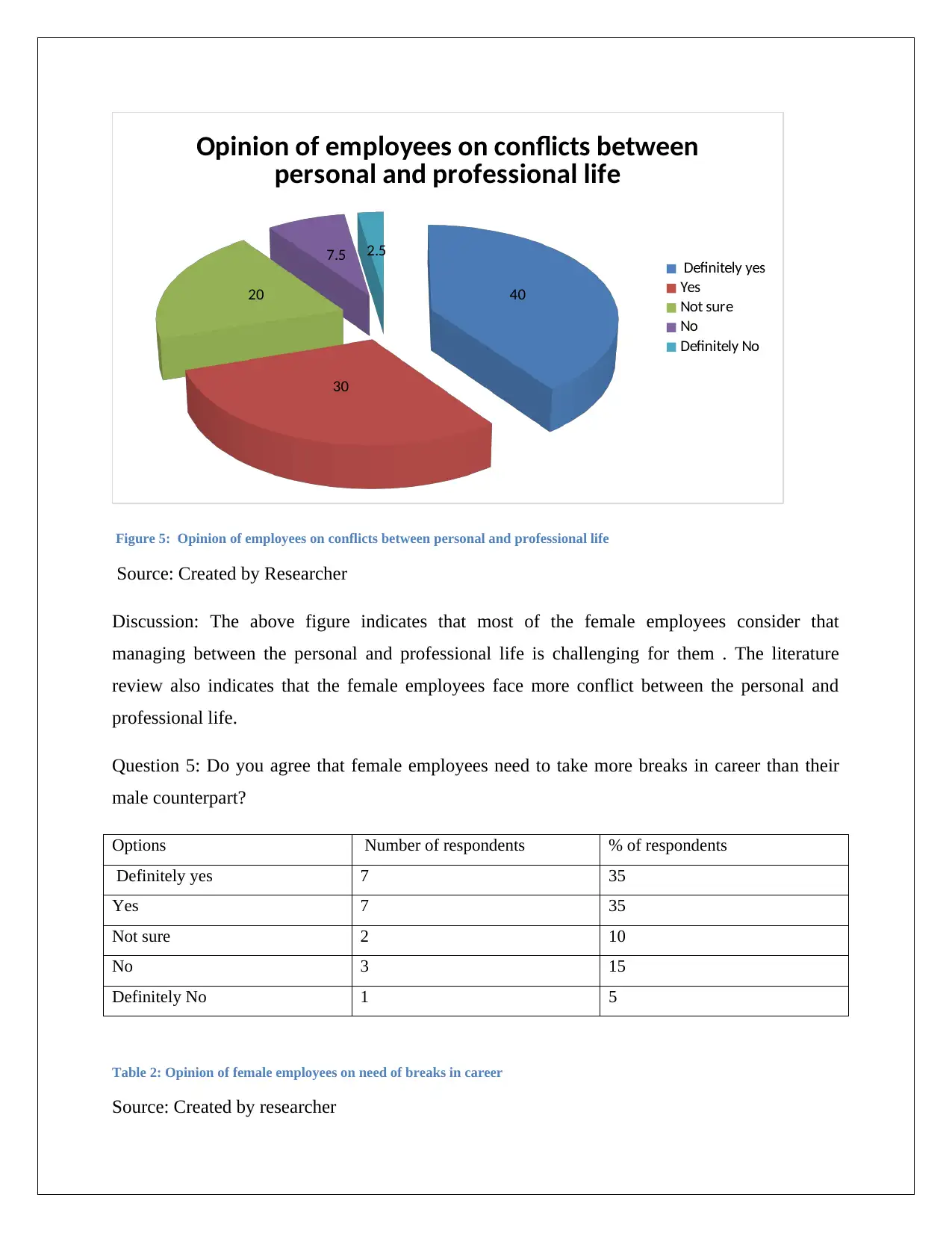
40
30
20
7.5 2.5
Opinion of employees on conflicts between
personal and professional life
Definitely yes
Yes
Not sure
No
Definitely No
Figure 5: Opinion of employees on conflicts between personal and professional life
Source: Created by Researcher
Discussion: The above figure indicates that most of the female employees consider that
managing between the personal and professional life is challenging for them . The literature
review also indicates that the female employees face more conflict between the personal and
professional life.
Question 5: Do you agree that female employees need to take more breaks in career than their
male counterpart?
Options Number of respondents % of respondents
Definitely yes 7 35
Yes 7 35
Not sure 2 10
No 3 15
Definitely No 1 5
Table 2: Opinion of female employees on need of breaks in career
Source: Created by researcher
30
20
7.5 2.5
Opinion of employees on conflicts between
personal and professional life
Definitely yes
Yes
Not sure
No
Definitely No
Figure 5: Opinion of employees on conflicts between personal and professional life
Source: Created by Researcher
Discussion: The above figure indicates that most of the female employees consider that
managing between the personal and professional life is challenging for them . The literature
review also indicates that the female employees face more conflict between the personal and
professional life.
Question 5: Do you agree that female employees need to take more breaks in career than their
male counterpart?
Options Number of respondents % of respondents
Definitely yes 7 35
Yes 7 35
Not sure 2 10
No 3 15
Definitely No 1 5
Table 2: Opinion of female employees on need of breaks in career
Source: Created by researcher
Secure Best Marks with AI Grader
Need help grading? Try our AI Grader for instant feedback on your assignments.
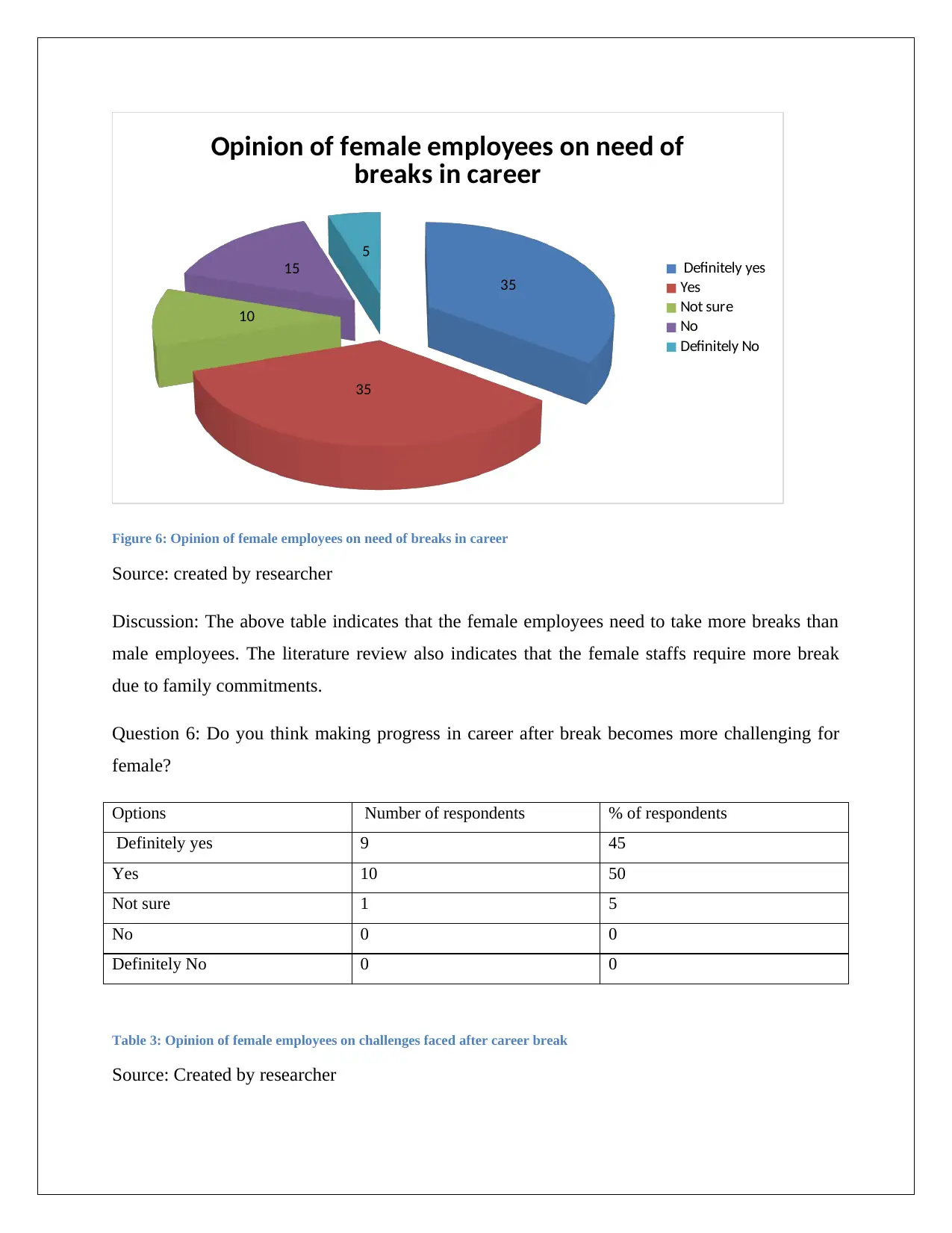
35
35
10
15
5
Opinion of female employees on need of
breaks in career
Definitely yes
Yes
Not sure
No
Definitely No
Figure 6: Opinion of female employees on need of breaks in career
Source: created by researcher
Discussion: The above table indicates that the female employees need to take more breaks than
male employees. The literature review also indicates that the female staffs require more break
due to family commitments.
Question 6: Do you think making progress in career after break becomes more challenging for
female?
Options Number of respondents % of respondents
Definitely yes 9 45
Yes 10 50
Not sure 1 5
No 0 0
Definitely No 0 0
Table 3: Opinion of female employees on challenges faced after career break
Source: Created by researcher
35
10
15
5
Opinion of female employees on need of
breaks in career
Definitely yes
Yes
Not sure
No
Definitely No
Figure 6: Opinion of female employees on need of breaks in career
Source: created by researcher
Discussion: The above table indicates that the female employees need to take more breaks than
male employees. The literature review also indicates that the female staffs require more break
due to family commitments.
Question 6: Do you think making progress in career after break becomes more challenging for
female?
Options Number of respondents % of respondents
Definitely yes 9 45
Yes 10 50
Not sure 1 5
No 0 0
Definitely No 0 0
Table 3: Opinion of female employees on challenges faced after career break
Source: Created by researcher
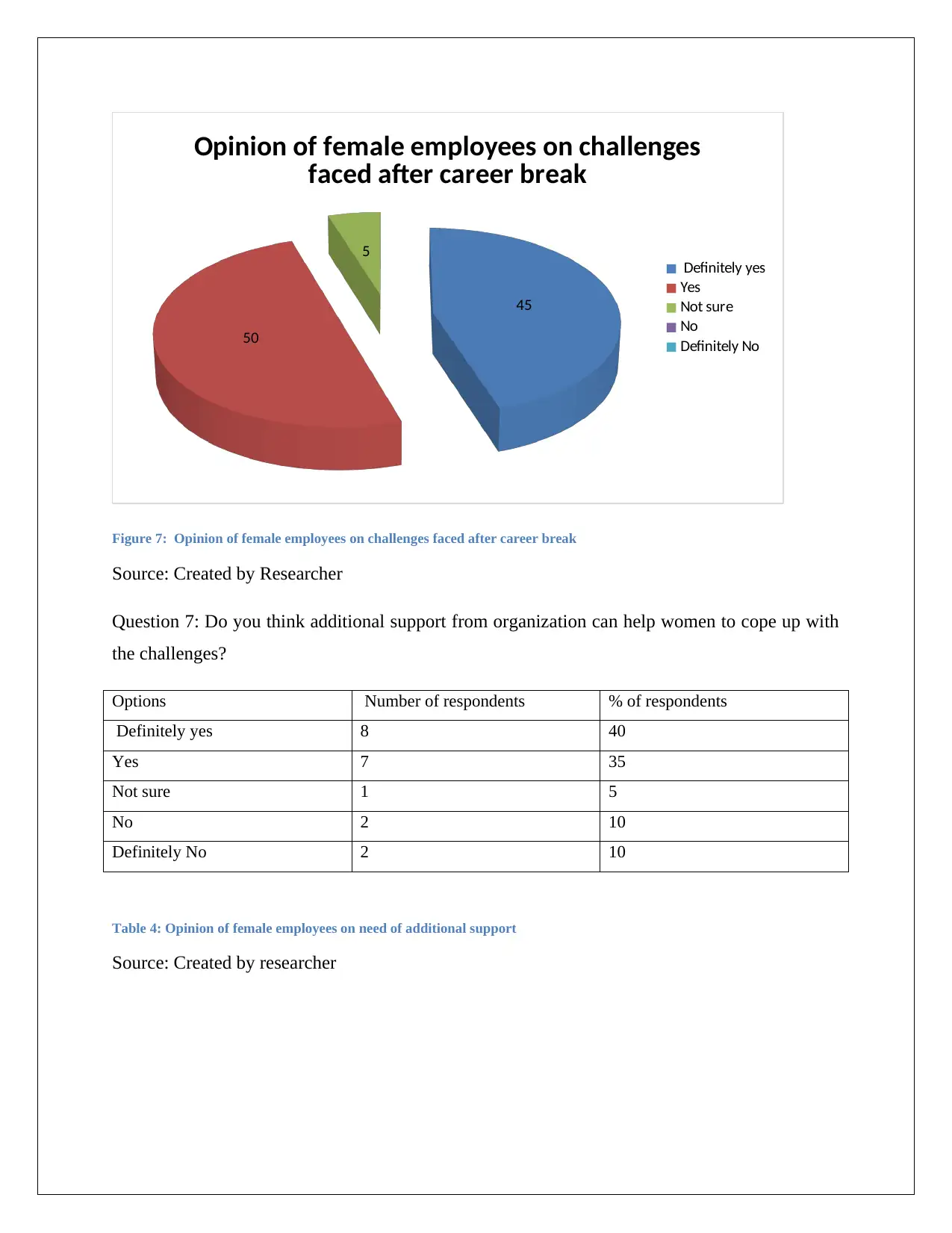
45
50
5
Opinion of female employees on challenges
faced after career break
Definitely yes
Yes
Not sure
No
Definitely No
Figure 7: Opinion of female employees on challenges faced after career break
Source: Created by Researcher
Question 7: Do you think additional support from organization can help women to cope up with
the challenges?
Options Number of respondents % of respondents
Definitely yes 8 40
Yes 7 35
Not sure 1 5
No 2 10
Definitely No 2 10
Table 4: Opinion of female employees on need of additional support
Source: Created by researcher
50
5
Opinion of female employees on challenges
faced after career break
Definitely yes
Yes
Not sure
No
Definitely No
Figure 7: Opinion of female employees on challenges faced after career break
Source: Created by Researcher
Question 7: Do you think additional support from organization can help women to cope up with
the challenges?
Options Number of respondents % of respondents
Definitely yes 8 40
Yes 7 35
Not sure 1 5
No 2 10
Definitely No 2 10
Table 4: Opinion of female employees on need of additional support
Source: Created by researcher
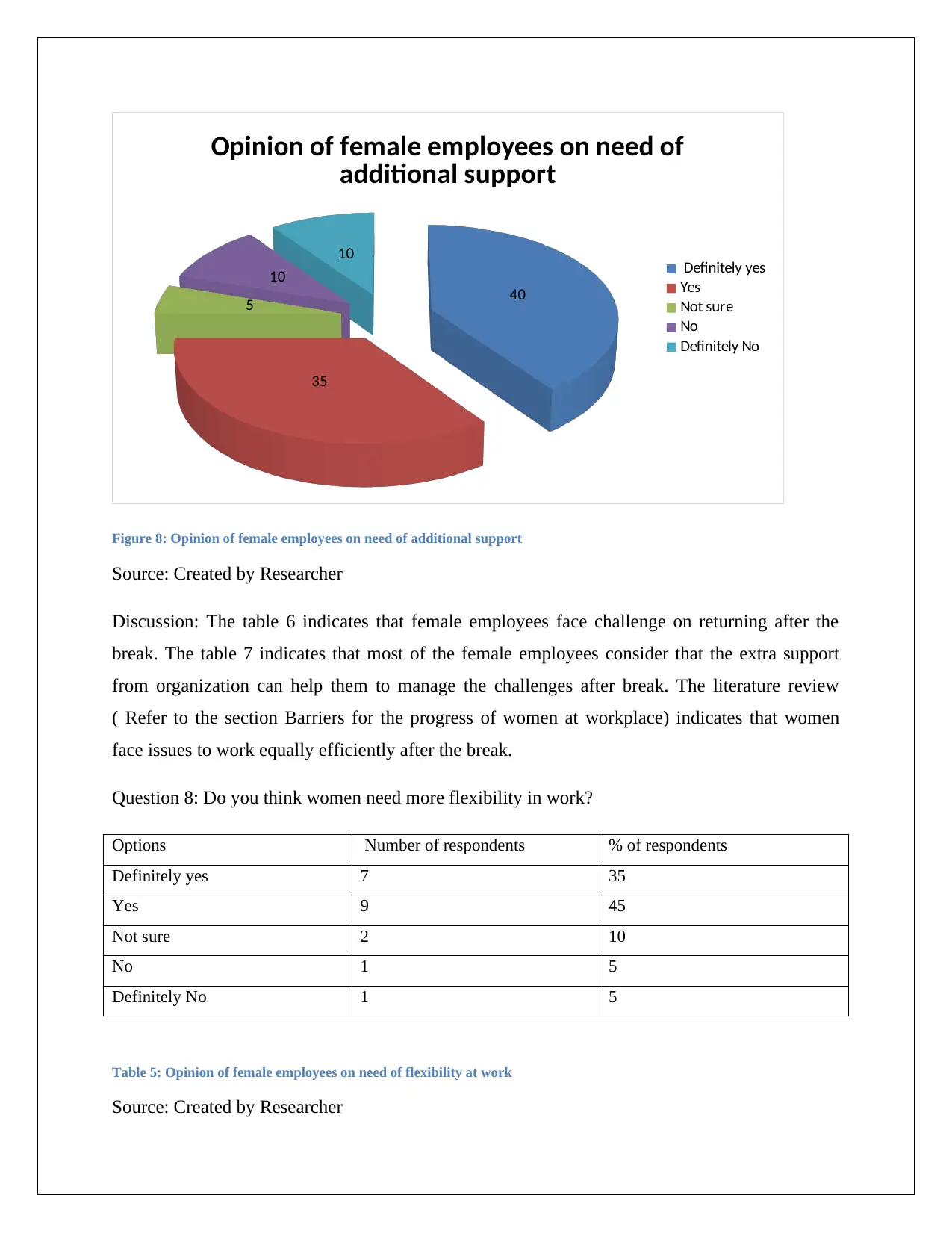
40
35
5
10
10
Opinion of female employees on need of
additional support
Definitely yes
Yes
Not sure
No
Definitely No
Figure 8: Opinion of female employees on need of additional support
Source: Created by Researcher
Discussion: The table 6 indicates that female employees face challenge on returning after the
break. The table 7 indicates that most of the female employees consider that the extra support
from organization can help them to manage the challenges after break. The literature review
( Refer to the section Barriers for the progress of women at workplace) indicates that women
face issues to work equally efficiently after the break.
Question 8: Do you think women need more flexibility in work?
Options Number of respondents % of respondents
Definitely yes 7 35
Yes 9 45
Not sure 2 10
No 1 5
Definitely No 1 5
Table 5: Opinion of female employees on need of flexibility at work
Source: Created by Researcher
35
5
10
10
Opinion of female employees on need of
additional support
Definitely yes
Yes
Not sure
No
Definitely No
Figure 8: Opinion of female employees on need of additional support
Source: Created by Researcher
Discussion: The table 6 indicates that female employees face challenge on returning after the
break. The table 7 indicates that most of the female employees consider that the extra support
from organization can help them to manage the challenges after break. The literature review
( Refer to the section Barriers for the progress of women at workplace) indicates that women
face issues to work equally efficiently after the break.
Question 8: Do you think women need more flexibility in work?
Options Number of respondents % of respondents
Definitely yes 7 35
Yes 9 45
Not sure 2 10
No 1 5
Definitely No 1 5
Table 5: Opinion of female employees on need of flexibility at work
Source: Created by Researcher
Paraphrase This Document
Need a fresh take? Get an instant paraphrase of this document with our AI Paraphraser
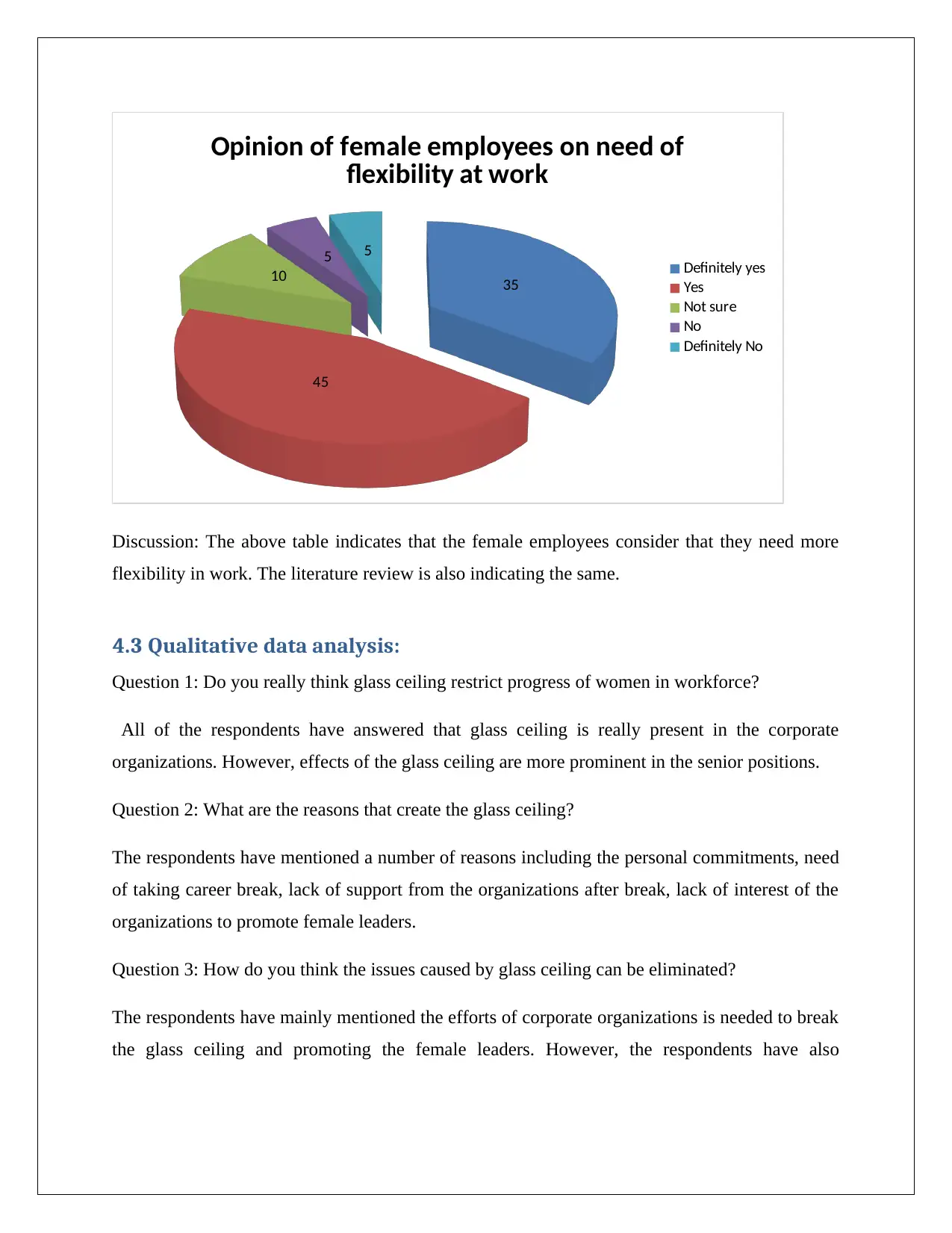
35
45
10
5 5
Opinion of female employees on need of
flexibility at work
Definitely yes
Yes
Not sure
No
Definitely No
Discussion: The above table indicates that the female employees consider that they need more
flexibility in work. The literature review is also indicating the same.
4.3 Qualitative data analysis:
Question 1: Do you really think glass ceiling restrict progress of women in workforce?
All of the respondents have answered that glass ceiling is really present in the corporate
organizations. However, effects of the glass ceiling are more prominent in the senior positions.
Question 2: What are the reasons that create the glass ceiling?
The respondents have mentioned a number of reasons including the personal commitments, need
of taking career break, lack of support from the organizations after break, lack of interest of the
organizations to promote female leaders.
Question 3: How do you think the issues caused by glass ceiling can be eliminated?
The respondents have mainly mentioned the efforts of corporate organizations is needed to break
the glass ceiling and promoting the female leaders. However, the respondents have also
45
10
5 5
Opinion of female employees on need of
flexibility at work
Definitely yes
Yes
Not sure
No
Definitely No
Discussion: The above table indicates that the female employees consider that they need more
flexibility in work. The literature review is also indicating the same.
4.3 Qualitative data analysis:
Question 1: Do you really think glass ceiling restrict progress of women in workforce?
All of the respondents have answered that glass ceiling is really present in the corporate
organizations. However, effects of the glass ceiling are more prominent in the senior positions.
Question 2: What are the reasons that create the glass ceiling?
The respondents have mentioned a number of reasons including the personal commitments, need
of taking career break, lack of support from the organizations after break, lack of interest of the
organizations to promote female leaders.
Question 3: How do you think the issues caused by glass ceiling can be eliminated?
The respondents have mainly mentioned the efforts of corporate organizations is needed to break
the glass ceiling and promoting the female leaders. However, the respondents have also
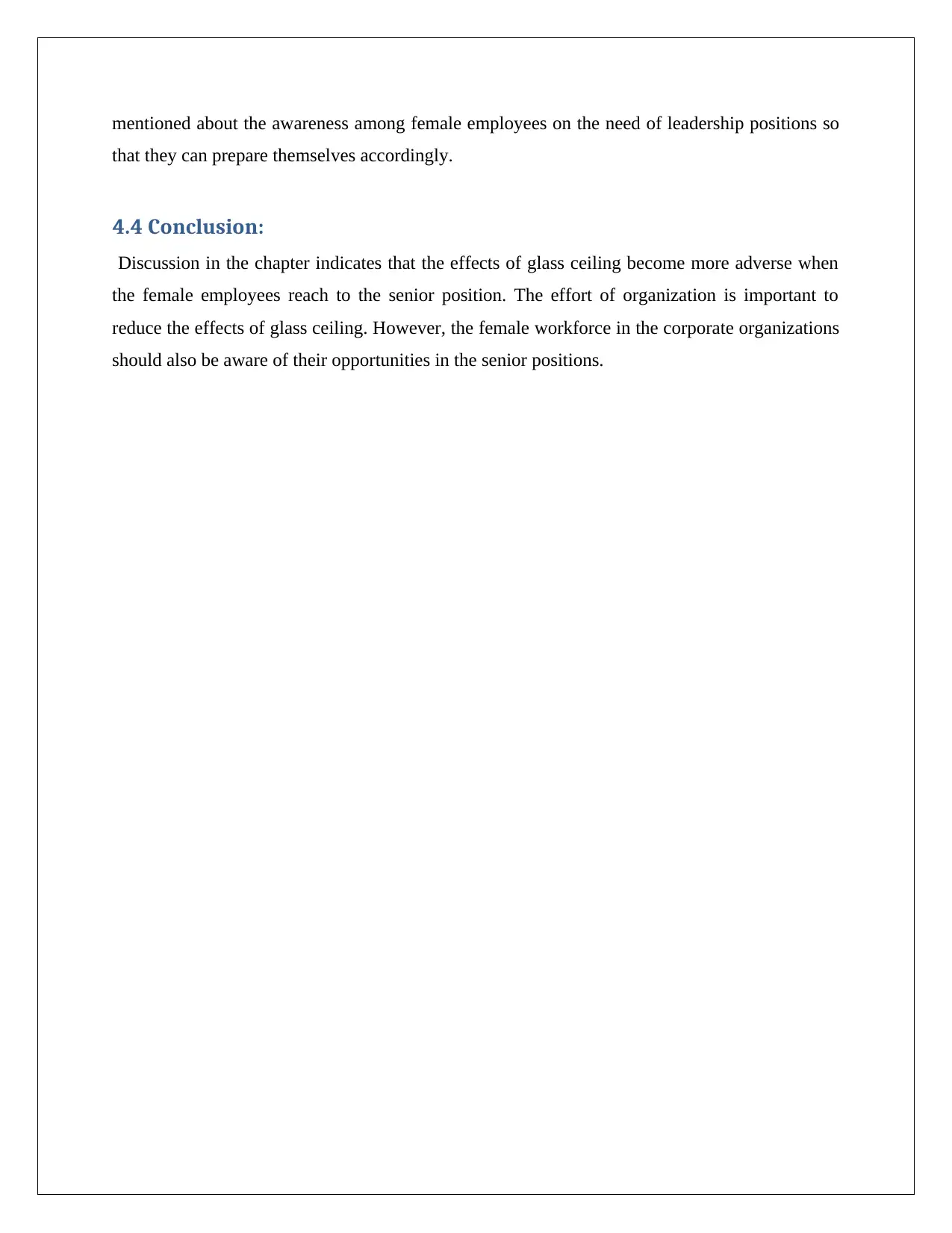
mentioned about the awareness among female employees on the need of leadership positions so
that they can prepare themselves accordingly.
4.4 Conclusion:
Discussion in the chapter indicates that the effects of glass ceiling become more adverse when
the female employees reach to the senior position. The effort of organization is important to
reduce the effects of glass ceiling. However, the female workforce in the corporate organizations
should also be aware of their opportunities in the senior positions.
that they can prepare themselves accordingly.
4.4 Conclusion:
Discussion in the chapter indicates that the effects of glass ceiling become more adverse when
the female employees reach to the senior position. The effort of organization is important to
reduce the effects of glass ceiling. However, the female workforce in the corporate organizations
should also be aware of their opportunities in the senior positions.
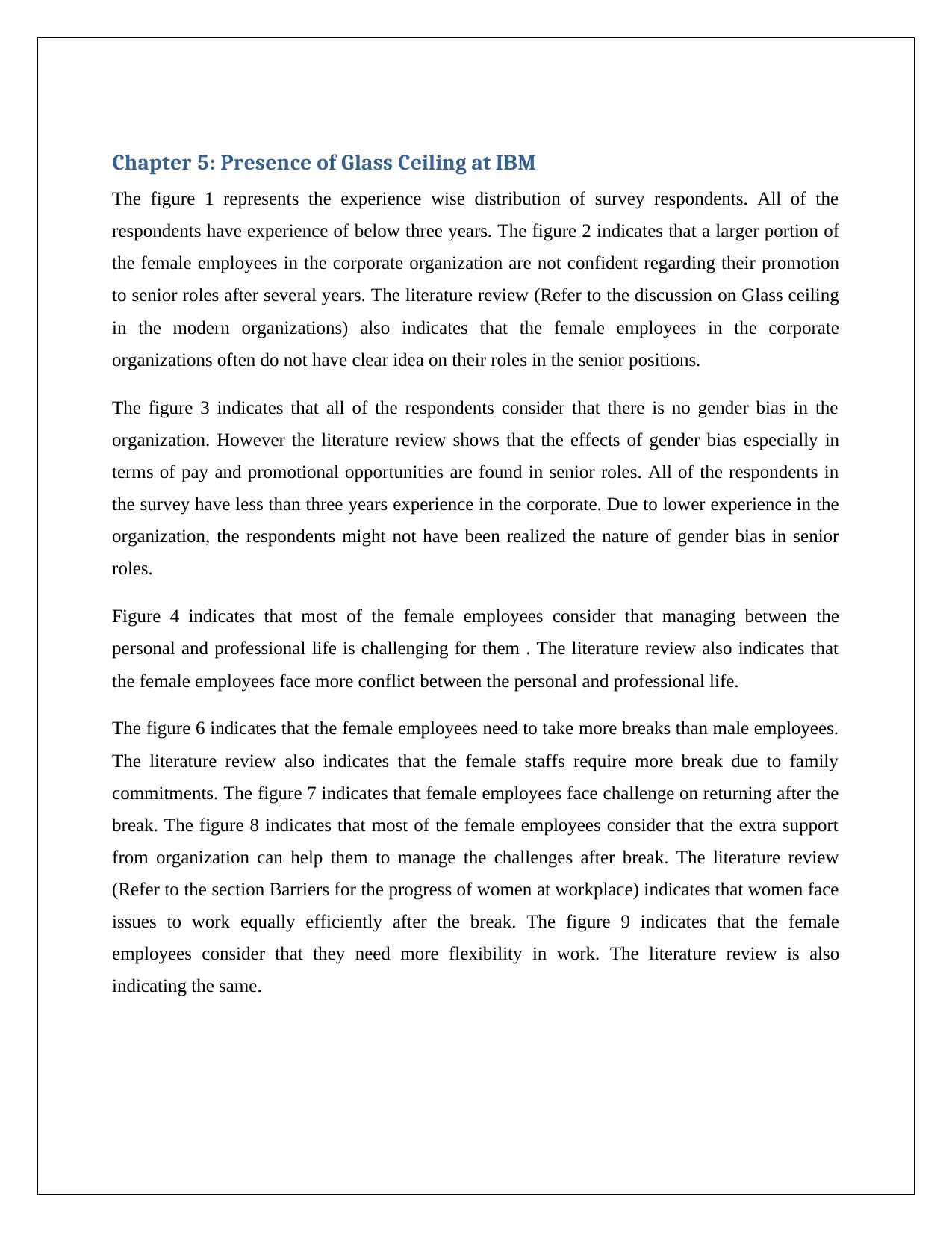
Chapter 5: Presence of Glass Ceiling at IBM
The figure 1 represents the experience wise distribution of survey respondents. All of the
respondents have experience of below three years. The figure 2 indicates that a larger portion of
the female employees in the corporate organization are not confident regarding their promotion
to senior roles after several years. The literature review (Refer to the discussion on Glass ceiling
in the modern organizations) also indicates that the female employees in the corporate
organizations often do not have clear idea on their roles in the senior positions.
The figure 3 indicates that all of the respondents consider that there is no gender bias in the
organization. However the literature review shows that the effects of gender bias especially in
terms of pay and promotional opportunities are found in senior roles. All of the respondents in
the survey have less than three years experience in the corporate. Due to lower experience in the
organization, the respondents might not have been realized the nature of gender bias in senior
roles.
Figure 4 indicates that most of the female employees consider that managing between the
personal and professional life is challenging for them . The literature review also indicates that
the female employees face more conflict between the personal and professional life.
The figure 6 indicates that the female employees need to take more breaks than male employees.
The literature review also indicates that the female staffs require more break due to family
commitments. The figure 7 indicates that female employees face challenge on returning after the
break. The figure 8 indicates that most of the female employees consider that the extra support
from organization can help them to manage the challenges after break. The literature review
(Refer to the section Barriers for the progress of women at workplace) indicates that women face
issues to work equally efficiently after the break. The figure 9 indicates that the female
employees consider that they need more flexibility in work. The literature review is also
indicating the same.
The figure 1 represents the experience wise distribution of survey respondents. All of the
respondents have experience of below three years. The figure 2 indicates that a larger portion of
the female employees in the corporate organization are not confident regarding their promotion
to senior roles after several years. The literature review (Refer to the discussion on Glass ceiling
in the modern organizations) also indicates that the female employees in the corporate
organizations often do not have clear idea on their roles in the senior positions.
The figure 3 indicates that all of the respondents consider that there is no gender bias in the
organization. However the literature review shows that the effects of gender bias especially in
terms of pay and promotional opportunities are found in senior roles. All of the respondents in
the survey have less than three years experience in the corporate. Due to lower experience in the
organization, the respondents might not have been realized the nature of gender bias in senior
roles.
Figure 4 indicates that most of the female employees consider that managing between the
personal and professional life is challenging for them . The literature review also indicates that
the female employees face more conflict between the personal and professional life.
The figure 6 indicates that the female employees need to take more breaks than male employees.
The literature review also indicates that the female staffs require more break due to family
commitments. The figure 7 indicates that female employees face challenge on returning after the
break. The figure 8 indicates that most of the female employees consider that the extra support
from organization can help them to manage the challenges after break. The literature review
(Refer to the section Barriers for the progress of women at workplace) indicates that women face
issues to work equally efficiently after the break. The figure 9 indicates that the female
employees consider that they need more flexibility in work. The literature review is also
indicating the same.
Secure Best Marks with AI Grader
Need help grading? Try our AI Grader for instant feedback on your assignments.
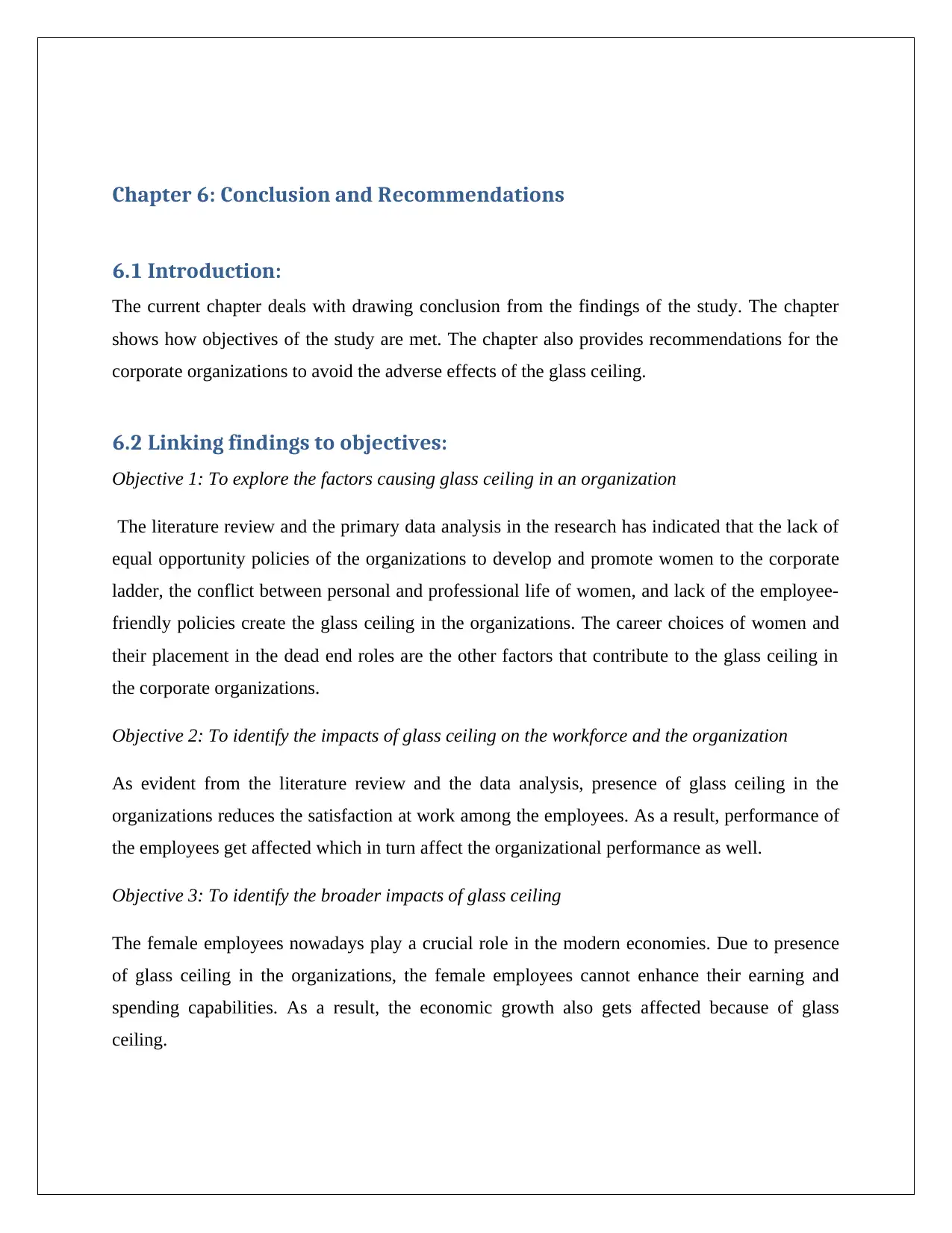
Chapter 6: Conclusion and Recommendations
6.1 Introduction:
The current chapter deals with drawing conclusion from the findings of the study. The chapter
shows how objectives of the study are met. The chapter also provides recommendations for the
corporate organizations to avoid the adverse effects of the glass ceiling.
6.2 Linking findings to objectives:
Objective 1: To explore the factors causing glass ceiling in an organization
The literature review and the primary data analysis in the research has indicated that the lack of
equal opportunity policies of the organizations to develop and promote women to the corporate
ladder, the conflict between personal and professional life of women, and lack of the employee-
friendly policies create the glass ceiling in the organizations. The career choices of women and
their placement in the dead end roles are the other factors that contribute to the glass ceiling in
the corporate organizations.
Objective 2: To identify the impacts of glass ceiling on the workforce and the organization
As evident from the literature review and the data analysis, presence of glass ceiling in the
organizations reduces the satisfaction at work among the employees. As a result, performance of
the employees get affected which in turn affect the organizational performance as well.
Objective 3: To identify the broader impacts of glass ceiling
The female employees nowadays play a crucial role in the modern economies. Due to presence
of glass ceiling in the organizations, the female employees cannot enhance their earning and
spending capabilities. As a result, the economic growth also gets affected because of glass
ceiling.
6.1 Introduction:
The current chapter deals with drawing conclusion from the findings of the study. The chapter
shows how objectives of the study are met. The chapter also provides recommendations for the
corporate organizations to avoid the adverse effects of the glass ceiling.
6.2 Linking findings to objectives:
Objective 1: To explore the factors causing glass ceiling in an organization
The literature review and the primary data analysis in the research has indicated that the lack of
equal opportunity policies of the organizations to develop and promote women to the corporate
ladder, the conflict between personal and professional life of women, and lack of the employee-
friendly policies create the glass ceiling in the organizations. The career choices of women and
their placement in the dead end roles are the other factors that contribute to the glass ceiling in
the corporate organizations.
Objective 2: To identify the impacts of glass ceiling on the workforce and the organization
As evident from the literature review and the data analysis, presence of glass ceiling in the
organizations reduces the satisfaction at work among the employees. As a result, performance of
the employees get affected which in turn affect the organizational performance as well.
Objective 3: To identify the broader impacts of glass ceiling
The female employees nowadays play a crucial role in the modern economies. Due to presence
of glass ceiling in the organizations, the female employees cannot enhance their earning and
spending capabilities. As a result, the economic growth also gets affected because of glass
ceiling.

Objective 4: To recommend organizations the ways for getting rid of the adverse effects of glass
ceiling
Presence of glass ceiling not only affects the workforce but the modern corporate organizations
also get affected. To avoid the adverse effects of the glass ceiling, the organizations need to
develop employee friendly policies and require focusing more on promotion of the female
employees.
6.3 Recommendations:
The following recommendations are made for the organizations so that they do not get affected
by the presence of glass ceiling.
Making the jobs more flexible: Lack of employee friendly policies in the organizations, is one of
the key reasons behind the presence of glass ceiling. The modern corporate management gives
importance on making the workplace flexible so that the working women can balance their
personal and professional life. The women who take break from the career should be provided
with additional support after the break so that they can use their skills to the optimum level.
Strict implementation of gender equality policies in organization: The differences in the
opportunity to get promoted to the higher level, the differences in the pay and access to the
development opportunities, create the glass ceiling for the female employees. The organizations
need to implement strict policies for eliminating the gender biases and reduce the risk of glass
ceiling.
ceiling
Presence of glass ceiling not only affects the workforce but the modern corporate organizations
also get affected. To avoid the adverse effects of the glass ceiling, the organizations need to
develop employee friendly policies and require focusing more on promotion of the female
employees.
6.3 Recommendations:
The following recommendations are made for the organizations so that they do not get affected
by the presence of glass ceiling.
Making the jobs more flexible: Lack of employee friendly policies in the organizations, is one of
the key reasons behind the presence of glass ceiling. The modern corporate management gives
importance on making the workplace flexible so that the working women can balance their
personal and professional life. The women who take break from the career should be provided
with additional support after the break so that they can use their skills to the optimum level.
Strict implementation of gender equality policies in organization: The differences in the
opportunity to get promoted to the higher level, the differences in the pay and access to the
development opportunities, create the glass ceiling for the female employees. The organizations
need to implement strict policies for eliminating the gender biases and reduce the risk of glass
ceiling.
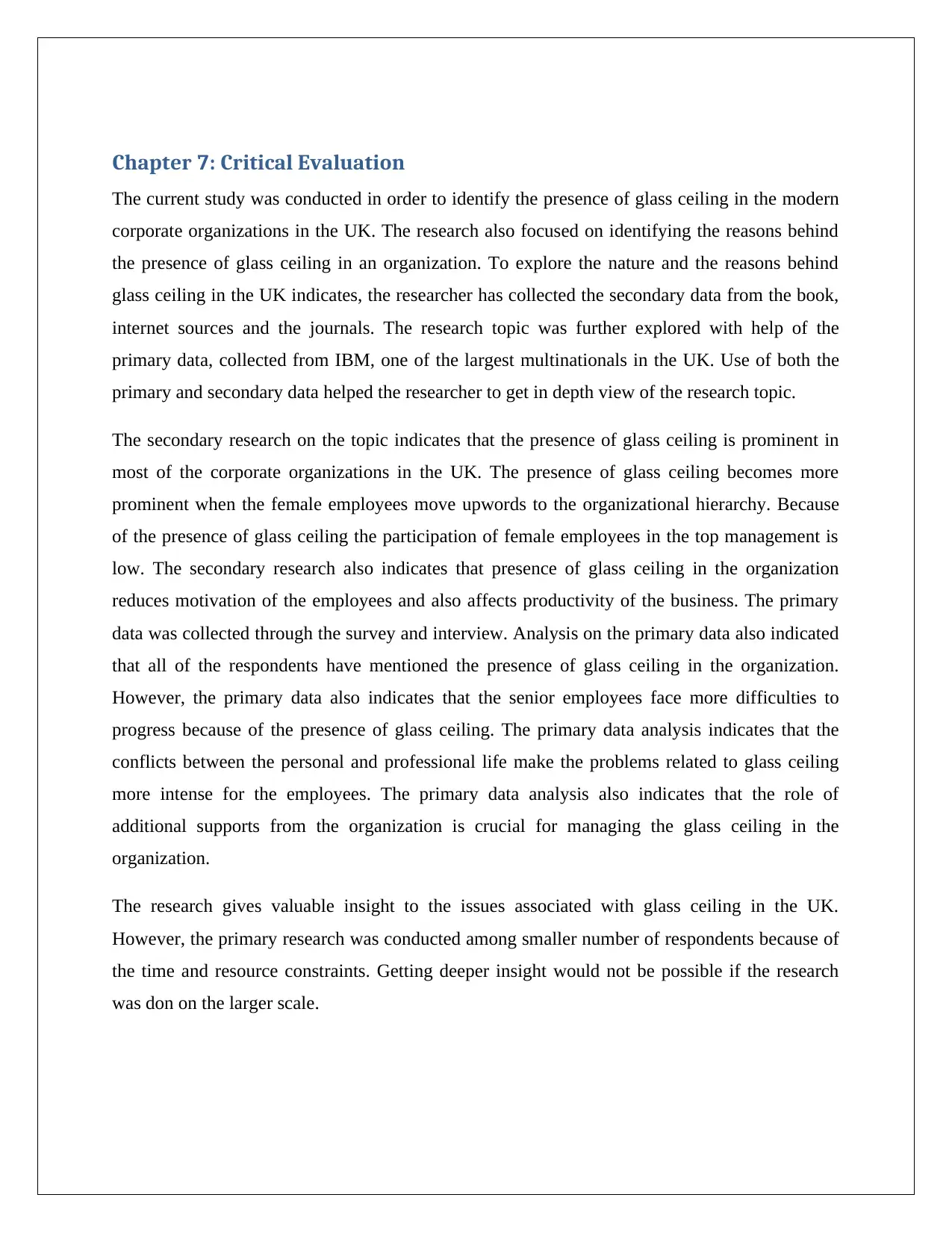
Chapter 7: Critical Evaluation
The current study was conducted in order to identify the presence of glass ceiling in the modern
corporate organizations in the UK. The research also focused on identifying the reasons behind
the presence of glass ceiling in an organization. To explore the nature and the reasons behind
glass ceiling in the UK indicates, the researcher has collected the secondary data from the book,
internet sources and the journals. The research topic was further explored with help of the
primary data, collected from IBM, one of the largest multinationals in the UK. Use of both the
primary and secondary data helped the researcher to get in depth view of the research topic.
The secondary research on the topic indicates that the presence of glass ceiling is prominent in
most of the corporate organizations in the UK. The presence of glass ceiling becomes more
prominent when the female employees move upwords to the organizational hierarchy. Because
of the presence of glass ceiling the participation of female employees in the top management is
low. The secondary research also indicates that presence of glass ceiling in the organization
reduces motivation of the employees and also affects productivity of the business. The primary
data was collected through the survey and interview. Analysis on the primary data also indicated
that all of the respondents have mentioned the presence of glass ceiling in the organization.
However, the primary data also indicates that the senior employees face more difficulties to
progress because of the presence of glass ceiling. The primary data analysis indicates that the
conflicts between the personal and professional life make the problems related to glass ceiling
more intense for the employees. The primary data analysis also indicates that the role of
additional supports from the organization is crucial for managing the glass ceiling in the
organization.
The research gives valuable insight to the issues associated with glass ceiling in the UK.
However, the primary research was conducted among smaller number of respondents because of
the time and resource constraints. Getting deeper insight would not be possible if the research
was don on the larger scale.
The current study was conducted in order to identify the presence of glass ceiling in the modern
corporate organizations in the UK. The research also focused on identifying the reasons behind
the presence of glass ceiling in an organization. To explore the nature and the reasons behind
glass ceiling in the UK indicates, the researcher has collected the secondary data from the book,
internet sources and the journals. The research topic was further explored with help of the
primary data, collected from IBM, one of the largest multinationals in the UK. Use of both the
primary and secondary data helped the researcher to get in depth view of the research topic.
The secondary research on the topic indicates that the presence of glass ceiling is prominent in
most of the corporate organizations in the UK. The presence of glass ceiling becomes more
prominent when the female employees move upwords to the organizational hierarchy. Because
of the presence of glass ceiling the participation of female employees in the top management is
low. The secondary research also indicates that presence of glass ceiling in the organization
reduces motivation of the employees and also affects productivity of the business. The primary
data was collected through the survey and interview. Analysis on the primary data also indicated
that all of the respondents have mentioned the presence of glass ceiling in the organization.
However, the primary data also indicates that the senior employees face more difficulties to
progress because of the presence of glass ceiling. The primary data analysis indicates that the
conflicts between the personal and professional life make the problems related to glass ceiling
more intense for the employees. The primary data analysis also indicates that the role of
additional supports from the organization is crucial for managing the glass ceiling in the
organization.
The research gives valuable insight to the issues associated with glass ceiling in the UK.
However, the primary research was conducted among smaller number of respondents because of
the time and resource constraints. Getting deeper insight would not be possible if the research
was don on the larger scale.
Paraphrase This Document
Need a fresh take? Get an instant paraphrase of this document with our AI Paraphraser
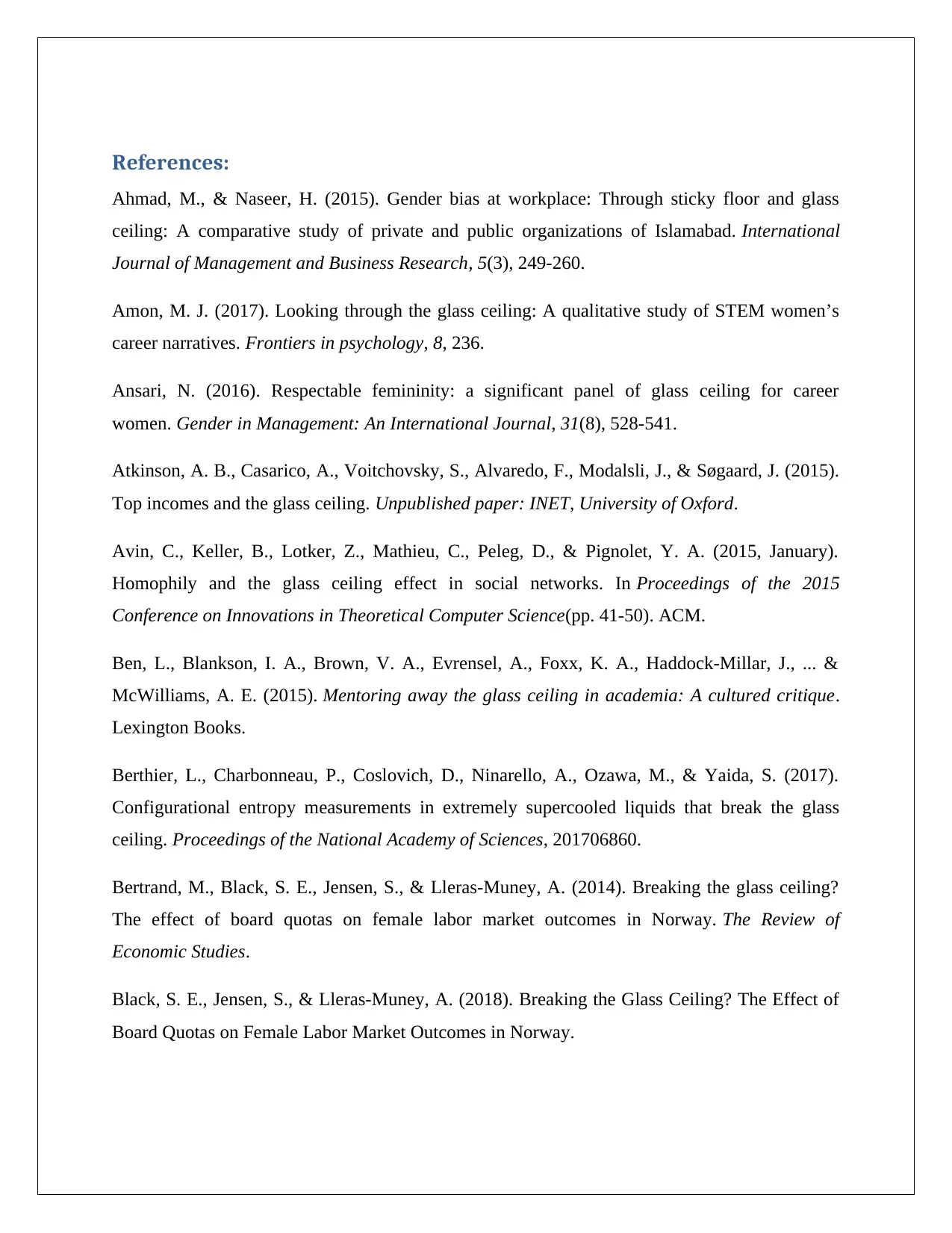
References:
Ahmad, M., & Naseer, H. (2015). Gender bias at workplace: Through sticky floor and glass
ceiling: A comparative study of private and public organizations of Islamabad. International
Journal of Management and Business Research, 5(3), 249-260.
Amon, M. J. (2017). Looking through the glass ceiling: A qualitative study of STEM women’s
career narratives. Frontiers in psychology, 8, 236.
Ansari, N. (2016). Respectable femininity: a significant panel of glass ceiling for career
women. Gender in Management: An International Journal, 31(8), 528-541.
Atkinson, A. B., Casarico, A., Voitchovsky, S., Alvaredo, F., Modalsli, J., & Søgaard, J. (2015).
Top incomes and the glass ceiling. Unpublished paper: INET, University of Oxford.
Avin, C., Keller, B., Lotker, Z., Mathieu, C., Peleg, D., & Pignolet, Y. A. (2015, January).
Homophily and the glass ceiling effect in social networks. In Proceedings of the 2015
Conference on Innovations in Theoretical Computer Science(pp. 41-50). ACM.
Ben, L., Blankson, I. A., Brown, V. A., Evrensel, A., Foxx, K. A., Haddock-Millar, J., ... &
McWilliams, A. E. (2015). Mentoring away the glass ceiling in academia: A cultured critique.
Lexington Books.
Berthier, L., Charbonneau, P., Coslovich, D., Ninarello, A., Ozawa, M., & Yaida, S. (2017).
Configurational entropy measurements in extremely supercooled liquids that break the glass
ceiling. Proceedings of the National Academy of Sciences, 201706860.
Bertrand, M., Black, S. E., Jensen, S., & Lleras-Muney, A. (2014). Breaking the glass ceiling?
The effect of board quotas on female labor market outcomes in Norway. The Review of
Economic Studies.
Black, S. E., Jensen, S., & Lleras-Muney, A. (2018). Breaking the Glass Ceiling? The Effect of
Board Quotas on Female Labor Market Outcomes in Norway.
Ahmad, M., & Naseer, H. (2015). Gender bias at workplace: Through sticky floor and glass
ceiling: A comparative study of private and public organizations of Islamabad. International
Journal of Management and Business Research, 5(3), 249-260.
Amon, M. J. (2017). Looking through the glass ceiling: A qualitative study of STEM women’s
career narratives. Frontiers in psychology, 8, 236.
Ansari, N. (2016). Respectable femininity: a significant panel of glass ceiling for career
women. Gender in Management: An International Journal, 31(8), 528-541.
Atkinson, A. B., Casarico, A., Voitchovsky, S., Alvaredo, F., Modalsli, J., & Søgaard, J. (2015).
Top incomes and the glass ceiling. Unpublished paper: INET, University of Oxford.
Avin, C., Keller, B., Lotker, Z., Mathieu, C., Peleg, D., & Pignolet, Y. A. (2015, January).
Homophily and the glass ceiling effect in social networks. In Proceedings of the 2015
Conference on Innovations in Theoretical Computer Science(pp. 41-50). ACM.
Ben, L., Blankson, I. A., Brown, V. A., Evrensel, A., Foxx, K. A., Haddock-Millar, J., ... &
McWilliams, A. E. (2015). Mentoring away the glass ceiling in academia: A cultured critique.
Lexington Books.
Berthier, L., Charbonneau, P., Coslovich, D., Ninarello, A., Ozawa, M., & Yaida, S. (2017).
Configurational entropy measurements in extremely supercooled liquids that break the glass
ceiling. Proceedings of the National Academy of Sciences, 201706860.
Bertrand, M., Black, S. E., Jensen, S., & Lleras-Muney, A. (2014). Breaking the glass ceiling?
The effect of board quotas on female labor market outcomes in Norway. The Review of
Economic Studies.
Black, S. E., Jensen, S., & Lleras-Muney, A. (2018). Breaking the Glass Ceiling? The Effect of
Board Quotas on Female Labor Market Outcomes in Norway.
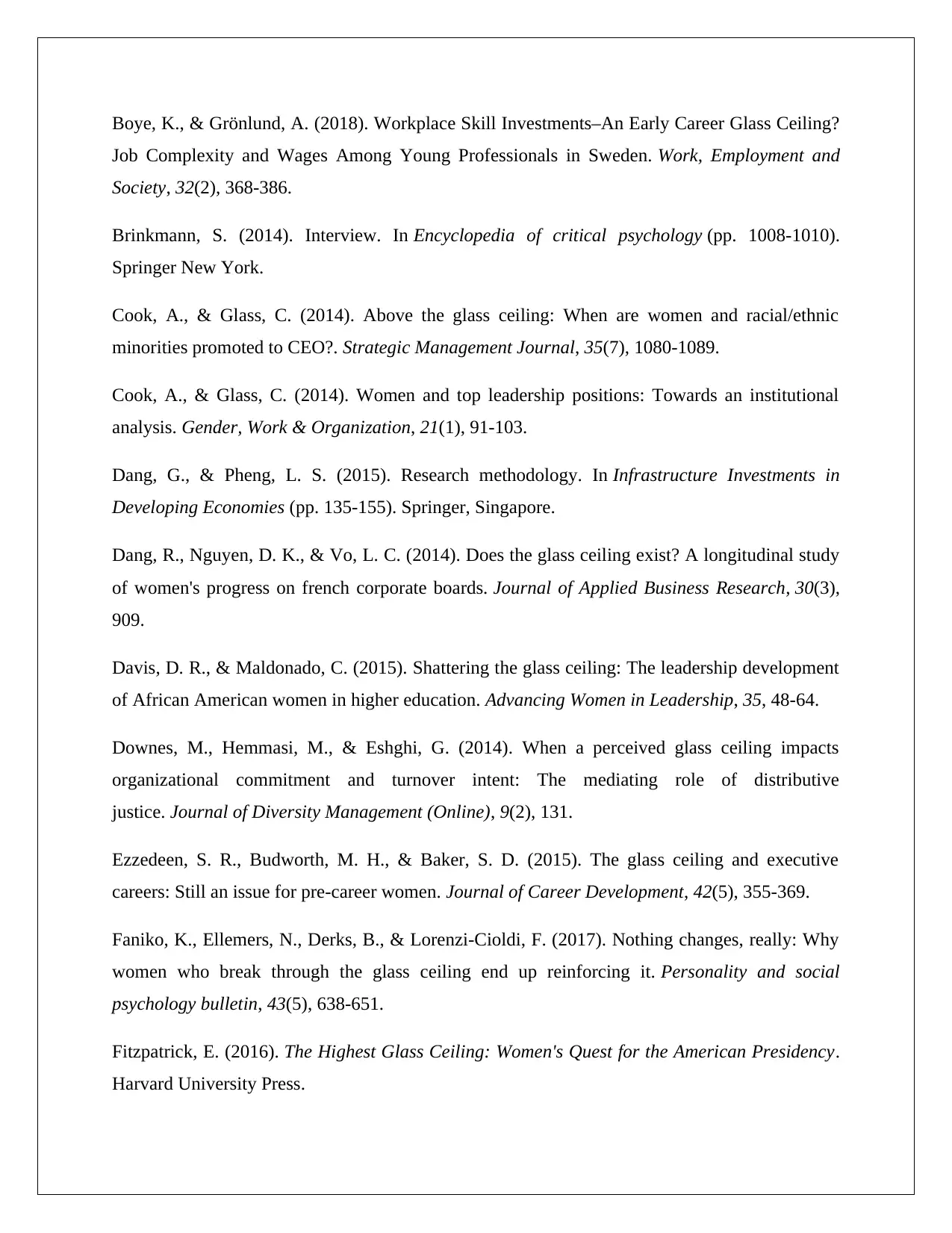
Boye, K., & Grönlund, A. (2018). Workplace Skill Investments–An Early Career Glass Ceiling?
Job Complexity and Wages Among Young Professionals in Sweden. Work, Employment and
Society, 32(2), 368-386.
Brinkmann, S. (2014). Interview. In Encyclopedia of critical psychology (pp. 1008-1010).
Springer New York.
Cook, A., & Glass, C. (2014). Above the glass ceiling: When are women and racial/ethnic
minorities promoted to CEO?. Strategic Management Journal, 35(7), 1080-1089.
Cook, A., & Glass, C. (2014). Women and top leadership positions: Towards an institutional
analysis. Gender, Work & Organization, 21(1), 91-103.
Dang, G., & Pheng, L. S. (2015). Research methodology. In Infrastructure Investments in
Developing Economies (pp. 135-155). Springer, Singapore.
Dang, R., Nguyen, D. K., & Vo, L. C. (2014). Does the glass ceiling exist? A longitudinal study
of women's progress on french corporate boards. Journal of Applied Business Research, 30(3),
909.
Davis, D. R., & Maldonado, C. (2015). Shattering the glass ceiling: The leadership development
of African American women in higher education. Advancing Women in Leadership, 35, 48-64.
Downes, M., Hemmasi, M., & Eshghi, G. (2014). When a perceived glass ceiling impacts
organizational commitment and turnover intent: The mediating role of distributive
justice. Journal of Diversity Management (Online), 9(2), 131.
Ezzedeen, S. R., Budworth, M. H., & Baker, S. D. (2015). The glass ceiling and executive
careers: Still an issue for pre-career women. Journal of Career Development, 42(5), 355-369.
Faniko, K., Ellemers, N., Derks, B., & Lorenzi-Cioldi, F. (2017). Nothing changes, really: Why
women who break through the glass ceiling end up reinforcing it. Personality and social
psychology bulletin, 43(5), 638-651.
Fitzpatrick, E. (2016). The Highest Glass Ceiling: Women's Quest for the American Presidency.
Harvard University Press.
Job Complexity and Wages Among Young Professionals in Sweden. Work, Employment and
Society, 32(2), 368-386.
Brinkmann, S. (2014). Interview. In Encyclopedia of critical psychology (pp. 1008-1010).
Springer New York.
Cook, A., & Glass, C. (2014). Above the glass ceiling: When are women and racial/ethnic
minorities promoted to CEO?. Strategic Management Journal, 35(7), 1080-1089.
Cook, A., & Glass, C. (2014). Women and top leadership positions: Towards an institutional
analysis. Gender, Work & Organization, 21(1), 91-103.
Dang, G., & Pheng, L. S. (2015). Research methodology. In Infrastructure Investments in
Developing Economies (pp. 135-155). Springer, Singapore.
Dang, R., Nguyen, D. K., & Vo, L. C. (2014). Does the glass ceiling exist? A longitudinal study
of women's progress on french corporate boards. Journal of Applied Business Research, 30(3),
909.
Davis, D. R., & Maldonado, C. (2015). Shattering the glass ceiling: The leadership development
of African American women in higher education. Advancing Women in Leadership, 35, 48-64.
Downes, M., Hemmasi, M., & Eshghi, G. (2014). When a perceived glass ceiling impacts
organizational commitment and turnover intent: The mediating role of distributive
justice. Journal of Diversity Management (Online), 9(2), 131.
Ezzedeen, S. R., Budworth, M. H., & Baker, S. D. (2015). The glass ceiling and executive
careers: Still an issue for pre-career women. Journal of Career Development, 42(5), 355-369.
Faniko, K., Ellemers, N., Derks, B., & Lorenzi-Cioldi, F. (2017). Nothing changes, really: Why
women who break through the glass ceiling end up reinforcing it. Personality and social
psychology bulletin, 43(5), 638-651.
Fitzpatrick, E. (2016). The Highest Glass Ceiling: Women's Quest for the American Presidency.
Harvard University Press.
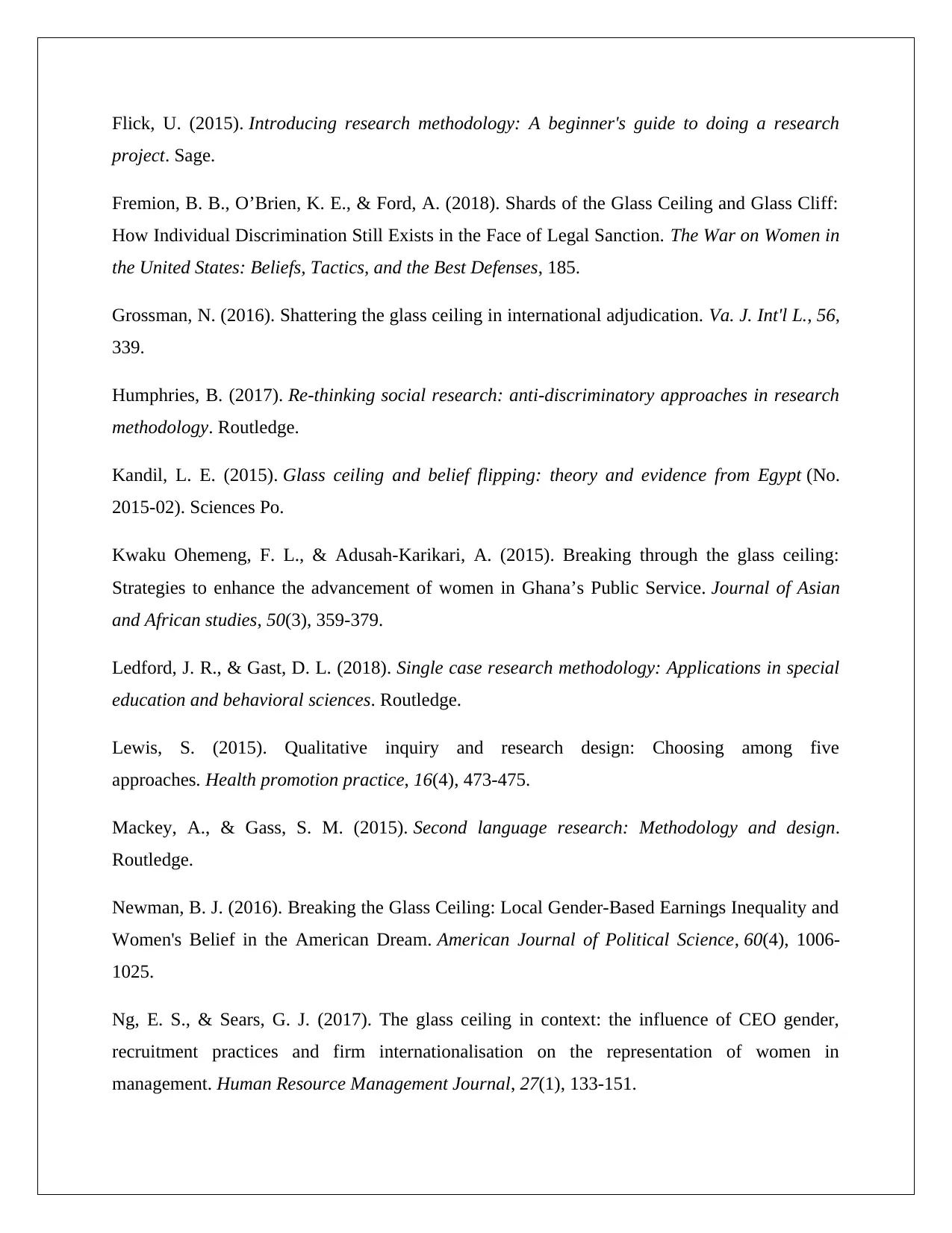
Flick, U. (2015). Introducing research methodology: A beginner's guide to doing a research
project. Sage.
Fremion, B. B., O’Brien, K. E., & Ford, A. (2018). Shards of the Glass Ceiling and Glass Cliff:
How Individual Discrimination Still Exists in the Face of Legal Sanction. The War on Women in
the United States: Beliefs, Tactics, and the Best Defenses, 185.
Grossman, N. (2016). Shattering the glass ceiling in international adjudication. Va. J. Int'l L., 56,
339.
Humphries, B. (2017). Re-thinking social research: anti-discriminatory approaches in research
methodology. Routledge.
Kandil, L. E. (2015). Glass ceiling and belief flipping: theory and evidence from Egypt (No.
2015-02). Sciences Po.
Kwaku Ohemeng, F. L., & Adusah-Karikari, A. (2015). Breaking through the glass ceiling:
Strategies to enhance the advancement of women in Ghana’s Public Service. Journal of Asian
and African studies, 50(3), 359-379.
Ledford, J. R., & Gast, D. L. (2018). Single case research methodology: Applications in special
education and behavioral sciences. Routledge.
Lewis, S. (2015). Qualitative inquiry and research design: Choosing among five
approaches. Health promotion practice, 16(4), 473-475.
Mackey, A., & Gass, S. M. (2015). Second language research: Methodology and design.
Routledge.
Newman, B. J. (2016). Breaking the Glass Ceiling: Local Gender‐Based Earnings Inequality and
Women's Belief in the American Dream. American Journal of Political Science, 60(4), 1006-
1025.
Ng, E. S., & Sears, G. J. (2017). The glass ceiling in context: the influence of CEO gender,
recruitment practices and firm internationalisation on the representation of women in
management. Human Resource Management Journal, 27(1), 133-151.
project. Sage.
Fremion, B. B., O’Brien, K. E., & Ford, A. (2018). Shards of the Glass Ceiling and Glass Cliff:
How Individual Discrimination Still Exists in the Face of Legal Sanction. The War on Women in
the United States: Beliefs, Tactics, and the Best Defenses, 185.
Grossman, N. (2016). Shattering the glass ceiling in international adjudication. Va. J. Int'l L., 56,
339.
Humphries, B. (2017). Re-thinking social research: anti-discriminatory approaches in research
methodology. Routledge.
Kandil, L. E. (2015). Glass ceiling and belief flipping: theory and evidence from Egypt (No.
2015-02). Sciences Po.
Kwaku Ohemeng, F. L., & Adusah-Karikari, A. (2015). Breaking through the glass ceiling:
Strategies to enhance the advancement of women in Ghana’s Public Service. Journal of Asian
and African studies, 50(3), 359-379.
Ledford, J. R., & Gast, D. L. (2018). Single case research methodology: Applications in special
education and behavioral sciences. Routledge.
Lewis, S. (2015). Qualitative inquiry and research design: Choosing among five
approaches. Health promotion practice, 16(4), 473-475.
Mackey, A., & Gass, S. M. (2015). Second language research: Methodology and design.
Routledge.
Newman, B. J. (2016). Breaking the Glass Ceiling: Local Gender‐Based Earnings Inequality and
Women's Belief in the American Dream. American Journal of Political Science, 60(4), 1006-
1025.
Ng, E. S., & Sears, G. J. (2017). The glass ceiling in context: the influence of CEO gender,
recruitment practices and firm internationalisation on the representation of women in
management. Human Resource Management Journal, 27(1), 133-151.
Secure Best Marks with AI Grader
Need help grading? Try our AI Grader for instant feedback on your assignments.
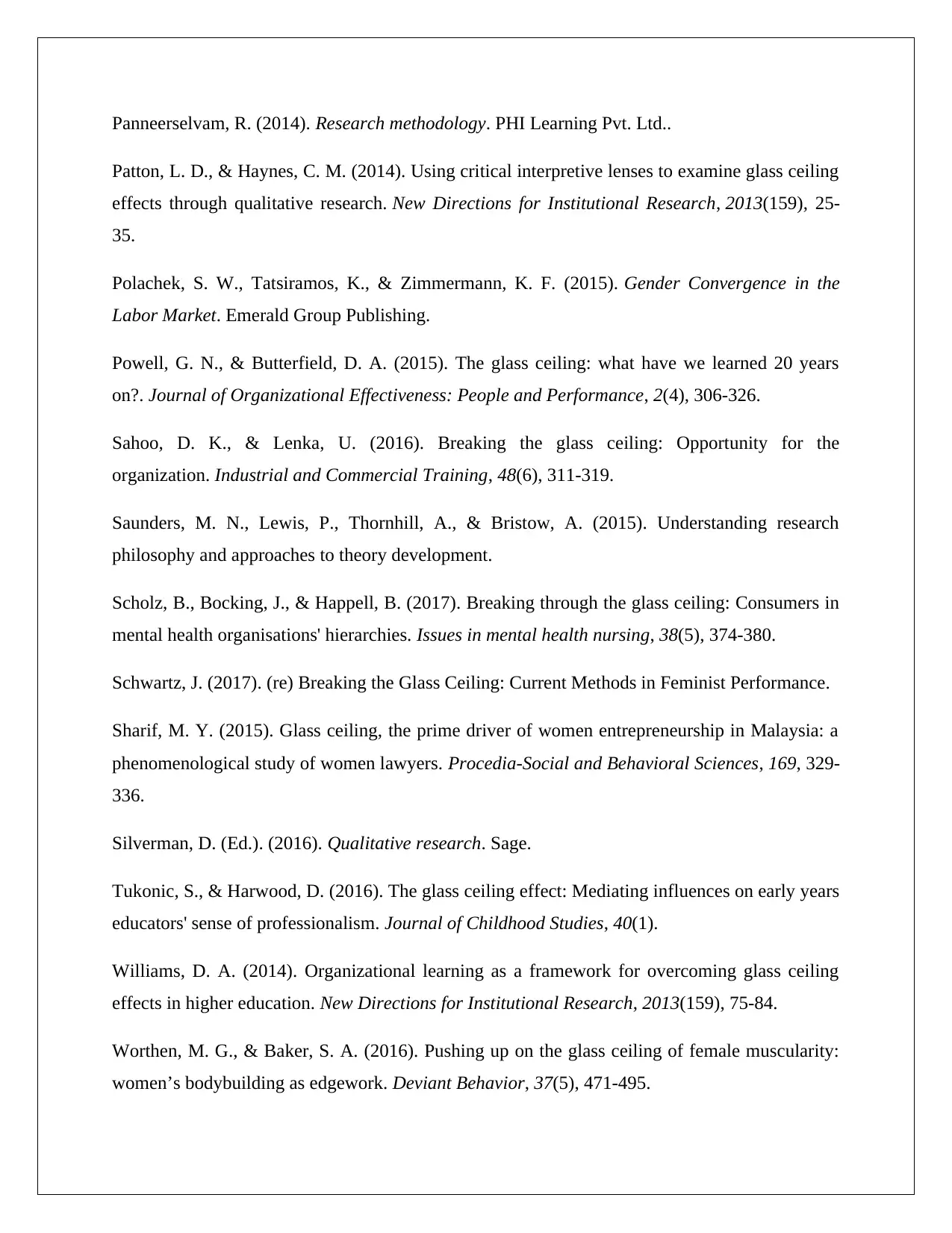
Panneerselvam, R. (2014). Research methodology. PHI Learning Pvt. Ltd..
Patton, L. D., & Haynes, C. M. (2014). Using critical interpretive lenses to examine glass ceiling
effects through qualitative research. New Directions for Institutional Research, 2013(159), 25-
35.
Polachek, S. W., Tatsiramos, K., & Zimmermann, K. F. (2015). Gender Convergence in the
Labor Market. Emerald Group Publishing.
Powell, G. N., & Butterfield, D. A. (2015). The glass ceiling: what have we learned 20 years
on?. Journal of Organizational Effectiveness: People and Performance, 2(4), 306-326.
Sahoo, D. K., & Lenka, U. (2016). Breaking the glass ceiling: Opportunity for the
organization. Industrial and Commercial Training, 48(6), 311-319.
Saunders, M. N., Lewis, P., Thornhill, A., & Bristow, A. (2015). Understanding research
philosophy and approaches to theory development.
Scholz, B., Bocking, J., & Happell, B. (2017). Breaking through the glass ceiling: Consumers in
mental health organisations' hierarchies. Issues in mental health nursing, 38(5), 374-380.
Schwartz, J. (2017). (re) Breaking the Glass Ceiling: Current Methods in Feminist Performance.
Sharif, M. Y. (2015). Glass ceiling, the prime driver of women entrepreneurship in Malaysia: a
phenomenological study of women lawyers. Procedia-Social and Behavioral Sciences, 169, 329-
336.
Silverman, D. (Ed.). (2016). Qualitative research. Sage.
Tukonic, S., & Harwood, D. (2016). The glass ceiling effect: Mediating influences on early years
educators' sense of professionalism. Journal of Childhood Studies, 40(1).
Williams, D. A. (2014). Organizational learning as a framework for overcoming glass ceiling
effects in higher education. New Directions for Institutional Research, 2013(159), 75-84.
Worthen, M. G., & Baker, S. A. (2016). Pushing up on the glass ceiling of female muscularity:
women’s bodybuilding as edgework. Deviant Behavior, 37(5), 471-495.
Patton, L. D., & Haynes, C. M. (2014). Using critical interpretive lenses to examine glass ceiling
effects through qualitative research. New Directions for Institutional Research, 2013(159), 25-
35.
Polachek, S. W., Tatsiramos, K., & Zimmermann, K. F. (2015). Gender Convergence in the
Labor Market. Emerald Group Publishing.
Powell, G. N., & Butterfield, D. A. (2015). The glass ceiling: what have we learned 20 years
on?. Journal of Organizational Effectiveness: People and Performance, 2(4), 306-326.
Sahoo, D. K., & Lenka, U. (2016). Breaking the glass ceiling: Opportunity for the
organization. Industrial and Commercial Training, 48(6), 311-319.
Saunders, M. N., Lewis, P., Thornhill, A., & Bristow, A. (2015). Understanding research
philosophy and approaches to theory development.
Scholz, B., Bocking, J., & Happell, B. (2017). Breaking through the glass ceiling: Consumers in
mental health organisations' hierarchies. Issues in mental health nursing, 38(5), 374-380.
Schwartz, J. (2017). (re) Breaking the Glass Ceiling: Current Methods in Feminist Performance.
Sharif, M. Y. (2015). Glass ceiling, the prime driver of women entrepreneurship in Malaysia: a
phenomenological study of women lawyers. Procedia-Social and Behavioral Sciences, 169, 329-
336.
Silverman, D. (Ed.). (2016). Qualitative research. Sage.
Tukonic, S., & Harwood, D. (2016). The glass ceiling effect: Mediating influences on early years
educators' sense of professionalism. Journal of Childhood Studies, 40(1).
Williams, D. A. (2014). Organizational learning as a framework for overcoming glass ceiling
effects in higher education. New Directions for Institutional Research, 2013(159), 75-84.
Worthen, M. G., & Baker, S. A. (2016). Pushing up on the glass ceiling of female muscularity:
women’s bodybuilding as edgework. Deviant Behavior, 37(5), 471-495.
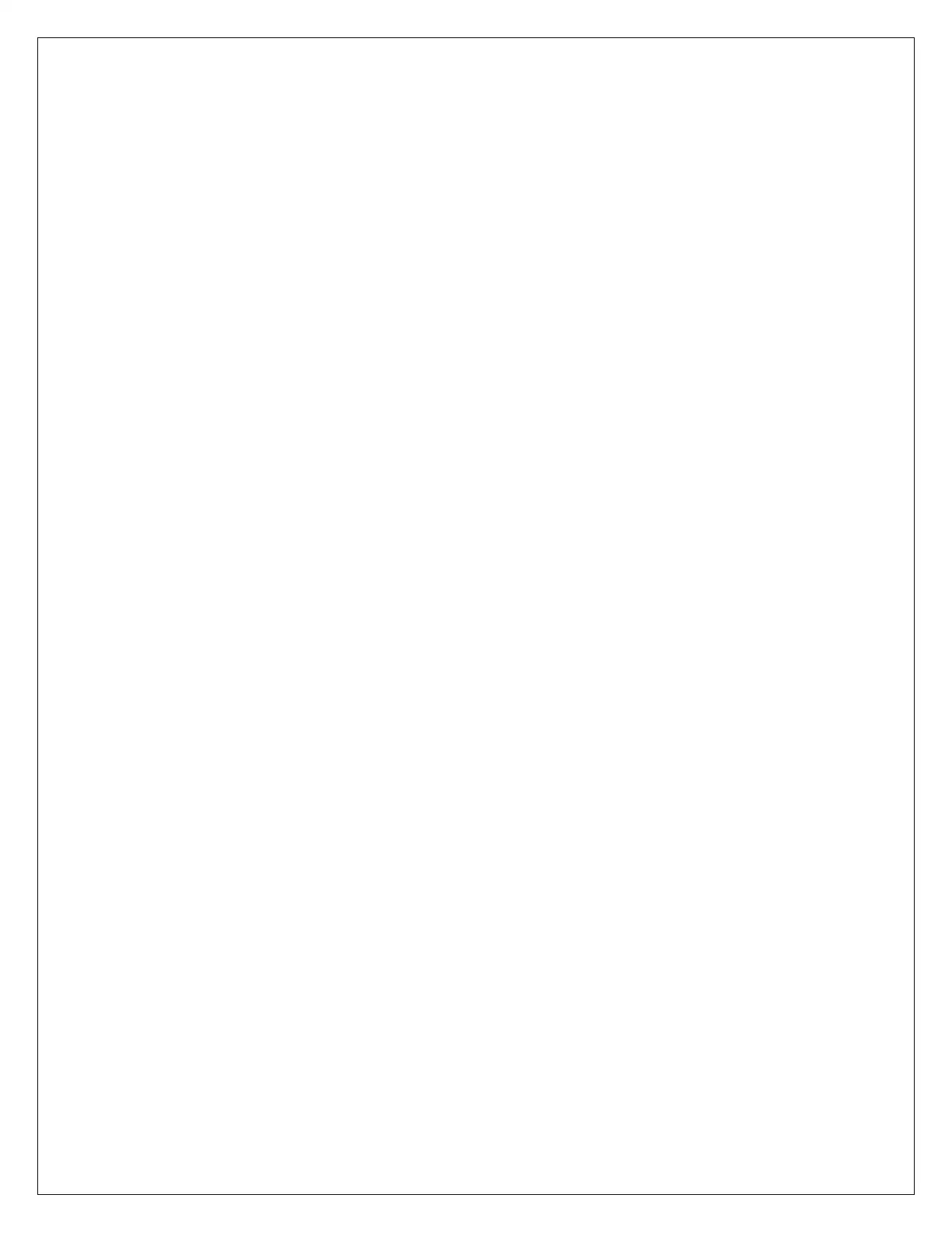
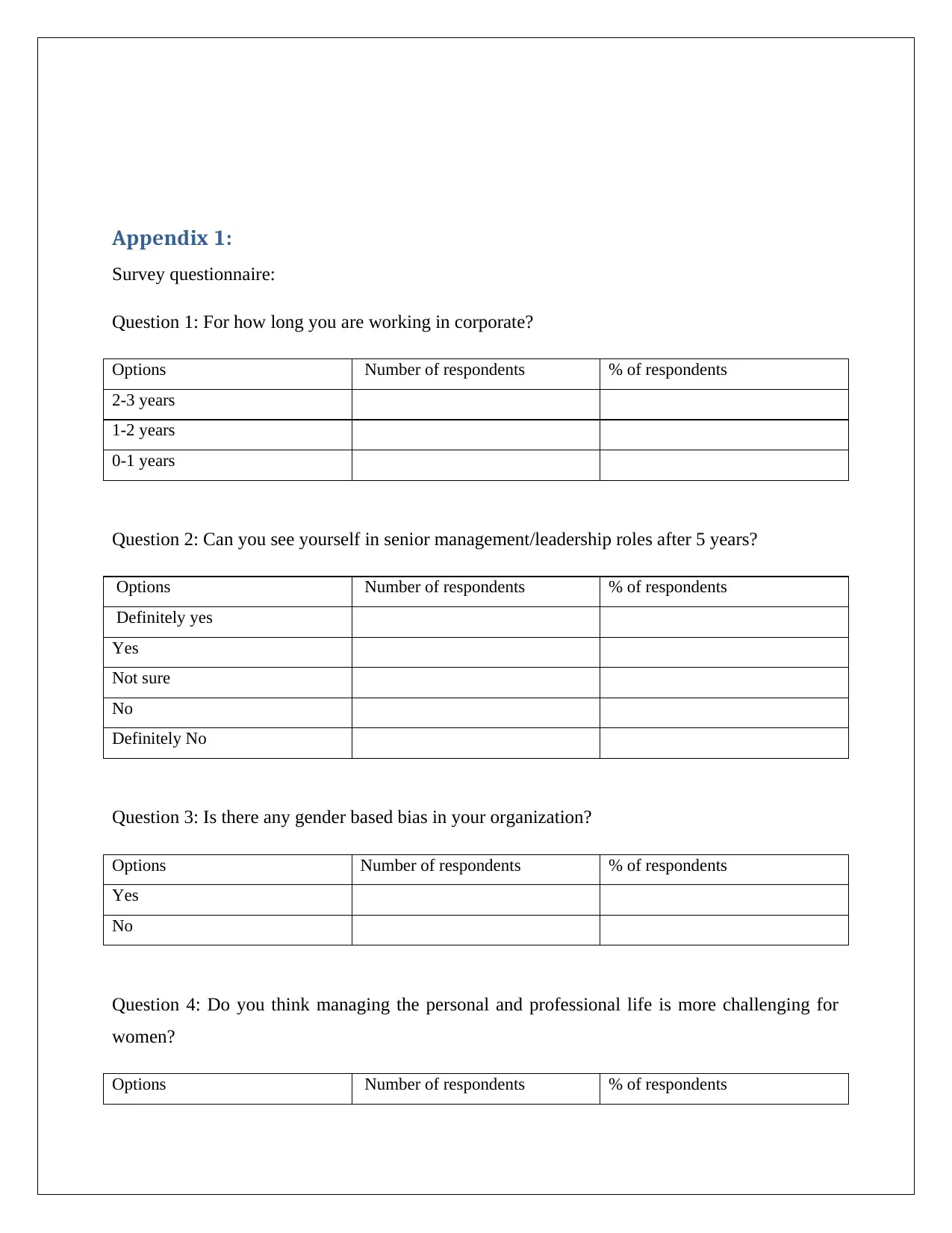
Appendix 1:
Survey questionnaire:
Question 1: For how long you are working in corporate?
Options Number of respondents % of respondents
2-3 years
1-2 years
0-1 years
Question 2: Can you see yourself in senior management/leadership roles after 5 years?
Options Number of respondents % of respondents
Definitely yes
Yes
Not sure
No
Definitely No
Question 3: Is there any gender based bias in your organization?
Options Number of respondents % of respondents
Yes
No
Question 4: Do you think managing the personal and professional life is more challenging for
women?
Options Number of respondents % of respondents
Survey questionnaire:
Question 1: For how long you are working in corporate?
Options Number of respondents % of respondents
2-3 years
1-2 years
0-1 years
Question 2: Can you see yourself in senior management/leadership roles after 5 years?
Options Number of respondents % of respondents
Definitely yes
Yes
Not sure
No
Definitely No
Question 3: Is there any gender based bias in your organization?
Options Number of respondents % of respondents
Yes
No
Question 4: Do you think managing the personal and professional life is more challenging for
women?
Options Number of respondents % of respondents
Paraphrase This Document
Need a fresh take? Get an instant paraphrase of this document with our AI Paraphraser

Definitely yes
Yes
Not sure
No
Definitely No
Question 5: Do you agree that female employees need to take more breaks in career than their
male counterpart?
Options Number of respondents % of respondents
Definitely yes
Yes
Not sure
No
Definitely No
Question 6: Do you think making progress in career after break becomes more challenging for
female?
Options Number of respondents % of respondents
Definitely yes
Yes
Not sure
No
Definitely No
Question 7: Do you think additional support from organization can help women to cope up with
the challenges?
Options Number of respondents % of respondents
Definitely yes
Yes
Yes
Not sure
No
Definitely No
Question 5: Do you agree that female employees need to take more breaks in career than their
male counterpart?
Options Number of respondents % of respondents
Definitely yes
Yes
Not sure
No
Definitely No
Question 6: Do you think making progress in career after break becomes more challenging for
female?
Options Number of respondents % of respondents
Definitely yes
Yes
Not sure
No
Definitely No
Question 7: Do you think additional support from organization can help women to cope up with
the challenges?
Options Number of respondents % of respondents
Definitely yes
Yes
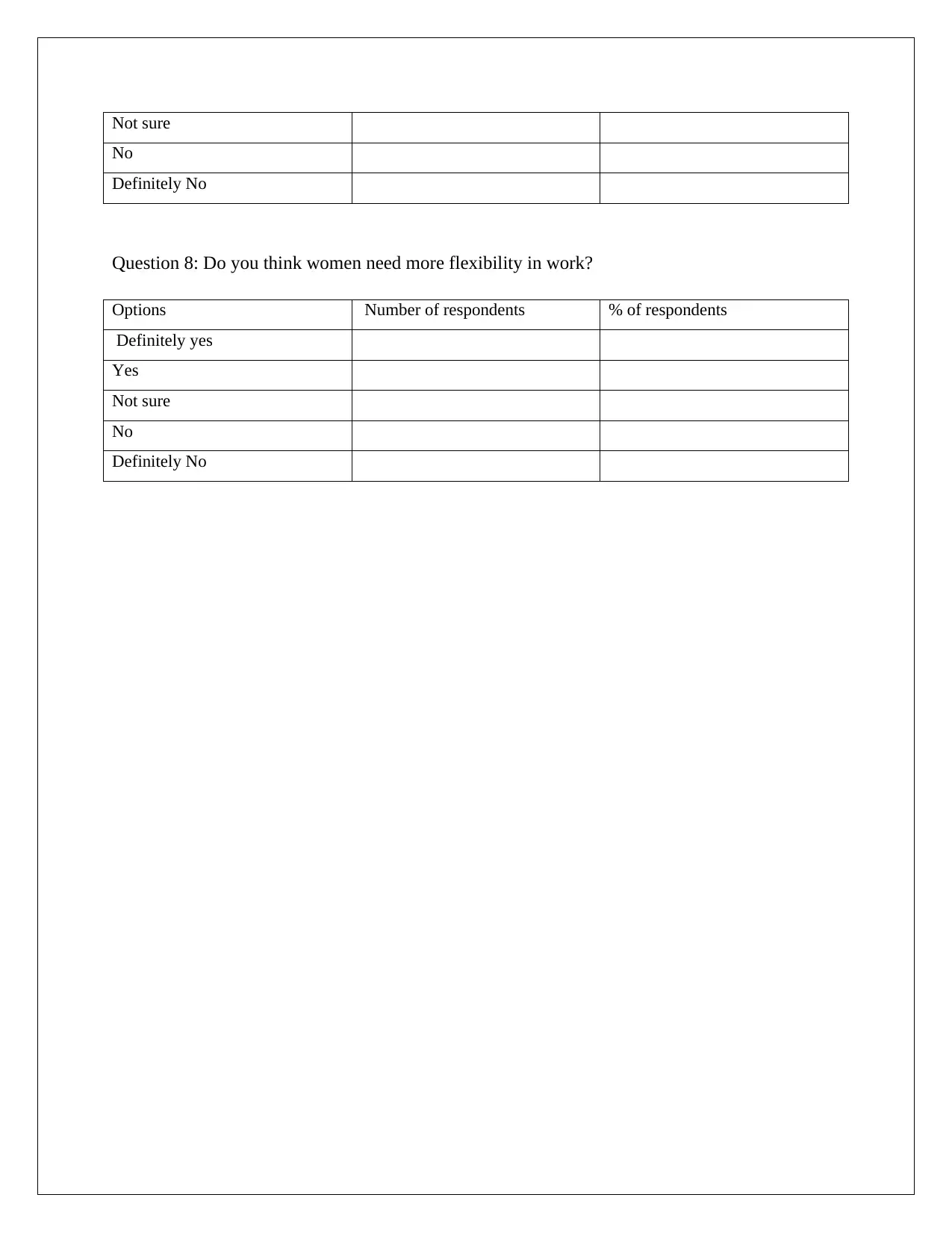
Not sure
No
Definitely No
Question 8: Do you think women need more flexibility in work?
Options Number of respondents % of respondents
Definitely yes
Yes
Not sure
No
Definitely No
No
Definitely No
Question 8: Do you think women need more flexibility in work?
Options Number of respondents % of respondents
Definitely yes
Yes
Not sure
No
Definitely No
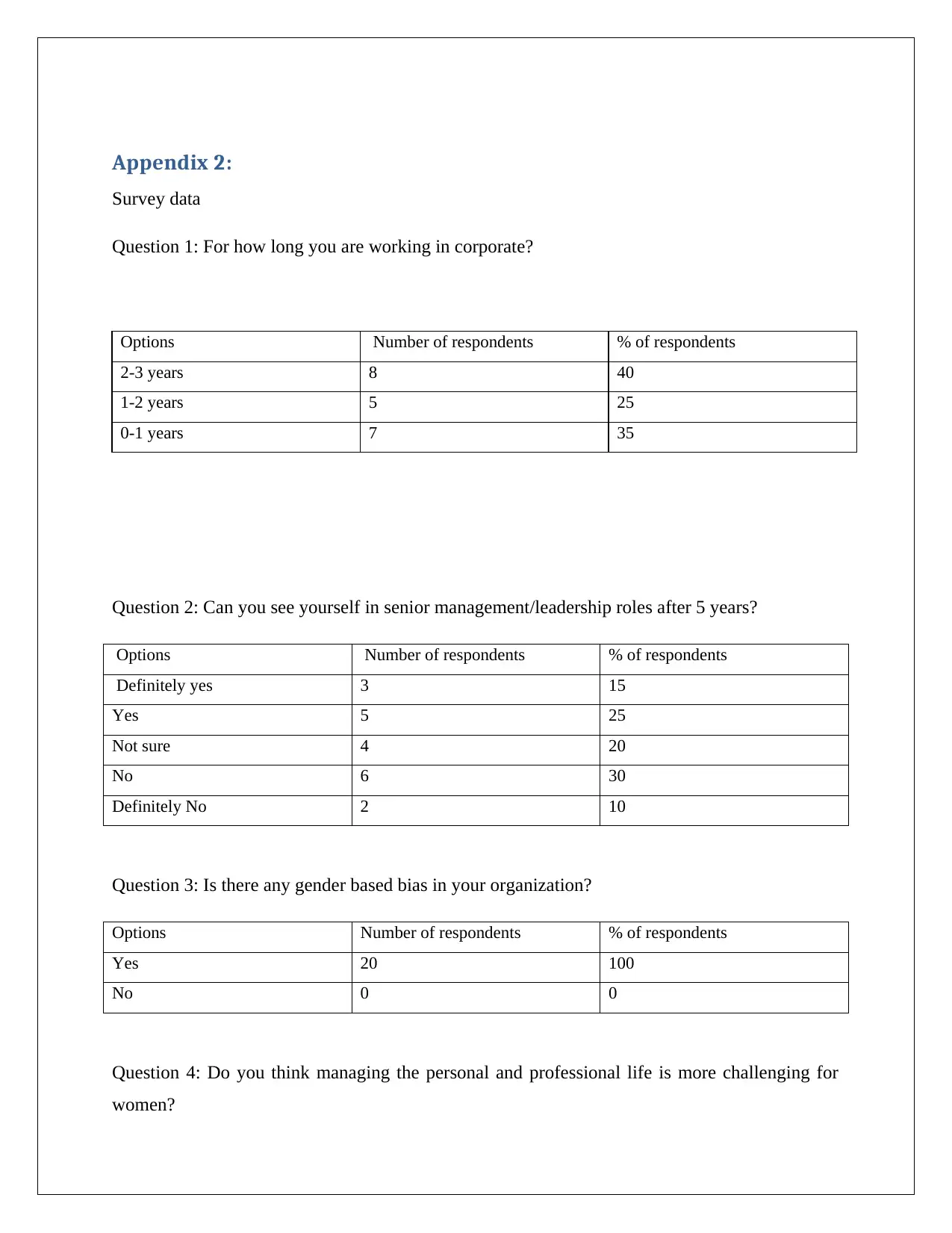
Appendix 2:
Survey data
Question 1: For how long you are working in corporate?
Options Number of respondents % of respondents
2-3 years 8 40
1-2 years 5 25
0-1 years 7 35
Question 2: Can you see yourself in senior management/leadership roles after 5 years?
Options Number of respondents % of respondents
Definitely yes 3 15
Yes 5 25
Not sure 4 20
No 6 30
Definitely No 2 10
Question 3: Is there any gender based bias in your organization?
Options Number of respondents % of respondents
Yes 20 100
No 0 0
Question 4: Do you think managing the personal and professional life is more challenging for
women?
Survey data
Question 1: For how long you are working in corporate?
Options Number of respondents % of respondents
2-3 years 8 40
1-2 years 5 25
0-1 years 7 35
Question 2: Can you see yourself in senior management/leadership roles after 5 years?
Options Number of respondents % of respondents
Definitely yes 3 15
Yes 5 25
Not sure 4 20
No 6 30
Definitely No 2 10
Question 3: Is there any gender based bias in your organization?
Options Number of respondents % of respondents
Yes 20 100
No 0 0
Question 4: Do you think managing the personal and professional life is more challenging for
women?
Secure Best Marks with AI Grader
Need help grading? Try our AI Grader for instant feedback on your assignments.
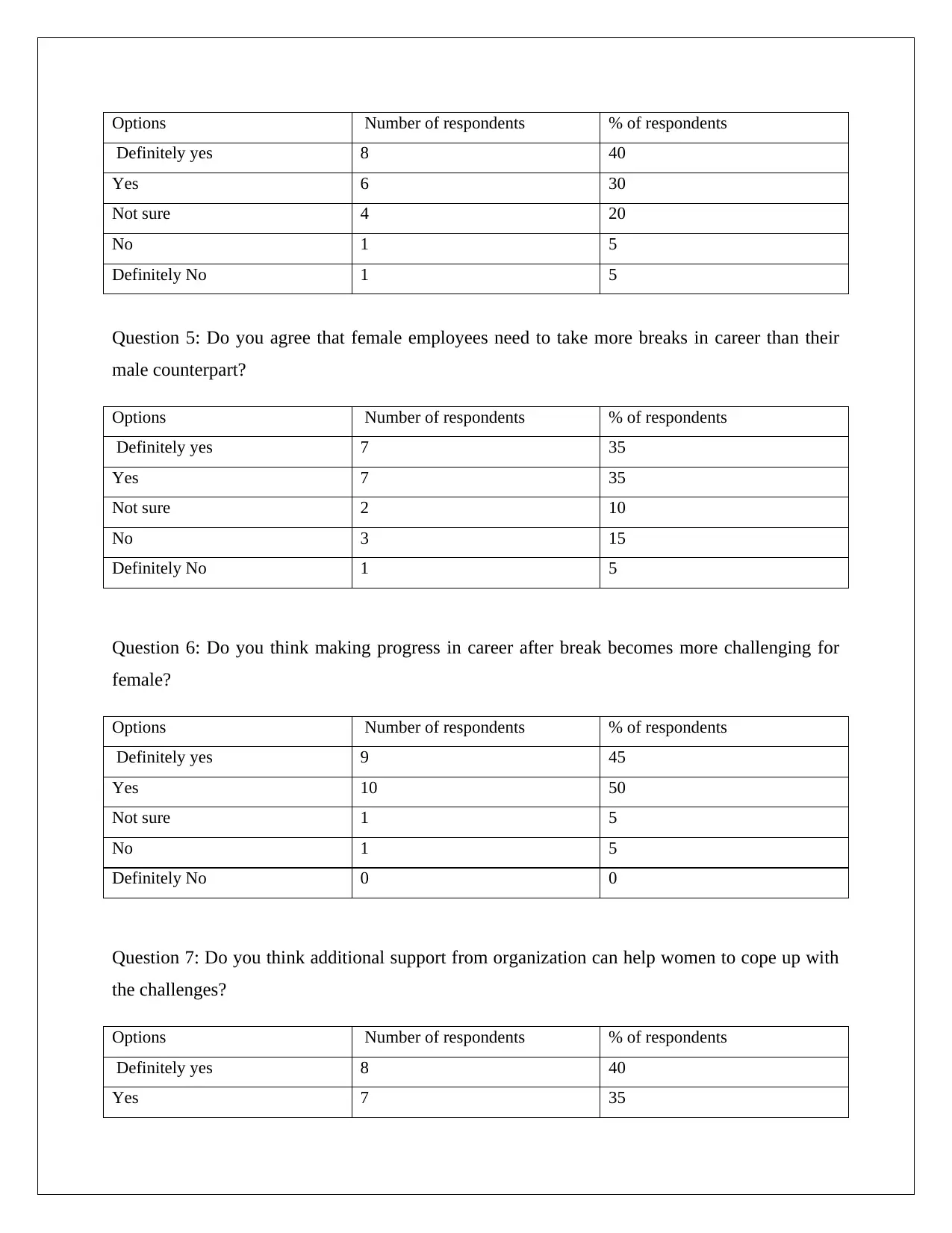
Options Number of respondents % of respondents
Definitely yes 8 40
Yes 6 30
Not sure 4 20
No 1 5
Definitely No 1 5
Question 5: Do you agree that female employees need to take more breaks in career than their
male counterpart?
Options Number of respondents % of respondents
Definitely yes 7 35
Yes 7 35
Not sure 2 10
No 3 15
Definitely No 1 5
Question 6: Do you think making progress in career after break becomes more challenging for
female?
Options Number of respondents % of respondents
Definitely yes 9 45
Yes 10 50
Not sure 1 5
No 1 5
Definitely No 0 0
Question 7: Do you think additional support from organization can help women to cope up with
the challenges?
Options Number of respondents % of respondents
Definitely yes 8 40
Yes 7 35
Definitely yes 8 40
Yes 6 30
Not sure 4 20
No 1 5
Definitely No 1 5
Question 5: Do you agree that female employees need to take more breaks in career than their
male counterpart?
Options Number of respondents % of respondents
Definitely yes 7 35
Yes 7 35
Not sure 2 10
No 3 15
Definitely No 1 5
Question 6: Do you think making progress in career after break becomes more challenging for
female?
Options Number of respondents % of respondents
Definitely yes 9 45
Yes 10 50
Not sure 1 5
No 1 5
Definitely No 0 0
Question 7: Do you think additional support from organization can help women to cope up with
the challenges?
Options Number of respondents % of respondents
Definitely yes 8 40
Yes 7 35
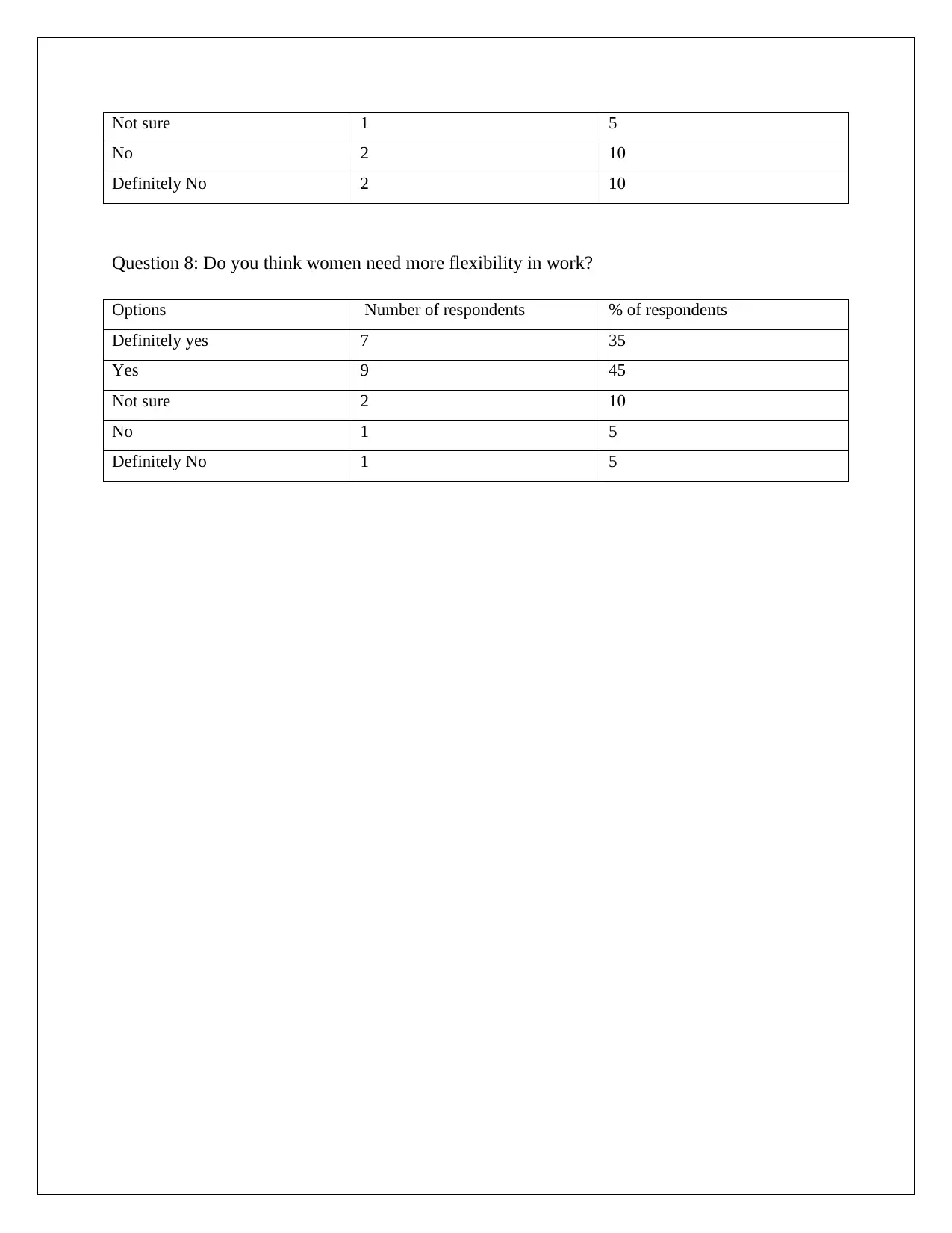
Not sure 1 5
No 2 10
Definitely No 2 10
Question 8: Do you think women need more flexibility in work?
Options Number of respondents % of respondents
Definitely yes 7 35
Yes 9 45
Not sure 2 10
No 1 5
Definitely No 1 5
No 2 10
Definitely No 2 10
Question 8: Do you think women need more flexibility in work?
Options Number of respondents % of respondents
Definitely yes 7 35
Yes 9 45
Not sure 2 10
No 1 5
Definitely No 1 5
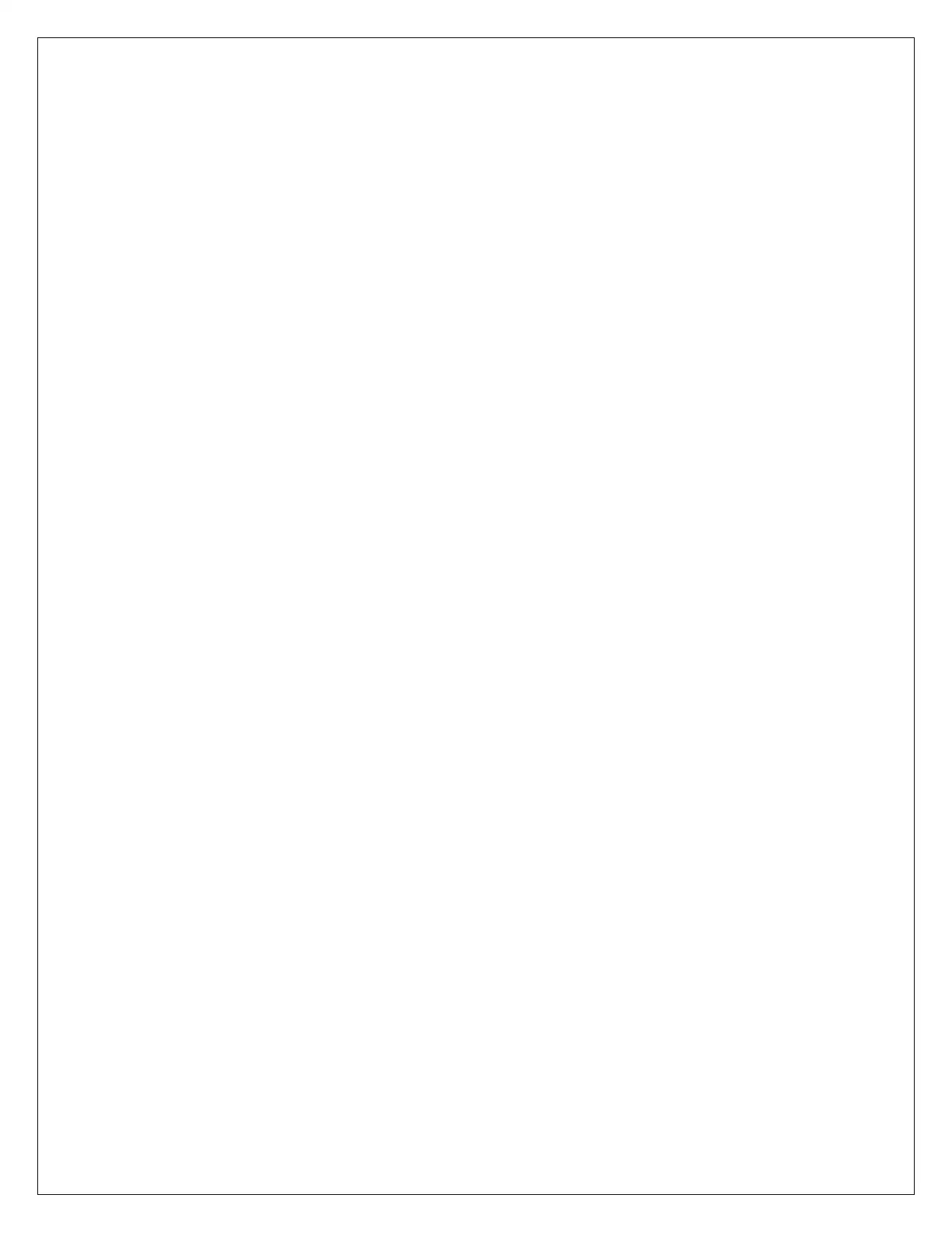
1 out of 55
Related Documents
Your All-in-One AI-Powered Toolkit for Academic Success.
+13062052269
info@desklib.com
Available 24*7 on WhatsApp / Email
![[object Object]](/_next/static/media/star-bottom.7253800d.svg)
Unlock your academic potential
© 2024 | Zucol Services PVT LTD | All rights reserved.





